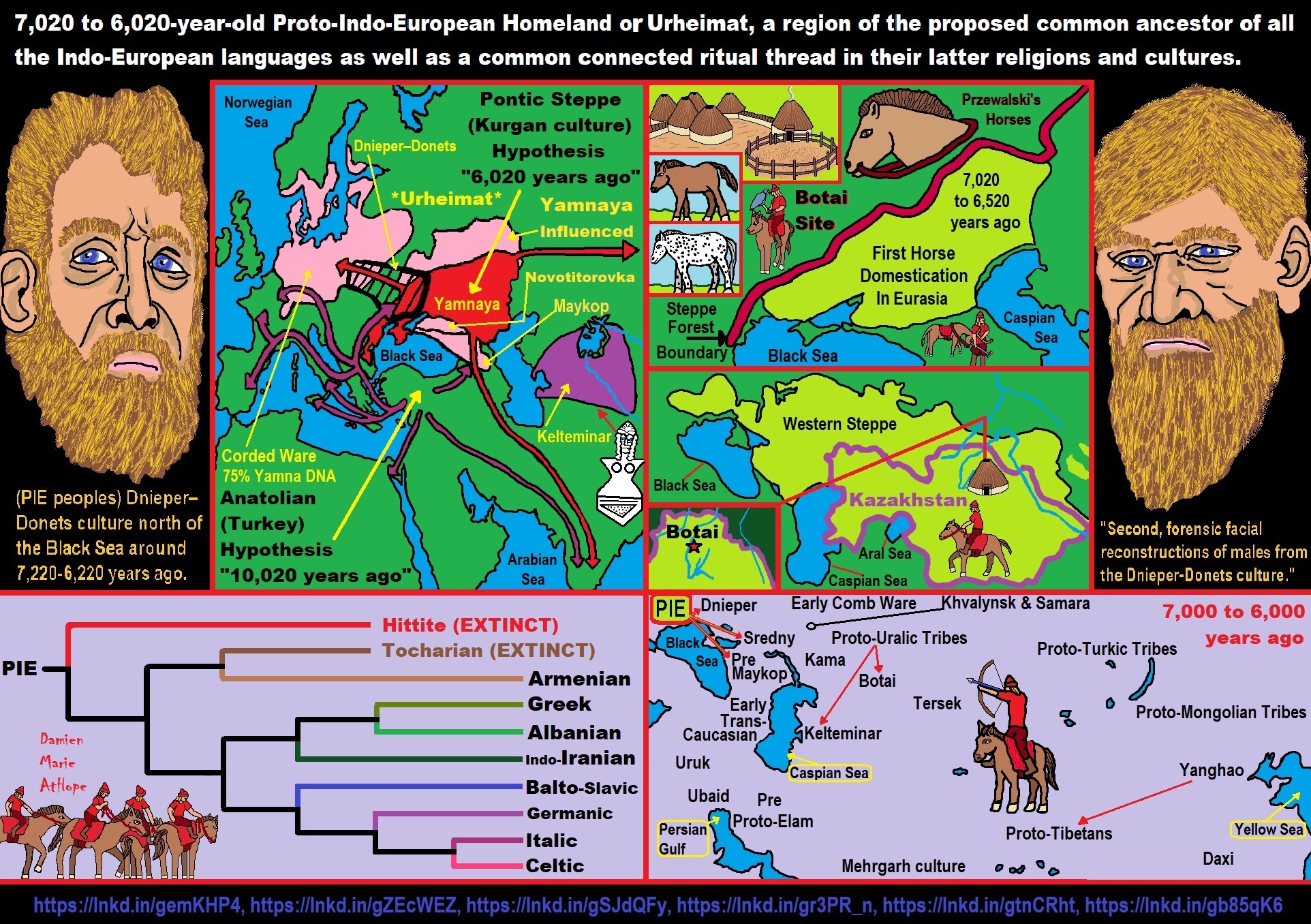
Paganism 12,000-4,000 years old
12,000-7,000 years old: related to (Pre-Capitalism)
7,000-5,000 years old: related to (Capitalism) (World War 0) Elite and their slaves!
5,000 years old: related to (Kings and the Rise of the State)
4,000 years old: related to (First Moralistic gods, then the Origin time of Monotheism)
“Proto-Indo-European: A person who spoke the Proto-Indo-European language and/or the reconstructed ancestor language or proto-language of the Indo-European family of languages, which includes most European, Iranian, and Indian languages.” ref
Proto-Indo-Europeans
“The Proto-Indo-Europeans are a hypothetical prehistoric population of Eurasia who spoke Proto-Indo-European (PIE), the ancestor of the Indo-European languages according to linguistic reconstruction. Knowledge of them comes chiefly from that linguistic reconstruction, along with material evidence from archaeology and archaeogenetics. The Proto-Indo-Europeans likely lived during the late Neolithic, or roughly the 4th millennium BCE. Mainstream scholarship places them in the Pontic–Caspian steppe zone in Eurasia (present-day Ukraine and southern Russia). Some archaeologists would extend the time depth of PIE to the middle Neolithic (5500 to 4500 BCE) or even the early Neolithic (7500 to 5500 BCE) and suggest alternative location hypotheses. By the early second millennium BCE, descendants of the Proto-Indo-Europeans had reached far and wide across Eurasia, including Anatolia (Hittites), the Aegean (the linguistic ancestors of Mycenaean Greece), the north of Europe (Corded Ware culture), the edges of Central Asia (Yamnaya culture), and southern Siberia (Afanasievo culture).” ref
“In the words of philologist Martin L. West, “If there was an Indo-European language, it follows that there was a people who spoke it: not a people in the sense of a nation, for they may never have formed a political unity, and not a people in any racial sense, for they may have been as genetically mixed as any modern population defined by language. If our language is a descendant of theirs, that does not make them ‘our ancestors’, any more than the ancient Romans are the ancestors of the French, the Romanians, and the Brazilians. The Indo-Europeans were a people in the sense of a linguistic community. We should probably think of them as a loose network of clans and tribes, inhabiting a coherent territory of limited size.” While ‘Proto-Indo-Europeans’ is used in scholarship to designate the group of speakers associated with the reconstructed proto-language and culture, the term ‘Indo-Europeans’ may refer to any historical people that speak an Indo-European language.” ref
“Using linguistic reconstruction from old Indo-European languages such as Latin and Sanskrit, hypothetical features of the Proto-Indo-European language are deduced. Assuming that these linguistic features reflect the culture and environment of the Proto-Indo-Europeans, the following cultural and environmental traits are widely proposed:
- pastoralism, including domesticated cattle, horses, and dogs
- agriculture and cereal cultivation, including technology commonly ascribed to late-Neolithic farming communities, e.g., the plow
- transportation by or across water
- the solid wheel, used for wagons, but not yet chariots with spoked wheels
- worship of a sky god, *Dyḗus Ph2tḗr (lit. “sky father”; > Vedic Sanskrit Dyáuṣ Pitṛ́, Ancient Greek Ζεύς (πατήρ) / Zeus (dyeus)), vocative *dyeu ph2ter (> Latin Iūpiter, Illyrian Deipaturos)
- oral heroic poetry or song lyrics that used stock phrases such as imperishable fame (*ḱléwos ń̥dʰgʷʰitom) and the wheel of the sun (*sh₂uens kʷekʷlos).
- a patrilineal kinship-system based on relationships between men” ref
“A 2016 phylogenetic analysis of Indo-European folktales found that one tale, The Smith and the Devil, could be confidently reconstructed to the Proto-Indo-European period. This story, found in contemporary Indo-European folktales from Scandinavia to India, describes a blacksmith who offers his soul to a malevolent being (commonly a devil in modern versions of the tale) in exchange for the ability to weld any kind of materials together. The blacksmith then uses his new ability to stick the devil to an immovable object (often a tree), thus avoiding his end of the bargain. According to the authors, the reconstruction of this folktale to PIE implies that the Proto-Indo-Europeans had metallurgy, which in turn “suggests a plausible context for the cultural evolution of a tale about a cunning smith who attains a superhuman level of mastery over his craft.” ref
“In the early 20th century, the question became associated with the expansion of a supposed “Aryan race“, a now-discredited theory promoted during the expansion of European empires and the rise of “scientific racism“. The question remains contentious within some flavors of ethnic nationalism (see also Indigenous Aryans). In regard to terminology, in the 19th and early 20th centuries, the term Aryan was used to refer to the Proto-Indo-Europeans and their descendants. However, Aryan more properly applies to the Indo-Iranians, the Indo-European branch that settled parts of the Middle East and South Asia, as only Indic and Iranian languages explicitly affirm the term as a self-designation referring to the entirety of their people, whereas the same Proto-Indo-European root (*aryo-) is the basis for Greek and Germanic word forms which seem only to denote the ruling elite of Proto-Indo-European (PIE) society.” ref
“In fact, the most accessible evidence available confirms only the existence of a common, but vague, socio-cultural designation of “nobility” associated with PIE society, such that Greek socio-cultural lexicon and Germanic proper names derived from this root remain insufficient to determine whether the concept was limited to the designation of an exclusive, socio-political elite, or whether it could possibly have been applied in the most inclusive sense to an inherent and ancestral “noble” quality which allegedly characterized all ethnic members of PIE society. Only the latter could have served as a true and universal self-designation for the Proto-Indo-European people. By the early twentieth century, this term had come to be widely used in a racist context referring to a hypothesized white, blonde, and blue-eyed “master race” (Herrenrasse), culminating with the pogroms of the Nazis in Europe. Subsequently, the term Aryan as a general term for Indo-Europeans has been largely abandoned by scholars (though the term Indo-Aryan is still used to refer to the branch that settled in Southern Asia).” ref
R1b and R1a DNA
“According to three autosomal DNA studies, haplogroups R1b and R1a, now the most common in Europe (R1a is also very common in South Asia) would have expanded from the Pontic steppes, along with the Indo-European languages; they also detected an autosomal component present in modern Europeans which was not present in Neolithic Europeans, which would have been introduced with paternal lineages R1b and R1a, as well as Indo-European languages. Studies that analyzed ancient human remains in Ireland and Portugal suggest that R1b was introduced in these places along with autosomal DNA from the Pontic steppes.” ref
R1a and R1a1a DNA
“The subclade R1a1a (R-M17 or R-M198) is most commonly associated with Indo-European speakers. Data so far collected indicate that there are two widely separated areas of high frequency, one in Eastern Europe, around Poland, Ukraine, and Russia, and the other in South Asia, around Indo-Gangetic Plain. The historical and prehistoric possible reasons for this are the subject of on-going discussion and attention amongst population geneticists and genetic genealogists, and are considered to be of potential interest to linguists and archaeologists also. A large, 2014 study by Underhill et al., using 16,244 individuals from over 126 populations from across Eurasia, concluded there was compelling evidence, that R1a-M420 originated in the vicinity of Iran. The mutations that characterize haplogroup R1a occurred ~10,000 years ago. Its defining mutation (M17) occurred about 10,000 to 14,000 years ago. Pamjav et al. (2012) believe that R1a originated and initially diversified either within the Eurasian Steppes or the Middle East and Caucasus region.” ref
“All Yamnaya individuals sampled by Haak et al. (2015) belonged to the Y-haplogroup R1b. Based on these findings and by equating the people of the Yamnaya culture with the Proto-Indo-Europeans, David W. Anthony (2019) suggests that the Proto-Indo-European language formed mainly from a base of languages spoken by Eastern European hunter-gathers with influences from languages of northern Caucasus hunter-gatherers, in addition to a possible later influence from the language of the Maikop culture to the south (which is hypothesized to have belonged to the North Caucasian family) in the later neolithic or Bronze Age involving little genetic impact. According to Jones et al. (2015) and Haak et al. (2015), autosomal tests indicate that the Yamnaya-people were the result of admixture between “Eastern Hunter-Gatherers” from eastern Europe (EHG) and “Caucasus hunter-gatherers” (CHG). Each of those two populations contributed about half the Yamnaya DNA.” ref
“According to Haak et al. (2015), “Eastern European hunter-gatherers” who inhabited Russia were a distinctive population of hunter-gatherers with high affinity to a ~24,000-year-old Siberian from the Mal’ta-Buret’ culture, or other, closely related Ancient North Eurasian (ANE) people from Siberia and to the Western Hunter-Gatherers (WHG). Remains of the “Eastern European hunter-gatherers” have been found in Mesolithic or early Neolithic sites in Karelia and Samara Oblast, Russia, and put under analysis. Three such hunter-gathering individuals of the male sex have had their DNA results published. Each was found to belong to a different Y-DNA haplogroup: R1a, R1b, and J. R1b is also the most common Y-DNA haplogroup found among both the Yamnaya and modern-day Western Europeans. R1a is more common in Eastern Europeans and in the northern parts of the Indian subcontinent. The Near East population were most likely hunter-gatherers from the Caucasus (CHG) c.q. Iran Chalcolithic-related people with a major CHG-component.” ref
Jones et al. (2015) analyzed genomes from males from western Georgia, in the Caucasus, from the Late Upper Palaeolithic (13,300 years old) and the Mesolithic (9,700 years old). These two males carried Y-DNA haplogroup: J* and J2a. The researchers found that these Caucasus hunters were probably the source of the farmer-like DNA in the Yamnaya, as the Caucasians were distantly related to the Middle Eastern people who introduced farming in Europe. According to Lazaridis et al. (2016), “a population related to the people of the Iran Chalcolithic contributed ~43% of the ancestry of early Bronze Age populations of the steppe.” According to Lazaridis et al. (2016), these Iranian Chalcolithic people were a mixture of “the Neolithic people of western Iran, the Levant, and Caucasus Hunter Gatherers.” Lazaridis et al. (2016) also note that farming spread at two places in the Near East, namely the Levant and Iran, from where it spread, Iranian people spreading to the steppe and south Asia.” ref
Proto-Indo-European language
“Proto-Indo-European (PIE) is the reconstructed common ancestor of the Indo-European language family. No direct record of Proto-Indo-European exists; its proposed features have been derived by linguistic reconstruction from documented Indo-European languages. Far more work has gone into reconstructing PIE than any other proto-language, and it is the best understood of all proto-languages of its age. The majority of linguistic work during the 19th century was devoted to the reconstruction of PIE or its daughter languages, and many of the modern techniques of linguistic reconstruction (such as the comparative method) were developed as a result. PIE is hypothesized to have been spoken as a single language from approximately 4500 BCE to 2500 BCE during the Late Neolithic to Early Bronze Age, though estimates vary by more than a thousand years. According to the prevailing Kurgan hypothesis, the original homeland of the Proto-Indo-Europeans may have been in the Pontic–Caspian steppe of eastern Europe. The linguistic reconstruction of PIE has provided insight into the pastoral culture and patriarchal religion of its speakers. No direct evidence of PIE exists; scholars have reconstructed PIE from its present-day descendants using the comparative method.” ref
“As speakers of Proto-Indo-European became isolated from each other through the Indo-European migrations, the regional dialects of Proto-Indo-European spoken by the various groups diverged, as each dialect underwent shifts in pronunciation (the Indo-European sound laws), morphology, and vocabulary. Over many centuries, these dialects transformed into the known ancient Indo-European languages. From there, further linguistic divergence led to the evolution of their current descendants, the modern Indo-European languages. Today, the descendant languages of PIE with the most native speakers are Spanish, English, Portuguese, Hindustani (Hindi and Urdu), Bengali, Russian, Punjabi, German, Persian, French, Marathi, Italian, and Gujarati. PIE is believed to have had an elaborate system of morphology that included inflectional suffixes (analogous to English child, child’s, children, children’s) as well as ablaut (vowel alterations, as preserved in English sing, sang, sung, song) and accent. PIE nominals and pronouns had a complex system of declension, and verbs similarly had a complex system of conjugation. The PIE phonology, particles, numerals, and copula are also well-reconstructed.” ref
“The Anatolian hypothesis, which posits that PIE spread out from Anatolia with agriculture beginning c. 7500–6000 BCE and the Kurgan hypothesis, 4000 to 1000 BCE proposes that the original speakers of PIE were the Yamnaya culture associated with the kurgans (burial mounds) on the Pontic–Caspian steppe north of the Black Sea. The earliest (Kurgan I) included the Samara and Seroglazovo cultures of the Dnieper–Volga region in the Copper Age (early 4th millennium BCE).” ref
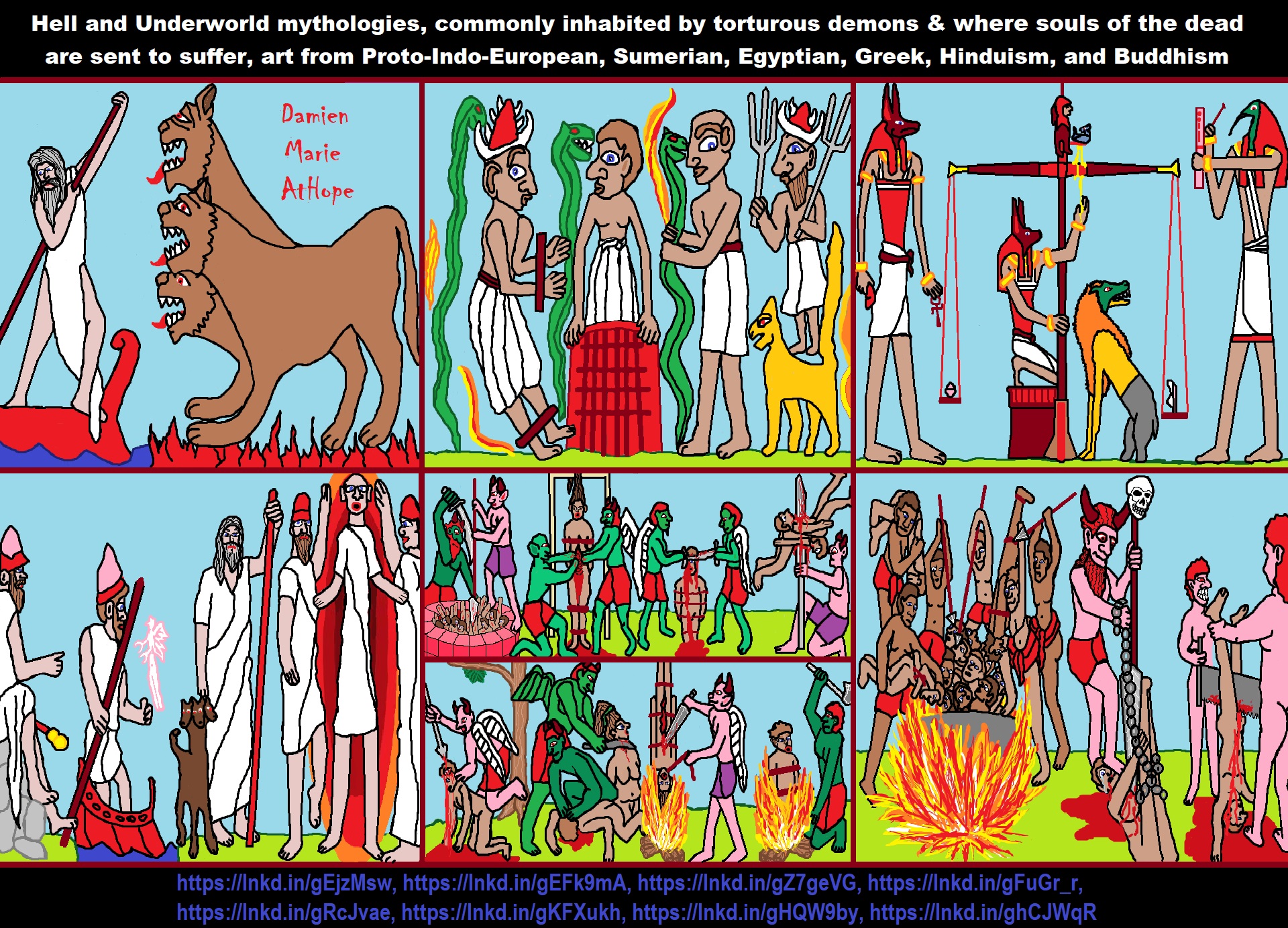
Proto-Indo-European mythology
“Proto-Indo-European mythology is the body of myths and deities associated with the Proto-Indo-Europeans, speakers of the hypothesized Proto-Indo-European language. Although the mythological motifs are not directly attested – since Proto-Indo-European speakers lived in preliterate societies – scholars of comparative mythology have reconstructed details from inherited similarities found among Indo-European languages, based on the assumption that parts of the Proto-Indo-Europeans’ original belief systems survived in the daughter traditions. The Proto-Indo-European pantheon includes a number of securely reconstructed deities, since they are both cognates – linguistic siblings from a common origin – and associated with similar attributes and body of myths: such as *Dyḗws Ph₂tḗr, the daylight-sky god; his consort *Dʰéǵʰōm, the earth mother; his daughter *H₂éwsōs, the dawn goddess; his sons the Divine Twins; and *Seh₂ul, a solar goddess. Some deities, like the weather god *Perkʷunos or the herding-god *Péh₂usōn, are only attested in a limited number of traditions – Western (i.e. European) and Graeco-Aryan, respectively – and could therefore represent late additions that did not spread throughout the various Indo-European dialects.” ref
“Some myths are also securely dated to Proto-Indo-European times, since they feature both linguistic and thematic evidence of an inherited motif: a story portraying a mythical figure associated with thunder and slaying a multi-headed serpent to release torrents of water that had previously been pent up; a creation myth involving two brothers, one of whom sacrifices the other in order to create the world; and probably the belief that the Otherworld was guarded by a watchdog and could only be reached by crossing a river. Various schools of thought exist regarding possible interpretations of the reconstructed Proto-Indo-European mythology. The main mythologies used in comparative reconstruction are Indo-Iranian, Baltic, Roman, and Norse, often supported with evidence from the Celtic, Greek, Slavic, Hittite, Armenian, Illyrian, and Albanian traditions as well.” ref
“The mythology of the Proto-Indo-Europeans is not directly attested and it is difficult to match their language to archaeological findings related to any specific culture from the Chalcolithic. Nonetheless, scholars of comparative mythology have attempted to reconstruct aspects of Proto-Indo-European mythology based on the existence of linguistic and thematic similarities among the deities, religious practices, and myths of various Indo-European peoples. This method is known as the comparative method. Different schools of thought have approached the subject of Proto-Indo-European mythology from different angles.” ref
“One of the earliest attested and thus one of the most important of all Indo-European mythologies is Vedic mythology, especially the mythology of the Rigveda, the oldest of the Vedas. Early scholars of comparative mythology such as Friedrich Max Müller stressed the importance of Vedic mythology to such an extent that they practically equated it with Proto-Indo-European myths. Modern researchers have been much more cautious, recognizing that, although Vedic mythology is still central, other mythologies must also be taken into account. Another of the most important source mythologies for comparative research is Roman mythology. The Romans possessed a very complex mythological system, parts of which have been preserved through the characteristic Roman tendency to rationalize their myths into historical accounts. Despite its relatively late attestation, Norse mythology is still considered one of the three most important of the Indo-European mythologies for comparative research, due to the vast bulk of surviving Icelandic material.” ref
“Baltic mythology has also received a great deal of scholarly attention, as it is linguistically the most conservative and archaic of all surviving branches, but has so far remained frustrating to researchers because the sources are so comparatively late. Nonetheless, Latvian folk songs are seen as a major source of information in the process of reconstructing Proto-Indo-European myth. Despite the popularity of Greek mythology in western culture, Greek mythology is generally seen as having little importance in comparative mythology due to the heavy influence of Pre-Greek and Near Eastern cultures, which overwhelms what little Indo-European material can be extracted from it. Consequently, Greek mythology received minimal scholarly attention until the first decade of the 21st century. Although Scythians are considered relatively conservative in regards to Proto-Indo-European cultures, retaining a similar lifestyle and culture, their mythology has very rarely been examined in an Indo-European context and infrequently discussed in regards to the nature of the ancestral Indo-European mythology. At least three deities, Tabiti, Papaios, and Api, are generally interpreted as having Indo-European origins, while the remaining have seen more disparate interpretations. Influence from Siberian, Turkic, and even Near Eastern beliefs, on the other hand, are more widely discussed in the literature.” ref
Proto-Indo-European Cosmology
“There was a fundamental opposition between the never-aging gods dwelling above in the skies and the mortal humans living beneath on earth. The earth *dʰéǵʰōm was perceived as a vast, flat and circular continent surrounded by waters (“the Ocean”). Although they may sometimes be identified with mythical figures or stories, the stars (*h₂stḗr) were not bound to any particular cosmic significance and were perceived as ornamental more than anything else. According to Martin L. West, the idea of the world-tree (axis mundi) is probably a later import from north Asiatic cosmologies: “The Greek myth might be derived from the Near East, and the Indic and Germanic ideas of a pillar from the shamanistic cosmologies of the Finnic and other peoples of central and northern Asia. David A. Leeming also notes that the concept of the Cosmic Egg, symbolizing the primordial state from which the universe arises, is found in many Indo-European creation myths.” ref
“Lincoln reconstructs a creation myth involving twin brothers, *Manu- (“Man”) and *Yemo- (“Twin”), as the progenitors of the world and humankind, and a hero named *Trito (“Third”) who ensured the continuity of the original sacrifice. Regarding the primordial state that may have preceded the creation process, West notes that the Vedic, Norse and, at least partially, the Greek traditions give evidence of an era when the cosmological elements were absent, with similar formula insisting on their non-existence: “neither non-being was nor being was at that time; there was not the air, nor the heaven beyond it” (Rigveda), “there was not sand nor sea nor the cool waves; earth was nowhere nor heaven above; Ginnunga Gap there was, but grass nowhere” (Völuspá), “there was Chasm and Night and dark Erebos at first, and broad Tartarus, but earth nor air nor heaven there was” (The Birds).” ref
“In the creation myth, the first man Manu and his giant twin Yemo are crossing the cosmos, accompanied by the primordial cow. To create the world, Manu sacrifices his brother and, with the help of heavenly deities (the Sky-Father, the Storm-God, and the Divine Twins), forges both the natural elements and human beings from his remains. Manu thus becomes the first priest after initiating sacrifice as the primordial condition for the world order, and his deceased brother Yemo the first king as social classes emerge from his anatomy (priesthood from his head, the warrior class from his breast and arms, and the commoners from his sexual organs and legs). Although the European and Indo-Iranian versions differ on this matter, Lincoln argues that the primeval cow was most likely sacrificed in the original myth, giving birth to the other animals and vegetables, since the pastoral way of life of Proto-Indo-Iranian speakers was closer to that of Proto-Indo-European speakers.” ref
“To the third man Trito, the celestial gods then offer cattle as a divine gift, which is stolen by a three-headed serpent named *Ngʷhi (“serpent”; and the Indo-European root for negation). Trito first suffers at his hands, but the hero eventually manages to overcome the monster, fortified by an intoxicating drink and aided by the Sky-Father. He eventually gives the recovered cattle back to a priest for it to be properly sacrificed. Trito is now the first warrior, maintaining through his heroic actions the cycle of mutual giving between gods and mortals. According to Lincoln, Manu and Yemo seem to be the protagonists of “a myth of the sovereign function, establishing the model for later priests and kings”, while the legend of Trito should be interpreted as “a myth of the warrior function, establishing the model for all later men of arms”. The myth indeed recalls the Dumézilian tripartition of the cosmos between the priest (in both his magical and legal aspects), the warrior (the Third Man), and the herder (the cow).” ref
“The story of Trito served as a model for later cattle raiding epic myths and most likely as a moral justification for the practice of raiding among Indo-European peoples. In the original legend, Trito is only taking back what rightfully belongs to his people, those who sacrifice properly to the gods. The myth has been interpreted either as a cosmic conflict between the heavenly hero and the earthly serpent, or as an Indo-European victory over non-Indo-European people, the monster symbolizing the aboriginal thief or usurper. Some scholars have proposed that the primeval being Yemo was depicted as a two-fold hermaphrodite rather than a twin brother of Manu, both forming indeed a pair of complementary beings entwined together. The Germanic names Ymir and Tuisto were understood as twin, bisexual or hermaphrodite, and some myths give a sister to the Vedic Yama, also called Twin and with whom incest is discussed. In this interpretation, the primordial being may have self-sacrificed, or have been divided in two, a male half and a female half, embodying a prototypal separation of the sexes.” ref
“Cognates deriving from the Proto-Indo-European First Priest *Manu (“Man“, “ancestor of mankind”) include the Indic Manu, legendary first man in Hinduism, and Manāvī, his sacrificed wife; the Germanic Mannus (PGmc *Mannaz), mythical ancestor of the West Germanic tribes; and the Persian Manūščihr (from Aves. Manūš.čiθra), a Zoroastrian high priest of the 9th century CE. From the name of the sacrificed First King *Yemo (“Twin”) derive the Indic Yama, god of death and the underworld; the Avestan Yima, king of the golden age and guardian of hell; the Norse Ymir (from PGmc *Jumijaz), ancestor of the giants (jötnar); and most likely Remus (from Proto-Latin *Yemos or *Yemonos, with the initial y– shifting to r– under the influence of Rōmulus), killed in the Roman foundation myth by his twin brother Romulus. Cognates stemming from the First Warrior *Trito (“Third”) include the Vedic Trita, the Avestan Thrita, and the Norse þriði.” ref
“Many Indo-European beliefs explain the origin of natural elements as the result of the original dismemberment of Yemo: his flesh usually becomes the earth, his hair grass, his bone yields stone, his blood water, his eyes the sun, his mind the moon, his brain the clouds, his breath the wind, and his head the heavens. The traditions of sacrificing an animal to disperse its parts according to socially established patterns, a custom found in Ancient Rome and India, has been interpreted as an attempt to restore the balance of the cosmos ruled by the original sacrifice. The motif of Manu and Yemo has been influential throughout Eurasia following the Indo-European migrations. The Greek, Old Russian (Poem on the Dove King), and Jewish versions depend on the Iranian, and a Chinese version of the myth has been introduced from Ancient India. The Armenian version of the myth of the First Warrior Trito depends on the Iranian, and the Roman reflexes were influenced by earlier Greek versions.” ref
“Linguistic evidence has led scholars to reconstruct the concept of *h₂értus, denoting ‘what is fitting, rightly ordered’, and ultimately deriving from the verbal root *h₂er-, ‘to fit’. Descendant cognates include Hittite āra (‘right, proper’); Sanskrit ṛta (‘divine/cosmic law, force of truth, or order’); Avestan arəta- (‘order’); Greek artús (‘arrangement’), possibly arete (‘excellence’) via the root *h₂erh₁ (‘please, satisfy’); Latin artus (‘joint’); Tocharian A ārtt- (‘to praise, be pleased with’); Armenian ard (‘ornament, shape’); Middle High German art (‘innate feature, nature, fashion’).” ref
“Interwoven with the root *h₂er- (‘to fit’) is the verbal root *dʰeh₁-, which means ‘to put, lay down, establish’, but also ‘speak, say; bring back’. The Greek thémis and the Sanskrit dhāman both derive from the PIE noun for the ‘Law’, *dʰeh₁-men-, literally ‘that which is established’. This notion of ‘Law’ includes an active principle, denoting an activity in obedience to the cosmic order *h₂értus, which in a social context is interpreted as a lawful conduct: in the Greek daughter culture, the titaness Themis personifies the cosmic order and the rules of lawful conduct which derived from it, and the Vedic code of lawful conduct, the Dharma, can also be traced back to the PIE root *dʰeh₁-.” ref
“According to Martin L. West, the root *dʰeh₁- also denotes a divine or cosmic creation, as attested by the Hittite expression nēbis dēgan dāir (“established heaven (and) earth”), the Young Avestan formula kə huvāpå raocåscā dāt təmåscā? (“What skilful artificer made the regions of light and dark?”), the name of the Vedic creator god Dhātr, and possibly by the Greek nymph Thetis, presented as a demiurgical goddess in Alcman‘s poetry. Another root *yew(e)s- appears to be connected with ritualistic laws, as suggested by the Latin iūs (‘law, right, justice, duty’), Avestan yaož-dā- (‘make ritually pure’), and Sanskrit śáṃca yóśca (‘health and happiness’), with a derived adjective *yusi(iy)os seen in Old Irish uisse (‘just right, fitting’) and possibly Old Church Slavonic istǔ (‘actual, true’).” ref
“The realm of death was generally depicted as the Lower Darkness and the land of no return. Many Indo-European myths relate a journey across a river, guided by an old man (*ǵerh₂ont-), in order to reach the Otherworld. The Greek tradition of the dead being ferried across the river Styx by Charon is probably a reflex of this belief, and the idea of crossing a river to reach the Underworld is also present throughout Celtic mythologies. Several Vedic texts contain references to crossing a river (river Vaitarna) in order to reach the land of the dead, and the Latin word tarentum (“tomb”) originally meant “crossing point”. In Norse mythology, Hermóðr must cross a bridge over the river Giöll in order to reach Hel and, in Latvian folk songs, the dead must cross a marsh rather than a river. Traditions of placing coins on the bodies of the deceased in order to pay the ferryman are attested in both ancient Greek and early modern Slavic funerary practices; although the earliest coins date to the Iron Age, this may provide evidence of an ancient tradition of giving offerings to the ferryman.” ref
“In a recurrent motif, the Otherworld contains a gate, generally guarded by a multi-headed (sometimes multi-eyed) dog who could also serve as a guide and ensured that the ones who entered could not get out. The Greek Cerberus and the Hindu Śárvara most likely derive from the common noun *Ḱérberos (“spotted”). Bruce Lincoln has proposed a third cognate in the Norse Garmr, although this has been debated as linguistically untenable. Several traditions reveal traces of a Proto-Indo-European eschatological myth that describes the end of the world following a cataclysmic battle. The story begins when an archdemon, usually coming from a different and inimical paternal line, assumes the position of authority among the community of the gods or heroes (Norse Loki, Roman Tarquin, Irish Bres).” ref
“The subjects are treated unjustly by the new ruler, forced to erect fortifications while the archdemon favours instead outsiders, on whom his support relies. After a particularly heinous act, the archdemon is exiled by his subjects and takes refuge among his foreign relatives. A new leader (Norse Víðarr, Roman Lucius Brutus, Irish Lug), known as the “silent” one and usually the nephew or grandson (*népōt) of the exiled archdemon, then springs up and the two forces come together to annihilate each other in a cataclysmic battle. The myth ends with the interruption of the cosmic order and the conclusion of a temporal cyclic era. In the Norse and Iranian traditions, a cataclysmic “cosmic winter” precedes the final battle.” ref
“In the cosmological model proposed by Jean Haudry, the Proto-Indo-European sky is composed of three “heavens” (diurnal, nocturnal and liminal) rotating around an axis mundi, each having its own deities, social associations and colors (white, dark and red, respectively). Deities of the diurnal sky could not transgress the domain of the nocturnal sky, inhabited by its own sets of gods and by the spirits of the dead. For instance, Zeus cannot extend his power to the nightly sky in the Iliad. In this vision, the liminal or transitional sky embodies the gate or frontier (dawn and twilight) binding the two other heavens.” ref
“Proto-Indo-Europeans may have believed that the peripheral part of the earth was inhabited by a people exempt from the hardships and pains that affect us. The common motif is suggested by the legends of the Indic Śvetadvīpam (“White Island”), whose inhabitants shine white like the moon and need no food; the Greek Hyperborea (“Beyond the North Wind”), where the sun shines all the time and the men know “neither disease nor bitter old age”; the Irish Tír na nÓg (“Land of the Young”), a mythical region located in the western sea where “happiness lasts forever and there is no satiety”; or the Germanic Ódáinsakr (“Glittering Plains”), a land situated beyond the Ocean where “no one is permitted to die.” ref
Proto-Indo-European Deities See also: List of Proto-Indo-European deities
“The archaic Proto-Indo-European language (4500–4000 BCE) had a two-gender system which originally distinguished words between animate and inanimate, a system used to separate a common term from its deified synonym. For instance, fire as an active principle was *h₁n̥gʷnis (Latin ignis; Sanskrit Agní), while the inanimate, physical entity was *péh₂ur (Greek pyr; English fire). During this period, Proto-Indo-European beliefs were still animistic and their language did not yet make formal distinctions between masculine and feminine, although it is likely that each deity was already conceived as either male or female. Most of the goddesses attested in later Indo-European mythologies come from pre-Indo-European deities eventually assimilated into the various pantheons following the migrations, like the Greek Athena, the Roman Juno, the Irish Medb, or the Iranian Anahita. Diversely personified, they were frequently seen as fulfilling multiple functions, while Proto-Indo-European goddesses shared a lack of personification and narrow functionalities as a general characteristic. The most well-attested female Indo-European deities include *H₂éwsōs, the Dawn, *Dʰéǵʰōm, the Earth, and *Seh₂ul, the Sun.” ref
“It is not probable that the Proto-Indo-Europeans had a fixed canon of deities or assigned a specific number to them. The term for “a god” was *deywós (“celestial”), derived from the root *dyew, which denoted the bright sky or the light of day. It has numerous reflexes in Latin deus, Old Norse Týr (< Germ. *tīwaz), Sanskrit devá, Avestan daeva, Irish día, or Lithuanian Dievas. In contrast, human beings were synonymous of “mortals” and associated with the “earthly” (*dʰéǵʰōm), likewise the source of words for “man, human being” in various languages. Proto-Indo-Europeans believed the gods to be exempt from death and disease because they were nourished by special aliments, usually not available to mortals: in the Chāndogya Upaniṣad, “the gods, of course, neither eat nor drink. They become sated by just looking at this nectar”, while the Edda tells us that “on wine alone the weapon-lord Odin ever lives … he needs no food; wine is to him both drink and meat”. Sometimes concepts could also be deified, such as the Avestan mazdā (“wisdom”), worshipped as Ahura Mazdā (“Lord Wisdom”); the Greek god of war Ares (connected with ἀρή, “ruin, destruction”); or the Vedic protector of treaties Mitráh (from mitrám, “contract”).” ref
“Gods had several titles, typically “the celebrated”, “the highest”, “king”, or “shepherd”, with the notion that deities had their own idiom and true names which might be kept secret from mortals in some circumstances. In Indo-European traditions, gods were seen as the “dispensers” or the “givers of good things” (*déh₃tōr h₁uesuom). Although certain individual deities were charged with the supervision of justice or contracts, in general, the Indo-European gods did not have an ethical character. Their immense power, which they could exercise at their pleasure, necessitated rituals, sacrifices, and praise songs from worshipers to ensure they would in return bestow prosperity to the community. The idea that gods were in control of the nature was translated in the suffix *-nos (feminine -nā), which signified “lord of”. According to West, it is attested in Greek Ouranos (“lord of rain”) and Helena (“mistress of sunlight”), Germanic *Wōðanaz (“lord of frenzy”), Gaulish Epona (“goddess of horses”), Lithuanian Perkūnas (“lord of oaks”), and in Roman Neptunus (“lord of waters”), Volcanus (“lord of fire-glare”) and Silvanus (“lord of woods”).” ref
“Linguists have been able to reconstruct the names of some deities in the Proto-Indo-European language (PIE) from many types of sources. Some of the proposed deity names are more readily accepted among scholars than others. According to philologist Martin L. West, “the clearest cases are the cosmic and elemental deities: the Sky-god, his partner Earth, and his twin sons; the Sun, the Sun Maiden, and the Dawn; gods of storm, wind, water, fire; and terrestrial presences such as the Rivers, spring and forest nymphs, and a god of the wild who guards roads and herds. The head deity of the Proto-Indo-European pantheon was the god *Dyḗws Ph₂tḗr, whose name literally means “Sky Father”. Regarded as the Sky or Day conceived as a divine entity, and thus the dwelling of the gods, the Heaven, Dyēus is, by far, the most well-attested of all the Proto-Indo-European deities. As the gateway to the gods and the father of both the Divine Twins and the goddess of the dawn (Hausos), Dyēws was a prominent deity in the pantheon. He was however likely not their ruler, or the holder of the supreme power like Zeus and Jupiter.” ref
“Due to his celestial nature, Dyēus is often described as “all-seeing”, or “with wide vision” in Indo-European myths. It is unlikely however that he was in charge of the supervision of justice and righteousness, as it was the case for the Zeus or the Indo-Iranian Mithra–Varuna duo; but he was suited to serve at least as a witness to oaths and treaties. The Greek god Zeus and the Roman god Jupiter both appear as the head gods of their respective pantheons. *Dyḗws Ph₂tḗr is also attested in the Rigveda as Dyáus Pitā, a minor ancestor figure mentioned in only a few hymns, and in the Illyrian god Dei-Pátrous, attested once by Hesychius of Alexandria. The ritual expressions Debess tēvs in Latvian and attas Isanus in Hittite are not exact descendants of the formula *Dyḗws Ph₂tḗr, but they do preserve its original structure.” ref
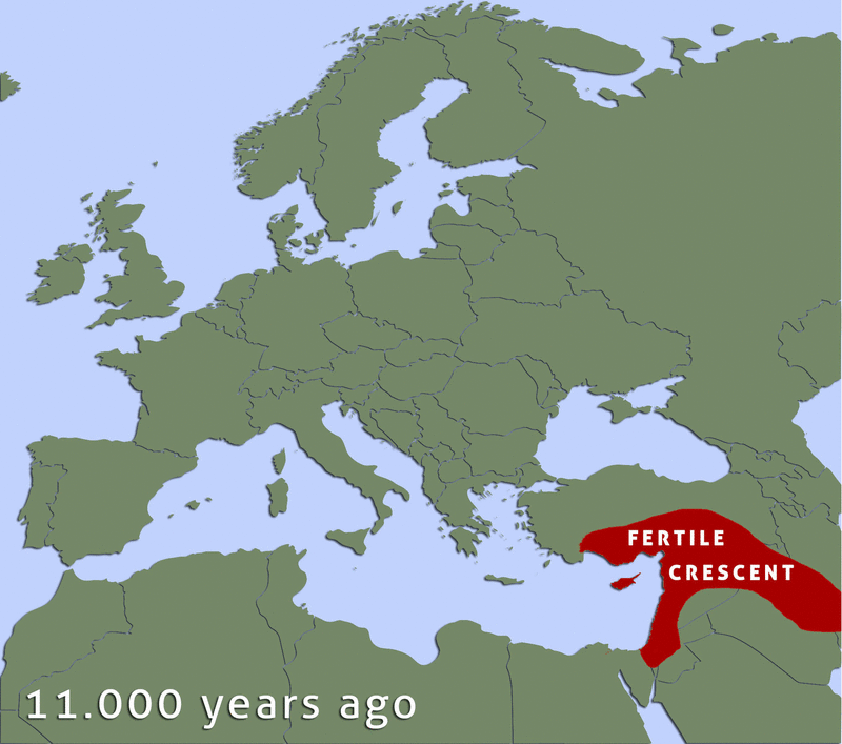

“Migration from Siberia behind the formation of Göbeklitepe: Expert states. People who migrated from Siberia formed the Göbeklitepe, and those in Göbeklitepe migrated in five other ways to spread to the world, said experts about the 12,000-year-old Neolithic archaeological site in the southwestern province of Şanlıurfa.“ The upper paleolithic migrations between Siberia and the Near East is a process that has been confirmed by material culture documents,” he said.” ref
“Semih Güneri, a retired professor from Caucasia and Central Asia Archaeology Research Center of Dokuz Eylül University, and his colleague, Professor Ekaterine Lipnina, presented the Siberia-Göbeklitepe hypothesis they have developed in recent years at the congress held in Istanbul between June 11 and 13. There was a migration that started from Siberia 30,000 years ago and spread to all of Asia and then to Eastern and Northern Europe, Güneri said at the international congress.” ref
“The relationship of Göbeklitepe high culture with the carriers of Siberian microblade stone tool technology is no longer a secret,” he said while emphasizing that the most important branch of the migrations extended to the Near East. “The results of the genetic analyzes of Iraq’s Zagros region confirm the traces of the Siberian/North Asian indigenous people, who arrived at Zagros via the Central Asian mountainous corridor and met with the Göbeklitepe culture via Northern Iraq,” he added.” ref
“Emphasizing that the stone tool technology was transported approximately 7,000 kilometers from east to west, he said, “It is not clear whether this technology is transmitted directly to long distances by people speaking the Turkish language at the earliest, or it travels this long-distance through using way stations.” According to the archaeological documents, it is known that the Siberian people had reached the Zagros region, he said. “There seems to be a relationship between Siberian hunter-gatherers and native Zagros hunter-gatherers,” Güneri said, adding that the results of genetic studies show that Siberian people reached as far as the Zagros.” ref
“There were three waves of migration of Turkish tribes from the Southern Siberia to Europe,” said Osman Karatay, a professor from Ege University. He added that most of the groups in the third wave, which took place between 2600-2400 BCE, assimilated and entered the Germanic tribes and that there was a genetic kinship between their tribes and the Turks. The professor also pointed out that there are indications that there is a technology and tool transfer from Siberia to the Göbeklitepe region and that it is not known whether people came, and if any, whether they were Turkish.” ref
“Around 12,000 years ago, there would be no ‘Turks’ as we know it today. However, there may have been tribes that we could call our ‘common ancestors,’” he added. “Talking about 30,000 years ago, it is impossible to identify and classify nations in today’s terms,” said Murat Öztürk, associate professor from İnönü University. He also said that it is not possible to determine who came to where during the migrations that were accepted to have been made thousands of years ago from Siberia. On the other hand, Mehmet Özdoğan, an academic from Istanbul University, has an idea of where “the people of Göbeklitepe migrated to.” ref
“According to Özdoğan, “the people of Göbeklitepe turned into farmers, and they could not stand the pressure of the overwhelming clergy and started to migrate to five ways.” “Migrations take place primarily in groups. One of the five routes extends to the Caucasus, another from Iran to Central Asia, the Mediterranean coast to Spain, Thrace and [the northwestern province of] Kırklareli to Europe and England, and one route is to Istanbul via [Istanbul’s neighboring province of] Sakarya and stops,” Özdoğan said. In a very short time after the migration of farmers in Göbeklitepe, 300 settlements were established only around northern Greece, Bulgaria, and Thrace. “Those who remained in Göbeklitepe pulled the trigger of Mesopotamian civilization in the following periods, and those who migrated to Mesopotamia started irrigated agriculture before the Sumerians,” he said.” ref

Ancient North Eurasian (ANE)
Ancient Beringian/Ancestral Native American (AB/ANA)
Eastern Hunter-Gatherer (EHG)
Western Hunter-Gatherers (WHG)
Western Steppe Herders (WSH)
Scandinavian Hunter-Gatherer (SHG)
Early European Farmers (EEF)
Jōmon people (Ainu people OF Hokkaido Island)
Neolithic Iranian farmers (Iran_N) (Iran Neolithic)
Haplogroup R possible time of origin about 27,000 years in Central Asia, South Asia, or Siberia:
- Mal’ta–Buret’ culture (24,000-15,000 years ago)
- Afontova Gora culture (21,000-12,000 years ago)
- Trialetian culture (16,000–8000 years ago)
- Samara culture (7,000-6,500 years ago)
- Khvalynsk culture (7,000-6,500 years ago)
- Afanasievo culture (5,300-4,500 years ago)
- Yamna/Yamnaya Culture (5,300-4,500 years ago)
- Andronovo culture (4,000–2,900 years ago) ref
Groups partially derived from the Ancient North Eurasians
“The ANE lineage is defined by association with the MA-1, or “Mal’ta boy”, remains of 24,000 years ago in central Siberia Mal’ta-Buret’ culture 24,000-15,000 years ago. The Ancient North Eurasians (ANE) samples (Afontova Gora 3, Mal’ta 1, and Yana-RHS) show evidence for minor gene flow from an East Asian-related group (simplified by the Amis, Han, or Tianyuan) but no evidence for ANE-related geneflow into East Asians (Amis, Han, Tianyuan), except the Ainu, of North Japan.” ref
“The ANE lineage is defined by association with the MA-1, or “Mal’ta boy”, remains of 24,000 years ago in central Siberia Mal’ta-Buret’ culture 24,000-15,000 years ago “basal to modern-day Europeans”. Some Ancient North Eurasians also carried East Asian populations, such as Tianyuan Man.” ref
“Bronze-age-steppe Yamnaya and Afanasevo cultures were ANE at around 50% and Eastern Hunter-Gatherer (EHG) at around 75% ANE. Karelia culture: Y-DNA R1a-M417 8,400 years ago, Y-DNA J, 7,200 years ago, and Samara, of Y-haplogroup R1b-P297 7,600 years ago is closely related to ANE from Afontova Gora, 18,000 years ago around the time of blond hair first seen there.” ref
Ancient North Eurasian
“In archaeogenetics, the term Ancient North Eurasian (often abbreviated as ANE) is the name given to an ancestral West Eurasian component that represents descent from the people similar to the Mal’ta–Buret’ culture and populations closely related to them, such as from Afontova Gora and the Yana Rhinoceros Horn Site. Significant ANE ancestry are found in some modern populations, including Europeans and Native Americans.” ref
“The ANE lineage is defined by association with the MA-1, or “Mal’ta boy“, the remains of an individual who lived during the Last Glacial Maximum, 24,000 years ago in central Siberia, Ancient North Eurasians are described as a lineage “which is deeply related to Paleolithic/Mesolithic hunter-gatherers in Europe,” meaning that they diverged from Paleolithic Europeans a long time ago.” ref
“The ANE population has also been described as having been “basal to modern-day Europeans” but not especially related to East Asians, and is suggested to have perhaps originated in Europe or Western Asia or the Eurasian Steppe of Central Asia. However, some samples associated with Ancient North Eurasians also carried ancestry from an ancient East Asian population, such as Tianyuan Man. Sikora et al. (2019) found that the Yana RHS sample (31,600 BP) in Northern Siberia “can be modeled as early West Eurasian with an approximately 22% contribution from early East Asians.” ref
“Populations genetically similar to MA-1 were an important genetic contributor to Native Americans, Europeans, Central Asians, South Asians, and some East Asian groups, in order of significance. Lazaridis et al. (2016:10) note “a cline of ANE ancestry across the east-west extent of Eurasia.” The ancient Bronze-age-steppe Yamnaya and Afanasevo cultures were found to have a noteworthy ANE component at ~50%.” ref
“According to Moreno-Mayar et al. 2018 between 14% and 38% of Native American ancestry may originate from gene flow from the Mal’ta–Buret’ people (ANE). This difference is caused by the penetration of posterior Siberian migrations into the Americas, with the lowest percentages of ANE ancestry found in Eskimos and Alaskan Natives, as these groups are the result of migrations into the Americas roughly 5,000 years ago.” ref
“Estimates for ANE ancestry among first wave Native Americans show higher percentages, such as 42% for those belonging to the Andean region in South America. The other gene flow in Native Americans (the remainder of their ancestry) was of East Asian origin. Gene sequencing of another south-central Siberian people (Afontova Gora-2) dating to approximately 17,000 years ago, revealed similar autosomal genetic signatures to that of Mal’ta boy-1, suggesting that the region was continuously occupied by humans throughout the Last Glacial Maximum.” ref
“The earliest known individual with a genetic mutation associated with blonde hair in modern Europeans is an Ancient North Eurasian female dating to around 16000 BCE from the Afontova Gora 3 site in Siberia. It has been suggested that their mythology may have included a narrative, found in both Indo-European and some Native American fables, in which a dog guards the path to the afterlife.” ref
“Genomic studies also indicate that the ANE component was introduced to Western Europe by people related to the Yamnaya culture, long after the Paleolithic. It is reported in modern-day Europeans (7%–25%), but not of Europeans before the Bronze Age. Additional ANE ancestry is found in European populations through paleolithic interactions with Eastern Hunter-Gatherers, which resulted in populations such as Scandinavian Hunter-Gatherers.” ref
“The Ancient North Eurasians (ANE) split from the ancestors of European peoples somewhere in the Middle East or South-central Asia, and used a northern dispersal route through Central Asia into Northern Asia and Siberia. Genetic analyses show that all ANE samples (Afontova Gora 3, Mal’ta 1, and Yana-RHS) show evidence for minor gene flow from an East Asian-related group (simplified by the Amis, Han, or Tianyuan). In contrast, no evidence for ANE-related geneflow into East Asians (Amis, Han, Tianyuan), except the Ainu, was found.” ref
“Genetic data suggests that the ANE formed during the Terminal Upper-Paleolithic (36+-1,5ka) period from a deeply European-related population, which was once widespread in Northern Eurasia, and from an early East Asian-related group, which migrated northwards into Central Asia and Siberia, merging with this deeply European-related population. These population dynamics and constant northwards geneflow of East Asian-related ancestry would later gave rise to the “Ancestral Native Americans” and Paleosiberians, which replaced the ANE as dominant population of Siberia.” ref
Groups partially derived from the Ancient North Eurasians
“Eastern Hunter-Gatherer (EHG) is a lineage derived predominantly (75%) from ANE. It is represented by two individuals from Karelia, one of Y-haplogroup R1a-M417, dated c. 8.4 kya, the other of Y-haplogroup J, dated c. 7.2 kya; and one individual from Samara, of Y-haplogroup R1b-P297, dated c. 7.6 kya. This lineage is closely related to the ANE sample from Afontova Gora, dated c. 18 kya. After the end of the Last Glacial Maximum, the Western Hunter-Gatherers (WHG) and EHG lineages merged in Eastern Europe, accounting for early presence of ANE-derived ancestry in Mesolithic Europe. Evidence suggests that as Ancient North Eurasians migrated West from Eastern Siberia, they absorbed Western Hunter-Gatherers and other West Eurasian populations as well.” ref
“Caucasian Hunter-Gatherer (CHG) is represented by the Satsurblia individual dated ~13 kya (from the Satsurblia cave in Georgia), and carried 36% ANE-derived admixture. While the rest of their ancestry is derived from the Dzudzuana cave individual dated ~26 kya, which lacked ANE-admixture, Dzudzuana affinity in the Caucasus decreased with the arrival of ANE at ~13 kya Satsurblia.” ref
“Scandinavian Hunter-Gatherer (SHG) is represented by several individuals buried at Motala, Sweden ca. 6000 BC. They were descended from Western Hunter-Gatherers who initially settled Scandinavia from the south, and later populations of EHG who entered Scandinavia from the north through the coast of Norway.” ref
“Iran Neolithic (Iran_N) individuals dated ~8.5 kya carried 50% ANE-derived admixture and 50% Dzudzuana-related admixture, marking them as different from other Near-Eastern and Anatolian Neolithics who didn’t have ANE admixture. Iran Neolithics were later replaced by Iran Chalcolithics, who were a mixture of Iran Neolithic and Near Eastern Levant Neolithic.” ref
“Ancient Beringian/Ancestral Native American are specific archaeogenetic lineages, based on the genome of an infant found at the Upward Sun River site (dubbed USR1), dated to 11,500 years ago. The AB lineage diverged from the Ancestral Native American (ANA) lineage about 20,000 years ago.” ref
“West Siberian Hunter-Gatherer (WSHG) are a specific archaeogenetic lineage, first reported in a genetic study published in Science in September 2019. WSGs were found to be of about 30% EHG ancestry, 50% ANE ancestry, and 20% to 38% East Asian ancestry.” ref
“Western Steppe Herders (WSH) is the name given to a distinct ancestral component that represents descent closely related to the Yamnaya culture of the Pontic–Caspian steppe. This ancestry is often referred to as Yamnaya ancestry or Steppe ancestry.” ref
“Late Upper Paeolithic Lake Baikal – Ust’Kyakhta-3 (UKY) 14,050-13,770 BP were mixture of 30% ANE ancestry and 70% East Asian ancestry.” ref
“Lake Baikal Holocene – Baikal Eneolithic (Baikal_EN) and Baikal Early Bronze Age (Baikal_EBA) derived 6.4% to 20.1% ancestry from ANE, while rest of their ancestry was derived from East Asians. Fofonovo_EN near by Lake Baikal were mixture of 12-17% ANE ancestry and 83-87% East Asian ancestry.” ref
“Hokkaido Jōmon people specifically refers to the Jōmon period population of Hokkaido in northernmost Japan. Though the Jōmon people themselves descended mainly from East Asian lineages, one study found an affinity between Hokkaido Jōmon with the Northern Eurasian Yana sample (an ANE-related group, related to Mal’ta), and suggest as an explanation the possibility of minor Yana gene flow into the Hokkaido Jōmon population (as well as other possibilities). A more recent study by Cooke et al. 2021, confirmed ANE-related geneflow among the Jōmon people, partially ancestral to the Ainu people. ANE ancestry among Jōmon people is estimated at 21%, however, there is a North to South cline within the Japanese archipelago, with the highest amount of ANE ancestry in Hokkaido and Tohoku.” ref


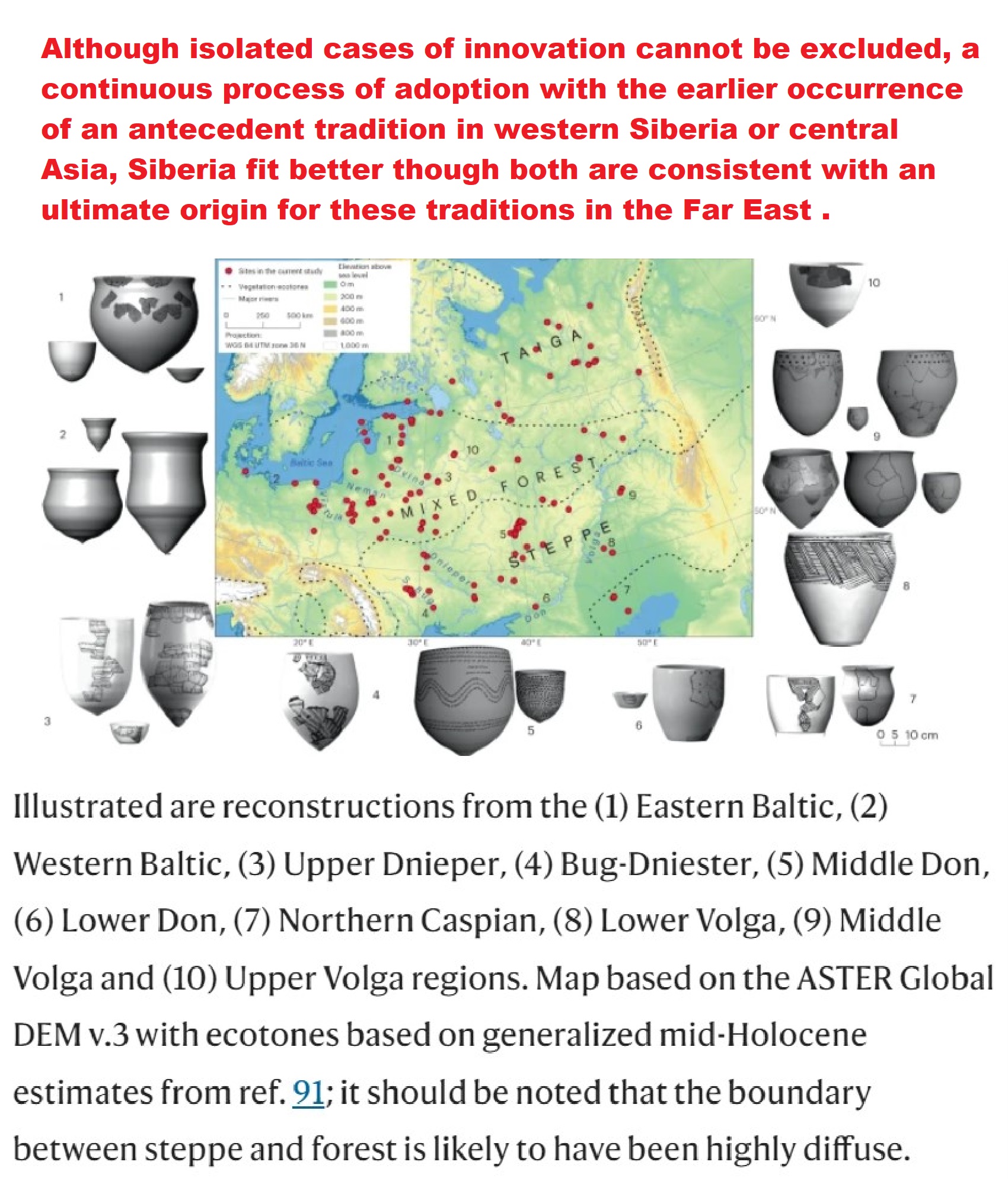
The transmission of pottery technology among prehistoric European hunter-gatherers
https://www.nature.com/articles/s41562-022-01491-8
“Although isolated cases of innovation cannot be excluded, a continuous process of adoption with the earlier occurrence of an antecedent tradition in western Siberia or central Asia, Siberia fit better though both are consistent with an ultimate origin for these traditions in the Far East.” ref
“Major refugial source populations for the modern Caucasus are those of the Caucasus, Anatolia, the Balkans, and Siberia. These glacial refugia and the barriers to migration played an important role in human evolution, and generated much of the human genetic and ethno-linguistic patterns found in the world today. The Caucasus contributed about half of the genetic ancestry of Yamnaya—that is, pastoralists of the Pontic-Caspian steppe, who date from the Late Copper Age to the Early Bronze Age and made profound demographic and cultural impacts on much of Eurasia e.g. by spreading genomes, Indo-European languages, and horse-riding. It is hypothesized that Proto-Indo-European was generated from an admixture between archaic languages from the Caucasus and Proto-Uralic languages in the Pontic-Caspian steppe. Thus, the Caucasus has played an important role in the formation of past and present Eurasian genetic and cultural diversity.” ref
“The studies of genome-wide autosomal profiles as well as the mitochondrial and Y chromosomal haplogroups support that there is genetic continuity in the present-day southern Caucasus stretching back at least 13,000 years to the Late Upper Palaeolithic. In the North Caucasus, this continuity was disrupted due to post-bronze age admixture with populations from the Eurasian Steppe. At present genetic differentiation between ethnic/subethnic groups in the Caucasus correlates with landscape permeability to human movement—as determined by terrain ruggedness, forest cover, and snow cover—rather than ethnic or linguistic boundaries.” ref
“The Caucasus Mountains are a mountain range at the intersection of Asia and Europe. Stretching between the Black Sea and the Caspian Sea, they are surrounded by the Caucasus region. The highlands of the Lesser Caucasus Mountains in Armenia, Azerbaijan, and Georgia. Crossing the Caucasus Mountain range was an important section of the northern arm of the Silk Route. Tusheti shepherds of Georgia have been herding livestock to seasonal grazing grounds, a practice known as transhumance for over 10,000 years.” ref
Haplogroup N (mtDNA)
“Haplogroup N is a human mitochondrial DNA (mtDNA) clade. A macrohaplogroup, its descendant lineages are distributed across many continents. Like its sibling macrohaplogroup M, macrohaplogroup N is a descendant of the haplogroup L3. Haplogroup L3 is strongly associated with the out-of-Africa migration of modern humans of about 70–50,000 years ago. The haplogroup N descendant lineage U6 has been found among Iberomaurusian specimens at the Taforalt site, which date from the Epipaleolithic. Rare unclassified haplogroup N* has been found among fossils belonging to the Cardial and Epicardial culture (Cardium pottery) and the Pre-Pottery Neolithic B. Haplogroup N1a – Arabian Peninsula and Northeast Africa. Found also in Central Asia and Southern Siberia. This branch is well attested in ancient people from various cultures of Neolithic Europe, from Hungary to Spain, and among the earliest farmers of Anatolia.” ref, ref
“M and N are the signature maternal haplogroups that define the theory of the recent African origin of modern humans and subsequent early human migrations around the world. The mitochondrial DNA variation in isolated “relict” populations in southeast Asia and among Indigenous Australians supports the view that there was only a single dispersal from Africa. Southeast Asian populations and Indigenous Australians all possess deep-rooted clades of both haplogroups M and N. The distribution of the earliest branches within haplogroups M, N, and R across Eurasia and Oceania, therefore, supports a three-founder-mtDNA scenario and a single migration route out of Africa.” ref
Asian origin hypothesis for Haplogroup N (mtDNA)
“The hypothesis of Asia as the place of origin of haplogroup N is supported by the following:
- Haplogroup N is found in all parts of the world but has low frequencies in Sub-Saharan Africa. According to a number of studies, the presence of Haplogroup N in Africa is most likely the result of back migration from Eurasia.
- The oldest clades of macrohaplogroup N are found in Asia and Australia.
- It would be paradoxical that haplogroup N had traveled all the distance to Australia or New World yet failed to affect other populations within Africa besides North Africans and Horn Africans.
- The mitochondrial DNA variation in isolated “relict” populations in southeast Asia supports the view that there was only a single dispersal from Africa. The distribution of the earliest branches within haplogroups M, N, and R across Eurasia and Oceania provides additional evidence for a three-founder-mtDNA scenario and a single migration route out of Africa. These findings also highlight the importance of Indian subcontinent in the early genetic history of human settlement and expansion. Therefore, N’s history is similar to M and R which have their most probable origin in South Asia.” ref
“Haplogroups N1a and I have never been found in ancient samples from Paleolithic or Mesolithic Europe. The oldest known N1a samples were found in Pre-Pottery Neolithic cultures from central Anatolia. Kılınç et al. (2016) retrieved two N1a1a1 samples from the Boncuklu site (8300 BCE), as well as two N1a1a1 and two N1b1a from the Tepecik-Çiftlik site (± 6400 BCE). Mathieson et al. (2015) also found one N1a1a1 and three N1a1a1a from the Barcın and Menteşe sites (± 6350 BCE) in north-western Anatolia. The paternal lineages that accompanied them belonged to mostly Y-haplogroup G2a2, but also to C1a2, I2c, H2, and J2a. N1a lineages were also found in practically all Early Neolithic cultures in Europe. However, so far it has never been found in the Fertile Crescent itself, although N1b was identified by Lazaridis et al. (2016) in the Mesolithic Natufian culture in Israel. Based on current evidence, it would seem that the roots of haplogroup N1a are in Anatolia, whence it spread with Neolithic farmers to Europe, and perhaps also to the Caucasus region.” ref
“The earliest evidence of N1a in Europe comes from the Early Neolithic, when it suddenly pops up in 16 of the 146 skeletons tested to date from various sites of the Starčevo culture (7% of all samples) in Croatia and Hungary, and especially the Linear Pottery culture (LBK) in Germany (see Adler 2012 and Brandt 2013), where it reaches the spectacularly high frequency of 12.75%. This may have been due to a founder effect among LBK farmers, but it is noteworthy that later Neolithic cultures in the region kept high levels of N1a compared to modern Germany. That included samples from the Rössen (9%) and Schöningen (3%) cultures, as well as the Baalberge (5%) and Salzmünde (7%) groups of the Funnelbeaker culture, spanning the whole Neolithic and early Chalcolithic periods. These German samples belonged to the N1a1a, N1a1a1, and N1a1a3 subclades. From the time of the Corded Ware culture, representing the advance of Proto-Indo-European speakers from the Pontic Steppe of Ukraine and southern Russia, haplogroup N1a suddenly disappears from the record in Central Europe, and would never come back. N1a was also found in the Alföld culture in Hungary, an eastern branch of the Linear Pottery culture, as well as in Megalithic France.” ref
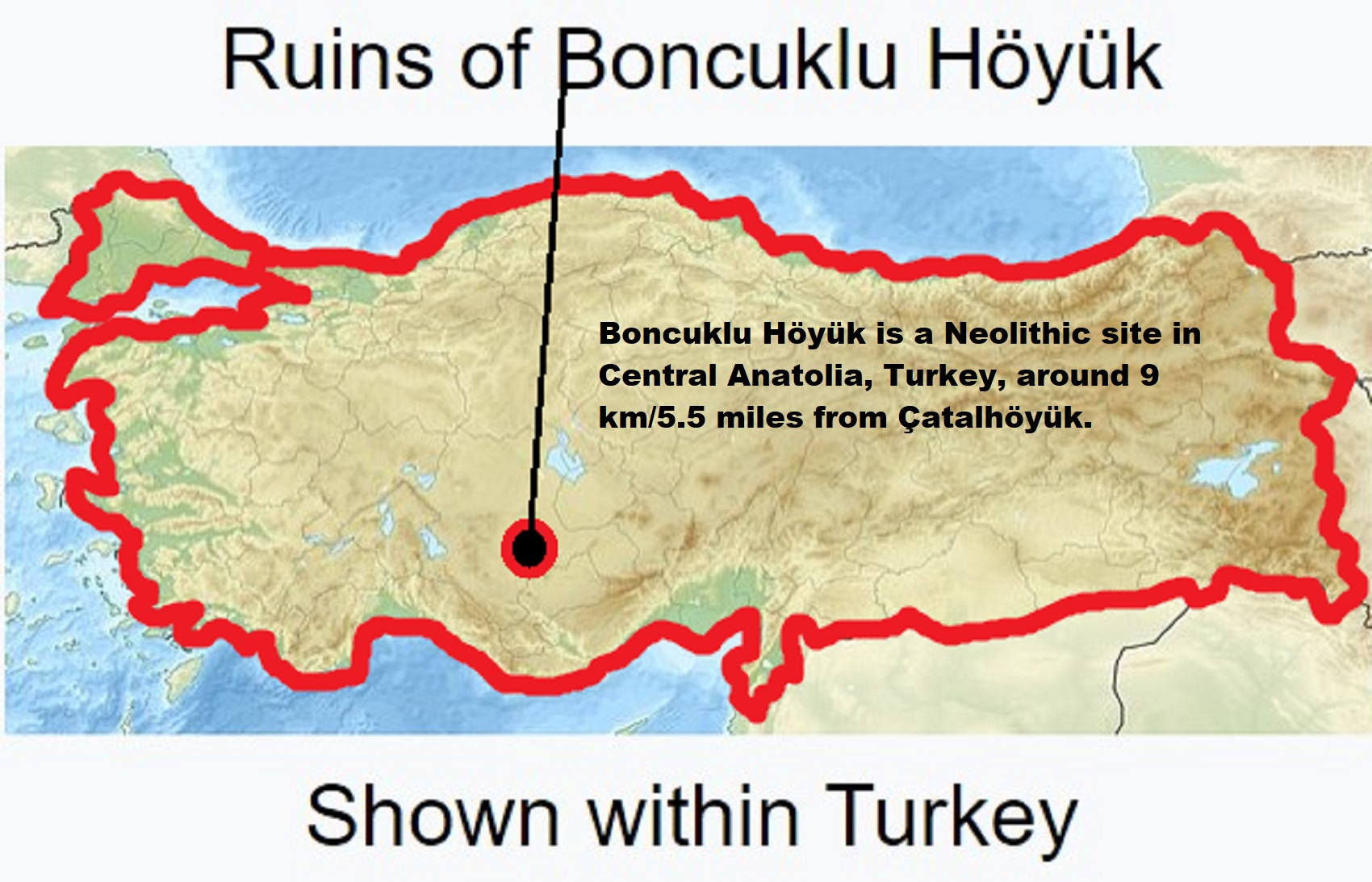
Boncuklu Höyük: The earliest ceramics on the Anatolian plateau?
“Boncuklu Höyük is a Neolithic site in Central Anatolia, Turkey, around 9 km/5.5 miles from Çatalhöyük.” ref
“12 fired clay samples and an unfired marl sample from the late 9th and early 8th-millennium BCE site of Boncuklu Höyük (8300–7800 cal BCE) in the Konya Plain, Turkey, were analyzed by optical microscopy and SEM-EDX. The plant remains in the pottery fabrics were also examined in the variable pressure scanning electron microscope. Chemical analyses show that the same clays were used for multiple purposes, and more than one type of raw material was used to make the fired clay objects examined. Only one sherd showed signs of having added temper. The presence of scattered organic remains in the fabrics also suggests that the clay was minimally processed. Although the minerals present do not show any optical alteration, the shrinkage of the plant matter and the discoloring of bone inclusions suggested that all but one sample were fired, albeit at a relatively low temperature. These sherds are therefore regarded as among the earliest ceramic vessels known in southwest Asia, although the manufacturing technique was different to that used to make the contemporaneous PPNB ceramics found at Kfar HaHoresh in Israel.” ref
“The clay vessels from Boncuklu Höyük, an early Neolithic site in central Anatolia. The site dates to c. 8300 to 7800 cal BCE, much earlier than the accepted date for the introduction of pottery in Anatolia, c. 7000 cal BCE. Thus the primary question is whether the clay vessels constitute true ceramics, i.e. were fired intentionally. Boncuklu Höyük appears to have been established on a rise within a wetland area. Evidence for the use of crop plants at Boncuklu is clearly present but sparse, and foraging was probably more important than farming. Seasonality proxies suggest that the site was occupied throughout the year, but the community may well have included more mobile groups that were absent at different times.” ref
“Excavation of several areas with a combined exposure of over 400 m2 has revealed houses with painted floors, bucrania, and clay and plaster relief decoration, predating similar practices at the nearby site of Çatalhöyük by about a millennium. A sequence of six buildings, reconstructed one above another, has been excavated in one area (Area K); as at Çatalhöyük, continuous reconstruction in the same place appears to have been important. The buildings at Boncuklu were c. 3 × 5 m and ellipsoidal with the walls made from mudbrick. The buildings showed evidence of ground-level entry, unlike at Çatalhöyük where entry was from the roof. As at Çatalhöyük, however, there is strong evidence for a highly structured use of internal space, and the presence of plaster installations and painting. Extensive midden deposits accumulated in open areas and were associated with hearths and lightweight structures that may have formed shelters for work areas.” ref
“The inhabitants of Boncuklu made a variety of objects from clay, including vessels, storage structures, figurines, and a large number of other geometric and amorphous objects. Seventy-seven fragments of fine and coarse clay vessels which can be assigned to the assemblage related to Neolithic phases of occupation at the site were recovered from the site by 2012. Circa one third of these are from securely stratified Neolithic contexts, from different parts of the sequences dated directly by C14. Around half of the stratified examples were isolated sherds within ashy midden deposits and found in areas outside buildings. Middens were associated with activities involving food preparation and consumption, which occurred both outside and inside buildings. Sherds were also found within buildings, mainly in the ‘dirty’ areas surrounding hearths. One sherd was found in a grave fill in a house, but seems to have been deposited unintentionally when the grave was closed. Given the early date of the site in terms of pottery use in southwest Asia, the main question discussed here is whether these vessels were fired or only sun-dried, and if they were fired, at what temperature?” ref
“Five potential categories of ware-types were identified: fine wares, coarse wares, structural wares, fired marl, and unfired marl. Two examples of fine wares were from open bowls with flat rim profiles, and diameters of 220 mm and 280 mm. Both rim fragments were decorated with lateral incised lines. Each showed breakage in a manner consistent with poorly smoothed and bonded coils. Coarse ware sherds were from open bowls, hole mouth pots, and jars. These were pinched, slab- or coil-built and all had rounded rims (diameters varied from 40 to 220 mm). For some examples, thin layers of clay were used to create the exterior surface. It was not always clear whether the fragments of structural wares were from large vessels, oven walls, or sections of storage bins, perhaps intentionally fired in situ to make them more robust.” ref
“Examples were coil- or slab-built, with well-smoothed outer and inner surfaces. Two sections of rim were found, one from an open bowl (diameter 320 mm) and one from a straight-necked jar (diameter 250 mm). The thickness of the walls suggests they were used for hot stone cooking, a technique that focuses on insulation rather than conduction. Other examples of structural wares may be derived from fire installations and thereby have been baked by default. Sherds incorporated into the base of hearths have been found in the midden area (Area M) at Boncuklu; possibly they increased thermal shock resistance and thereby the hearths’ use-life. It is unclear, however, if they were fired before their incorporation into the hearth or as a result of it.” ref
“Examples within the fired marl category were thought to be broken/detached sections of the basins and channels that have been found in situ on site. They may have helped to drain liquids and a light firing may have increased their durability. Similar ‘water-channels’ have been identified for the Pottery Neolithic phase at Tell Seker al-Aheimar. Many of the exterior surfaces were notably rough and pitted. Others showed plant impressions suggesting they may have been formed around or over basketry. Examples categorized as unfired marl were made in the same way with the same materials as the fired marl but not baked at all. No sections of rim were recovered, which is probably indicative of the friable nature of these objects. Thirteen samples were analyzed: a figurine fragment (BK15), two fragments of fine ware vessels (BK1, 2), two fragments of coarse ware vessels (BK4, 5), four examples of structural wares (BK6, 7, 9 and 10); three fragments of fired marl (BK11, 12 and 13) and a section of unfired marl (BK14).” ref
“Boncuklu Höyük in Central Anatolia, Turkey, situated around 9 km from the more famous Çatalhöyük site, the remains of one of the world’s oldest villages, occupied between around 8300 to 7800 BCE. The buildings are small and oval-shaped with walls constructed of mudbricks. The remains of burials of human bodies were found below the floors of the buildings. The earliest known ceramics of Anatolia have been discovered there.” ref
“Çatalhöyük is a tell of a very large Neolithic and Chalcolithic proto-city settlement in southern Anatolia, which existed from approximately 7500 BC to 6400 BCE, and flourished around 7000 BCE. Çatalhöyük was composed entirely of domestic buildings, with no obvious public buildings. While some of the larger ones have rather ornate murals, the purpose of some rooms remains unclear. The population of the eastern mound has been estimated to be around 10,000 people, but the population likely varied over the community’s history. An average population of between 5,000 and 7,000 is a reasonable estimate.” ref
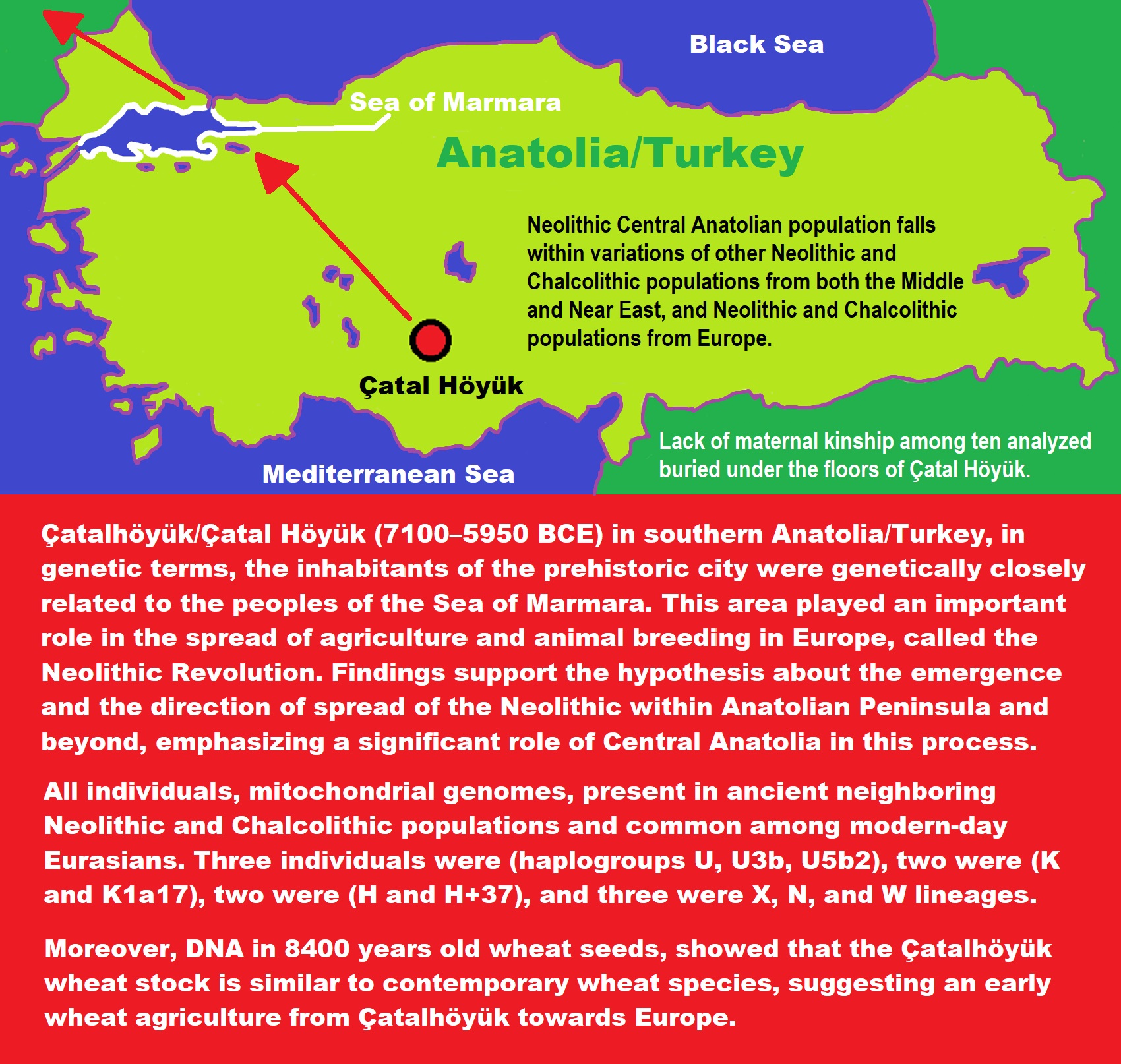
Ancient mDNA “N1a1a1” and Pottery?
Bon005 – Boncuklu Höyük mtDNA N1a1a1 around 10,220 years ago Turkey – Central Anatolia ref
Bon004 – Boncuklu Höyük mtDNA N1a1a1 around 10,076 years ago Turkey – Central Anatolia ref
ZHAG – Boncuklu Höyük mtDNA N1a1a1 around 9,900 years ago Turkey – Central Anatolia ref
People who lived in ancient settlement in central Turkey migrated to Europe: archaeologists
“10,300-year-old Boncuklu Höyük settlement in Turkey revealed that the people who lived in the settlement migrated to Europe. And the Boncuklu Höyük settlement was established a thousand years before Çatalhöyük, so is the ancestor of later Çatalhöyük.” ref
Ash040 – Aşıklı Höyük mtDNA N1a1a1 around 9,875 years ago Turkey – Central Anatolia ref
CCH144 – Çatalhöyük mtDNA N1a1a1 around 8,808 years ago Turkey – Central Anatolia ref
I1096 – Barcın Höyük mtDNA N1a1a1 around 8,300 years ago Turkey – Northwest Anatolia ref
Bar25 – Barcın Höyük mtDNA N1a1a1 around 8,295 years ago Turkey – Northwest Anatolia ref
Tep004 – Tepecik-Çiftlik Höyük mtDNA N1a1a1 around 8,237 years ago Turkey – Northwest Anatolia ref
Tep006 – Tepecik-Çiftlik Höyük mtDNA N1a1a1 around 8,099 years ago Turkey – Northwest Anatolia ref
I0725 – Mentese mtDNA N1a1a1 around 7,950 years ago Turkey – South-Western corner, on the Aegean Sea ref
I0174 – Alsonyek-Bataszek mtDNA N1a1a1 around 7,558 years ago Hungary – Starcevo ref (Starčevo–Körös–Criș culture: 6,200 – 4,500 BCE or around 8,223-6,523 years ago)
“Starčevo culture of Southeastern Europe originates in the spread of the Neolithic package of peoples and technological innovations including farming and ceramics from Anatolia to the area of Sesklo. The Starčevo culture marks its spread to the inland Balkan peninsula as the Cardial ware culture did along the Adriatic coastline. It forms part of the wider Starčevo–Körös–Criş culture which gave rise to the central European Linear Pottery culture c. 700 years after the initial spread of Neolithic farmers towards the northern Balkans.” ref
Klein1 – Kleinhadersd mtDNA N1a1a1 around 7,500 years ago Austria – LBK/AVK ref (Linear Pottery culture *LBK*: 5,500–4,500 BCE or around 7,523-6,523 years ago)
UZZ74 – Grotta dell’Uzzo, Sicily mtDNA N1a1a1 around 7,223 years ago Italy – Stentinello I ref (Stentinello culture: dated to the 5th millennium BCE: 5000 to 4000 BCE or around 7,023-6,023 years ago)
I0412 – Els Trocs, Bisaurri, Huesca, Aragón mtDNA N1a1a1 around 7,177 years ago Spain – Epicardial ref (Cardium/Cardial–Epicardial pottery culture: 6400 – 5500 BCE or around 8,423-7,023 years ago)
“Fernández et al. 2014 found traces of maternal genetic affinity between people of the Linear Pottery Culture and Cardium pottery with earlier peoples of the Near Eastern Pre-Pottery Neolithic B, including the rare mtDNA (maternal) basal haplogroup N*, and suggested that Neolithic period was initiated by seafaring colonists from the Near East. Mathieson et al. 2018 examined three Cardials buried at the Zemunica Cave near Bisko in modern-day Croatia c. 5800 BCE the three samples of mtDNA extracted belonged to the maternal haplogroups H1, K1b1a, and N1a1.” ref
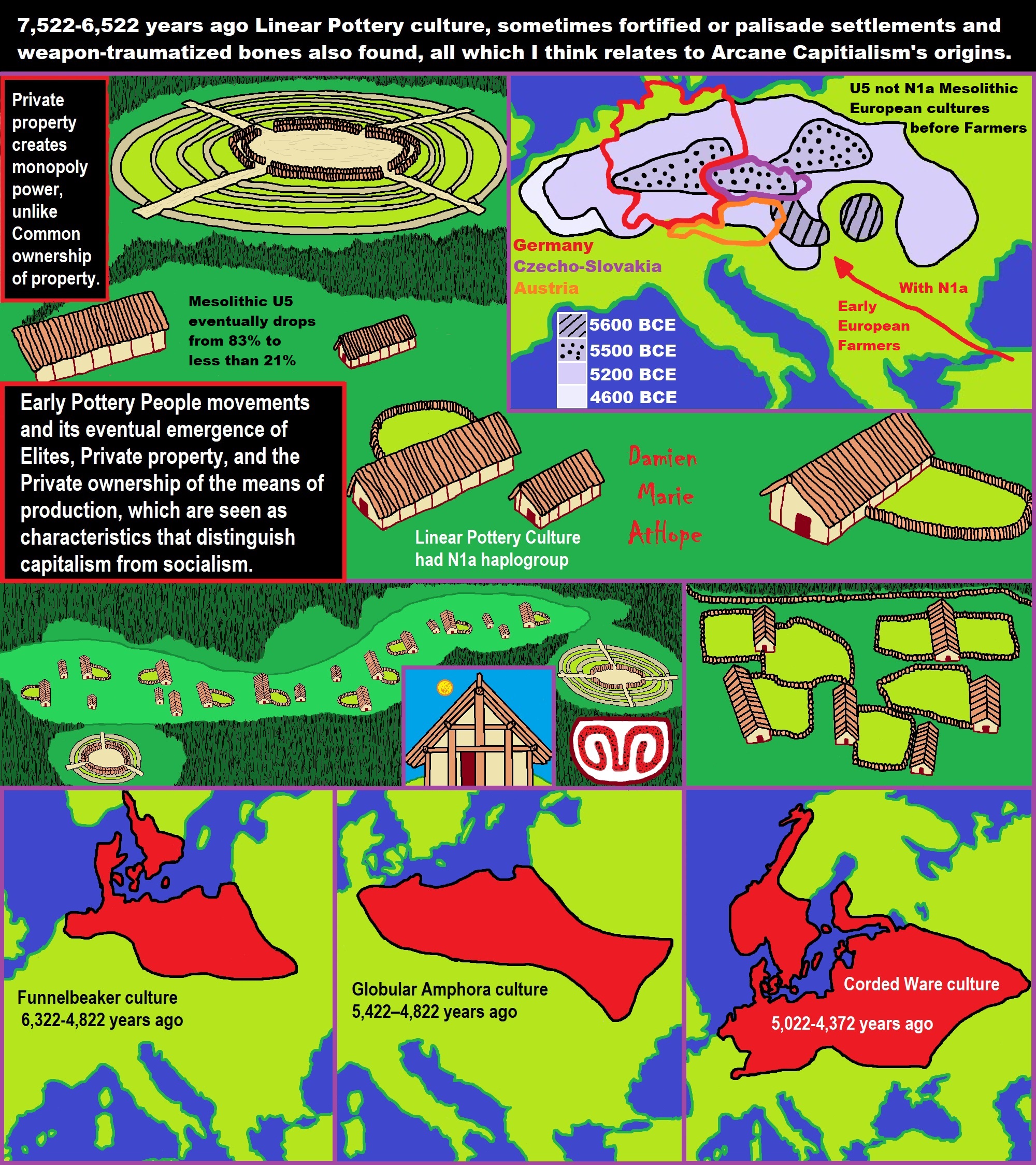
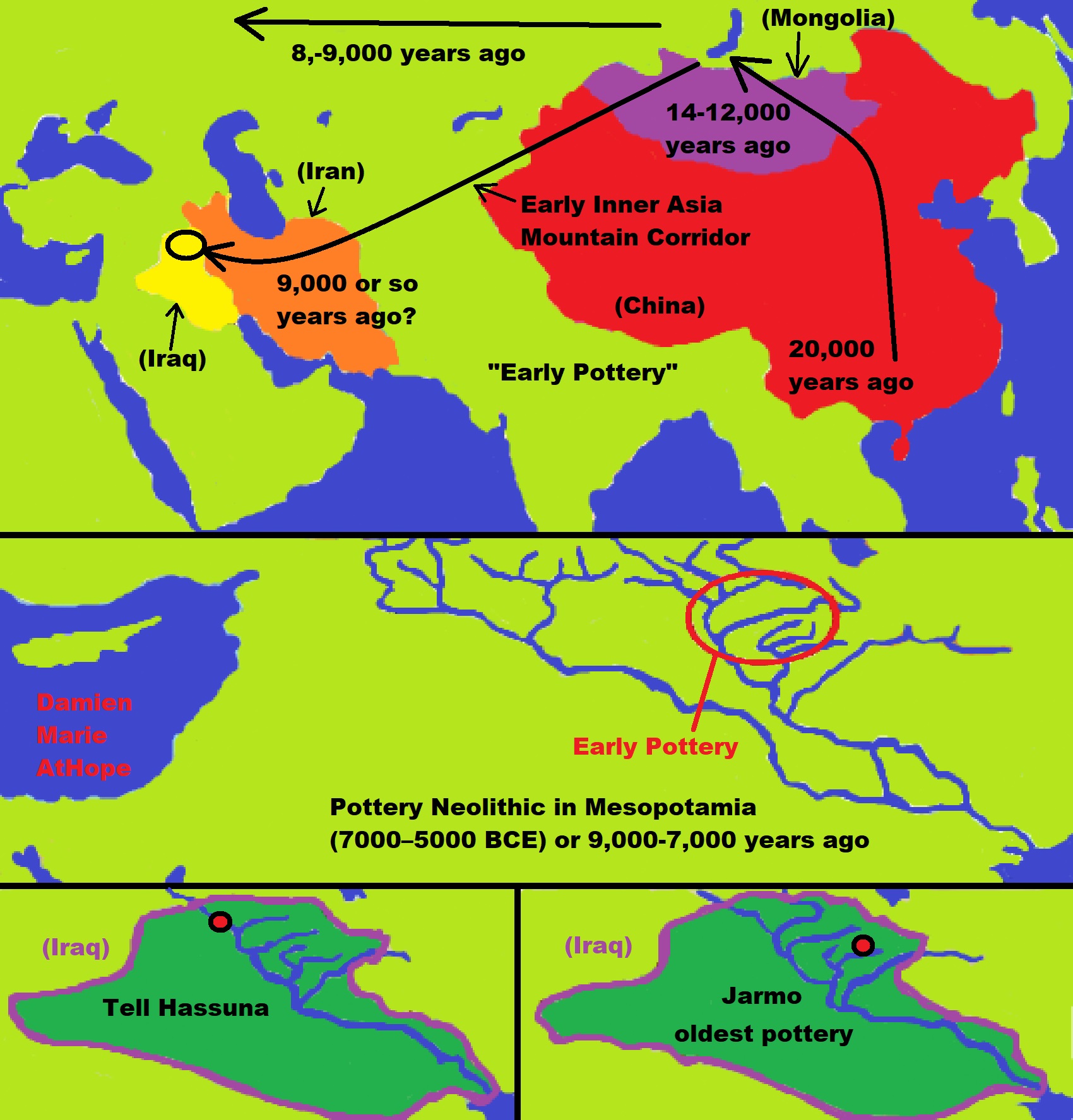
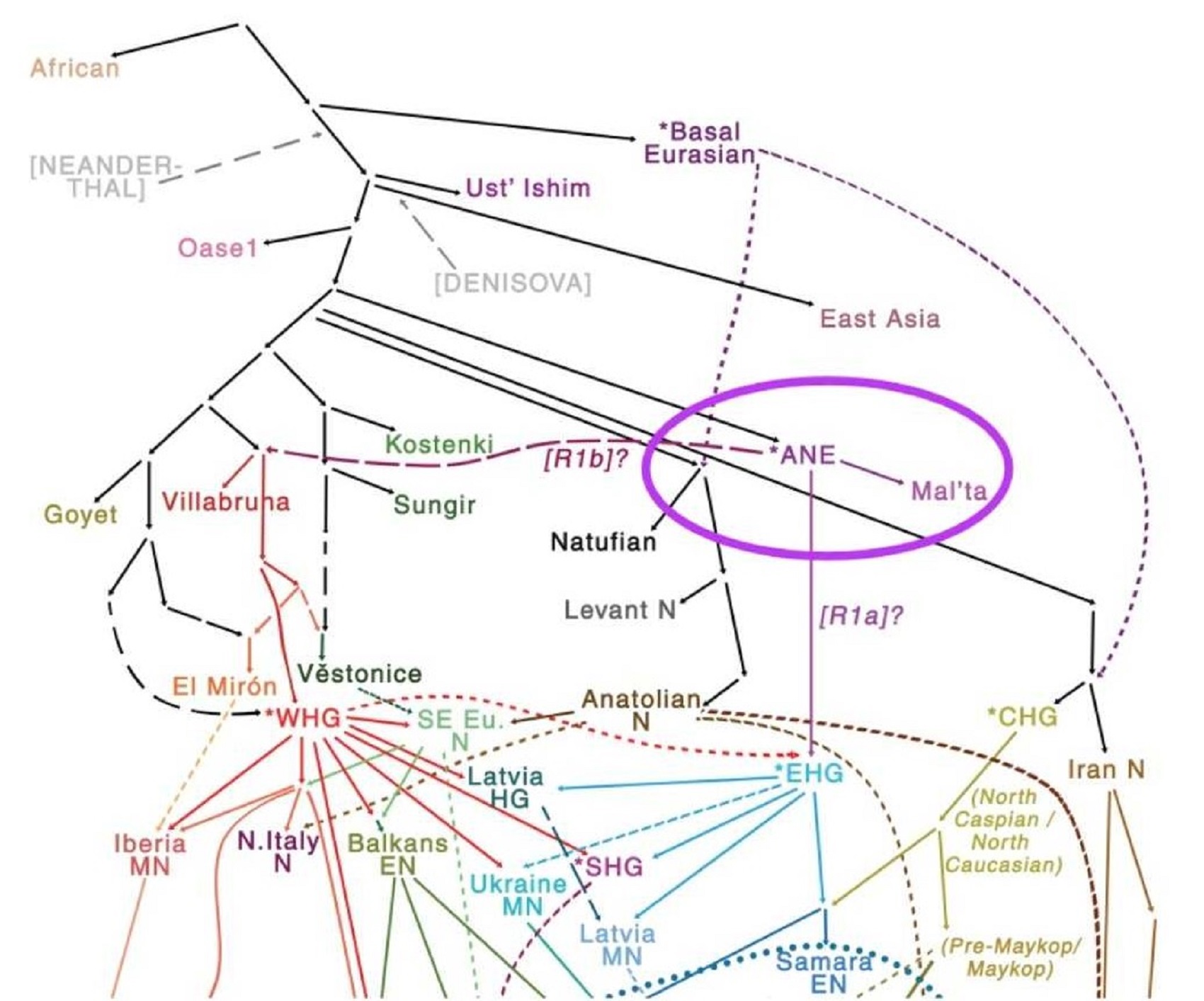
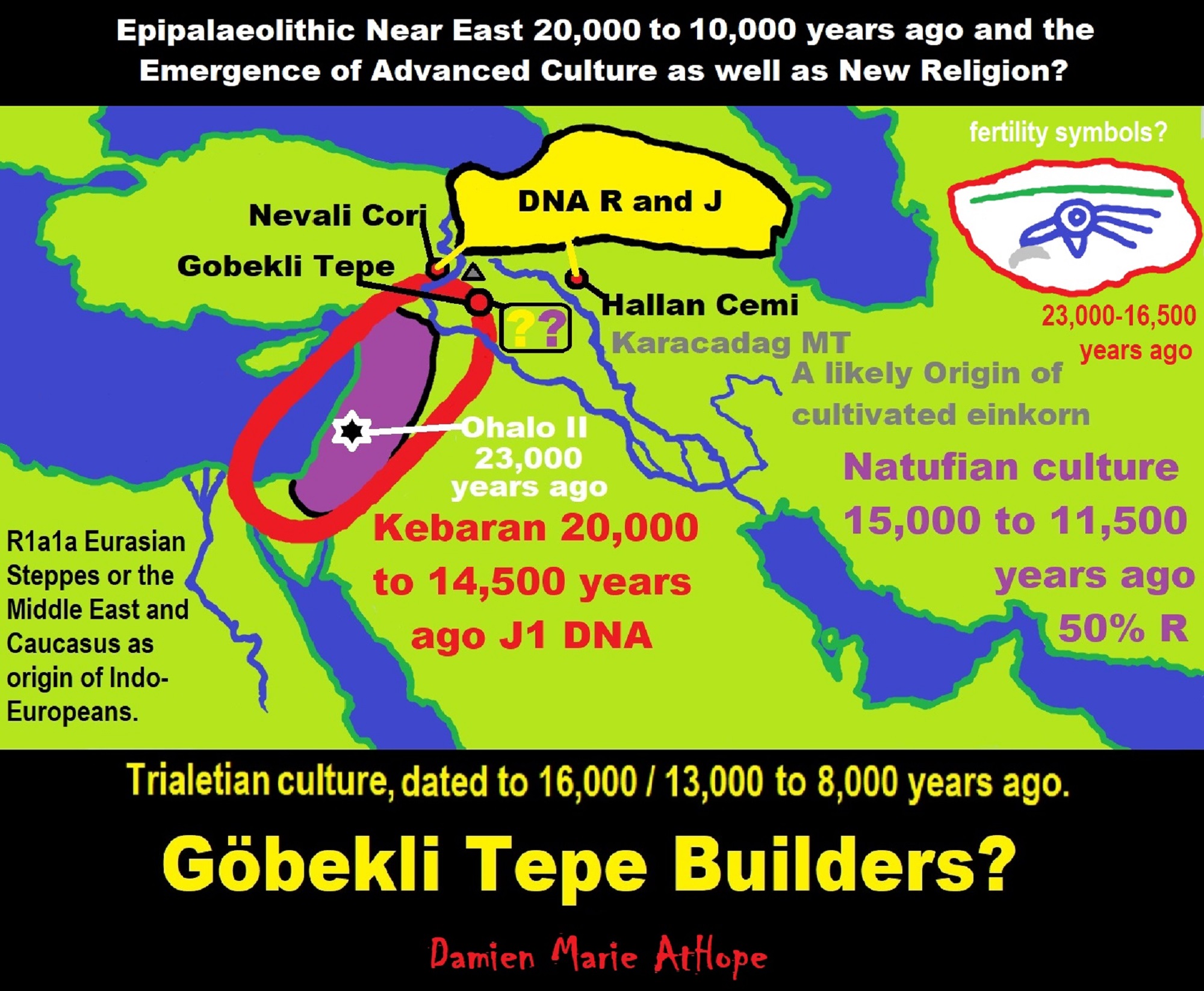
ref, ref, ref, ref, ref, ref, ref
Trialetian culture (16,000–8000 years ago) the Caucasus, Iran, and Turkey, likely involved in Göbekli Tepe. Migration 1?
Haplogroup R possible time of origin about 27,000 years in Central Asia, South Asia, or Siberia:
- Mal’ta–Buret’ culture (24,000-15,000 years ago)
- Afontova Gora culture (21,000-12,000 years ago)
- Trialetian culture (16,000–8000 years ago)
- Samara culture (7,000-6,500 years ago)
- Khvalynsk culture (7,000-6,500 years ago)
- Afanasievo culture (5,300-4,500 years ago)
- Yamna/Yamnaya Culture (5,300-4,500 years ago)
- Andronovo culture (4,000–2,900 years ago) ref
Trialetian sites
Caucasus and Transcaucasia:
- Edzani (Georgia)
- Chokh (Azerbaijan), layers E-C200
- Kotias Klde, layer B” ref
Eastern Anatolia:
- Hallan Çemi (from ca. 8.6-8.5k BC to 7.6-7.5k BCE)
- Nevali Çori shows some Trialetian admixture in a PPNB context” ref
Trialetian influences can also be found in:
- Cafer Höyük
- Boy Tepe” ref
Southeast of the Caspian Sea:
- Hotu (Iran)
- Ali Tepe (Iran) (from cal. 10,500 to 8,870 BCE)
- Belt Cave (Iran), layers 28-11 (the last remains date from ca. 6,000 BCE)
- Dam-Dam-Cheshme II (Turkmenistan), layers7,000-3,000 BCE)” ref
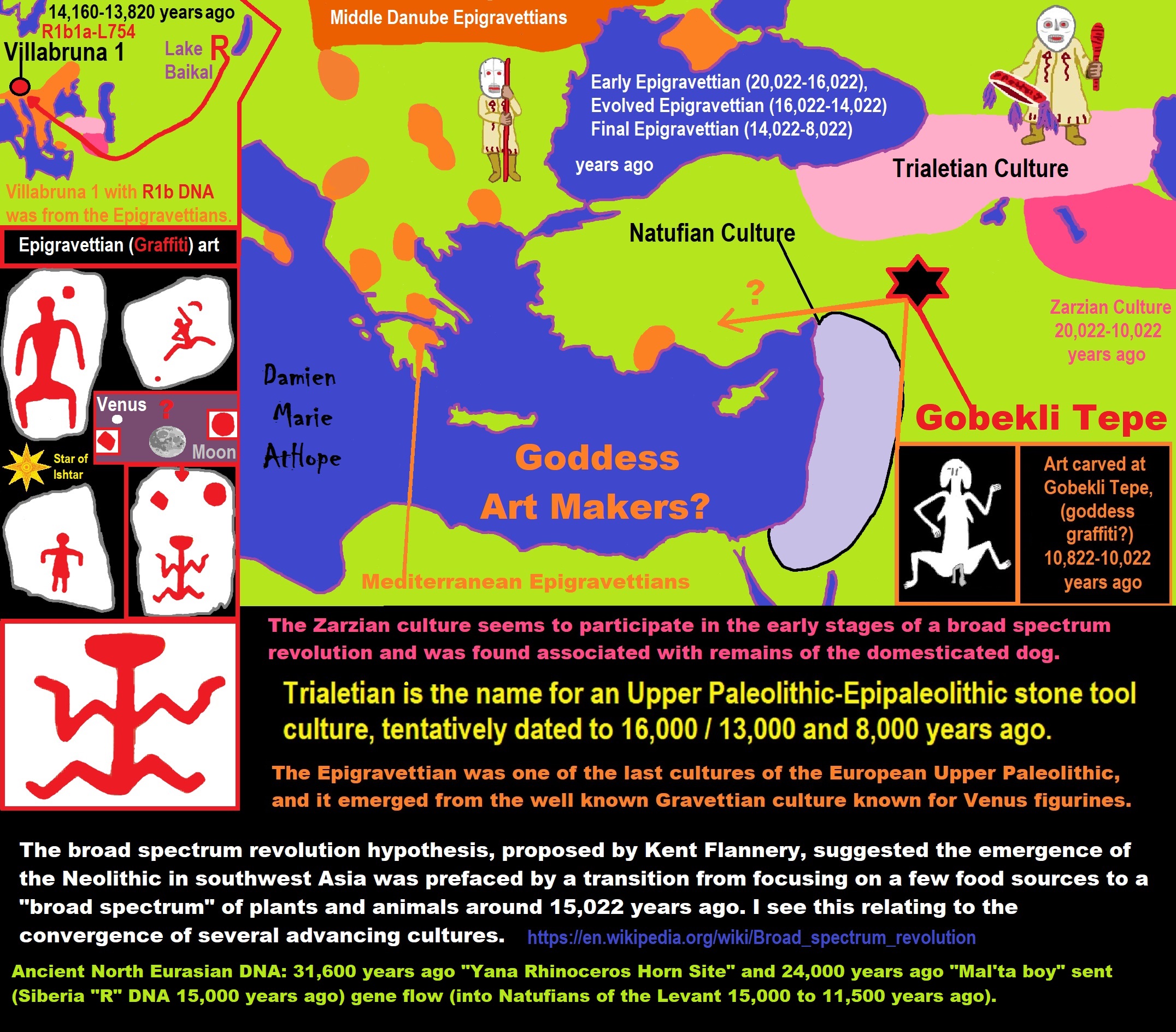
ref, ref, ref, ref, ref, ref, ref, ref, ref, ref, ref, ref, ref, ref, ref
Trialetian peoples which I think we’re more male-centric and involved in the creation of Göbekli Tepe, from its start around Pre-Pottery Neolithic A (12,000 – 10,800 years ago) began with their influence and this is seen in animal deities many clearly male and the figures also being expressively male themed as well at first, and only around Pre-Pottery Neolithic B (10,800 – 8,500 years ago) or so it seems with what I am guessing is new Epigravettian peoples with a more female-centric style (reminiscent but less than the Gravettians known for Venus figurines) influence from migration into the region, to gain new themes that add a female element both with A totem pole seeming to express birth or something similar and graffiti of a woman either ready for sex or giving birth or both. and Other bare figures seem to show a similar body position reminiscent of the graffiti of a woman.
My thoughts on how cultural/ritual was influenced in the area of Göbekli Tepe. I think it relates to a few different cultures starting in the area before the Neolithic. Two different groups of Siberians first from northwest Siberia with U6 haplogroup 40,000 to 30,000 or so. Then R Haplogroup (mainly haplogroup R1b but also some possible R1a both related to the Ancient North Eurasians). This second group added its “R” DNA of around 50% to the two cultures Natufian and Trialetian. To me, it is likely both of these cultures helped create Göbekli Tepe. Then I think the female art or graffiti seen at Göbekli Tepe to me possibly relates to the Epigravettians that made it into Turkey and have similar art in North Italy. I will also show you my art explaining this to help show my thoughts. I also have lots of links if interested to validate all this.

ref, ref, ref, ref, ref, ref, ref, ref
Sky Burials: Animism, Totemism, Shamanism, and Paganism
“In archaeology and anthropology, the term excarnation (also known as defleshing) refers to the practice of removing the flesh and organs of the dead before burial, leaving only the bones. Excarnation may be precipitated through natural means, involving leaving a body exposed for animals to scavenge, or it may be purposefully undertaken by butchering the corpse by hand. Practices making use of natural processes for excarnation are the Tibetan sky burial, Comanche platform burials, and traditional Zoroastrian funerals (see Tower of Silence). Some Native American groups in the southeastern portion of North America practiced deliberate excarnation in protohistoric times. Archaeologists believe that in this practice, people typically left the body exposed on a woven litter or altar.” ref
Ancient Headless Corpses Were Defleshed By Griffon Vultures
Sky burial ( Animal Worship mixed with Ancestor Worship) is a funeral practice where a human corpse is placed on a mountaintop, elevated ground, tree, or constructed perch to decompose while be eaten by scavenging animals, especially birds. This Animal Worship (or Zoolatry) rituals may go back to the Neanderthals who seem to Sacralize birds starting around 130,000 years ago in Croatia with eagle talon jewelry and oldest confirmed burial. Or possible (Aurignacian) “Bird Worship” at Hohle Fels cave, Germany, early totemism and small bird figurine at around 33,000 years old, which had been cited as evidence of shamanism.
As well as possible ‘Bird Worship’ (in the Pavlovian culture/Gravettian culture) part of Early Shamanism at Dolní Věstonice (Czech Republic) from around 31,000-25,000 years ago, which held the “first shaman burial.” The shamanistic Mal’ta–Buret’ culture of Siberia, dating to 24,000-15,000 years ago, who connect to the indigenous peoples of the Americas show Bird Worship. The Magdalenian cultures in western Europe, dating from around 17,000-12,000 years ago have a famous artistic mural with a bird that I think could relate to reincarnation and at least bird symbolism. Likewise, there is evidence of possible ‘Bird Worship’ at Göbekli Tepe (Turkey), dated to around 13,000/11,600-9,370 Years ago with “first human-made temple” and at Çatalhöyük (Turkey), dated to around 9,500-7,700 Years ago with “first religious designed city” both with seeming ancestor, animal, and possible goddess worship.
The Tibetan sky-burials appear to have evolved from ancient practices of defleshing corpses as discovered in archeological finds in the region. These practices most likely came out of practical considerations, but they could also be related to more ceremonial practices similar to the suspected sky burial evidence found at Göbekli Tepe (11,500 years ago) and Stonehenge (4,500 years ago). ref

“The deepest layers of Tell Qaramel with traces of occupation from the Proto-Neolithic, or transitional, horizon to the very Early Pre-Pottery Neolithic A (PPNA) along with the seeming first evidence of permanent stone-built settlement which is roughly contemporary to that of Göbekli Tepe in Turkey.” ref, ref
“Tel Qaramel is a tell, or archaeological mound, located in the north of present-day Syria, 25 km north of Aleppo and about 65 km south of the Taurus mountains, adjacent to the river Quweiq that flows to Aleppo. The excavators find an unbroken development (in contrast to e.g. in Jericho in the southern Levant) so are skeptical about the common division in “Pre-Pottery Neolithic A” and “Pre-Pottery Neolithic B” phases, instead preferring “Early Aceramic Neolithic” for the proto-neolithic and PPNA, and “Late Aceramic Neolithic” for PPNB and PPNC. Particularly striking are the remains of a succession of five round stone structures which the excavators recognize as the remains of towers (Mazurowski et al. 2012 pp. 48..52). The lower, oldest one was about 6 m in diameter and appears to have had some communal function, having an elevated hearth at the center with two benches centered on it. The fourth phase was most massive, at about 7.5m in diameter with stone walls of about 2.25 m thick; it had no internal structure. It was damaged by fire and rebuilt, and may have been a defensive structure. The earliest phase has been carbon-dated to between the eleventh millennium and 9670 BC. This dating makes the structure roughly two millennia older than the stone tower found at Jericho, which was previously believed to be the oldest known tower structure in the world. Among the ornaments found was a rather large (52×40×26 mm) polished copper nugget from Horizon 2 – one of the earliest finds of metal in an archeological site. As malachite (copper carbonate) has been excavated too in Tell Qaramel, the copper nugget may have been collected from the (as yet unidentified) malachite source. An attempt had been made to drill a hole through the copper like with other stone beads, but technology was not yet sufficiently advanced to process metal.” ref
“Remains of 20 individuals have been excavated, all adults: this may indicate that burial practice for infants and children was different, at another (as yet undiscovered) location or treated with less regard. Most bodies had their head removed, either by cutting shortly after death (as indicated by cut marks, and having the 1st vertebra remain with the skull), or after decay (leaving the vertebrae and lower mandible with the skeleton). This indicates a head cult, as is also attested in other pre-pottery Neolithic sites (notably Jericho, Tell Aswad, and Cayonu). While in some skulls teeth showed wear and caries, which is typical for a diet with carbohydrates like from grain, others were in good condition, which may indicate a pre-Neolithic diet. Before the excavations began, it was assumed that permanent sedentary settlements would occur only in combination with the first farming of cereals, and the first domestication and keeping of animals such as sheep and goats, marking the start of the Neolithic period, part of a transition between the proto-Neolithic and Pre-Pottery Neolithic A cultures. However, the remains of the structures uncovered at Tell Qaramel appear to be older than this, giving the first evidence of a permanent stone-built settlement. The site is roughly contemporary to that of Göbekli Tepe in Turkey.” ref
I think it could also relate to sky burials along with the skull cult both of which are also seen at Gobekli Tepe: “first human-made temple” around 12,000 years ago. Moreover, Göbekli Tepe’s T-shaped Pillars are not Alone (and are not Ancient Aliens).
Haplogroup R Paleolithic mammoth hunters
“Haplogroup R* originated in North Asia just before the Last Glacial Maximum (26,500-19,000 years ago). This haplogroup has been identified in the remains of a 24,000 year-old boy from the Altai region, in south-central Siberia (Raghavan et al. 2013). This individual belonged to a tribe of mammoth hunters that may have roamed across Siberia and parts of Europe during the Paleolithic. Autosomally this Paleolithic population appears to have contributed mostly to the ancestry of modern Europeans and South Asians, the two regions where haplogroup R also happens to be the most common nowadays (R1b in Western Europe, R1a in Eastern Europe, Central, and South Asia, and R2 in South Asia).” ref
“The oldest forms of R1b (M343, P25, L389) are found dispersed at very low frequencies from Western Europe to India, a vast region that could have roamed the nomadic R1b hunter-gatherers during the Ice Age. The three main branches of R1b1 (R1b1a, R1b1b, R1b1c) all seem to have stemmed from the Middle East. The southern branch, R1b1c (V88), is found mostly in the Levant and Africa. The northern branch, R1b1a (P297), seems to have originated around the Caucasus, eastern Anatolia, or northern Mesopotamia, then to have crossed over the Caucasus, from where they would have invaded Europe and Central Asia. R1b1b (M335) has only been found in Anatolia.” ref
Haplogroup R Neolithic cattle herders
“It has been hypothesized that R1b people (perhaps alongside neighboring J2 tribes) were the first to domesticate cattle in northern Mesopotamia some 10,500 years ago. R1b tribes descended from mammoth hunters, and when mammoths went extinct, they started hunting other large game such as bisons and aurochs. With the increase of the human population in the Fertile Crescent from the beginning of the Neolithic (starting 12,000 years ago), selective hunting and culling of herds started replacing the indiscriminate killing of wild animals. The increased involvement of humans in the life of aurochs, wild boars, and goats led to their progressive taming. Cattle herders probably maintained a nomadic or semi-nomadic existence, while other people in the Fertile Crescent (presumably represented by haplogroups E1b1b, G, and T) settled down to cultivate the land or keep smaller domesticates.” ref
“The analysis of bovine DNA has revealed that all the taurine cattle (Bos taurus) alive today descend from a population of only 80 aurochs. The earliest evidence of cattle domestication dates from circa 8,500 BCE in the Pre-Pottery Neolithic cultures in the Taurus Mountains. The two oldest archaeological sites showing signs of cattle domestication are the villages of Çayönü Tepesi in southeastern Turkey and Dja’de el-Mughara in northern Iraq, two sites only 250 km away from each others. This is presumably the area from which R1b lineages started expanding – or in other words the “original homeland” of R1b. The early R1b cattle herders would have split in at least three groups. One branch (M335) remained in Anatolia, but judging from its extreme rarity today wasn’t very successful, perhaps due to the heavy competition with other Neolithic populations in Anatolia, or to the scarcity of pastures in this mountainous environment.” ref
“A second branch migrated south to the Levant, where it became the V88 branch. Some of them searched for new lands south in Africa, first in Egypt, then colonizing most of northern Africa, from the Mediterranean coast to the Sahel. The third branch (P297), crossed the Caucasus into the vast Pontic-Caspian Steppe, which provided ideal grazing grounds for cattle. They split into two factions: R1b1a1 (M73), which went east along the Caspian Sea to Central Asia, and R1b1a2 (M269), which at first remained in the North Caucasus and the Pontic Steppe between the Dnieper and the Volga. It is not yet clear whether M73 actually migrated across the Caucasus and reached Central Asia via Kazakhstan, or if it went south through Iran and Turkmenistan. In any case, M73 would be a pre-Indo-European branch of R1b, just like V88 and M335.” ref
“R1b-M269 (the most common form in Europe) is closely associated with the diffusion of Indo-European languages, as attested by its presence in all regions of the world where Indo-European languages were spoken in ancient times, from the Atlantic coast of Europe to the Indian subcontinent, which comprised almost all Europe (except Finland, Sardinia and Bosnia-Herzegovina), Anatolia, Armenia, European Russia, southern Siberia, many pockets around Central Asia (notably in Xinjiang, Turkmenistan, Tajikistan, and Afghanistan), without forgetting Iran, Pakistan, northern India, and Nepal. The history of R1b and R1a are intricately connected to each others.” ref
The Levantine & African branch of R1b (V88)
“Like its northern counterpart (R1b-M269), R1b-V88 is associated with the domestication of cattle in northern Mesopotamia. Both branches of R1b probably split soon after cattle were domesticated, approximately 10,500 years ago (8,500 BCE). R1b-V88 migrated south towards the Levant and Egypt. The migration of R1b people can be followed archeologically through the presence of domesticated cattle, which appear in central Syria around 8,000-7,500 BCE (late Mureybet period), then in the Southern Levant and Egypt around 7,000-6,500 BCE (e.g. at Nabta Playa and Bir Kiseiba). Cattle herders subsequently spread across most of northern and eastern Africa. The Sahara desert would have been more humid during the Neolithic Subpluvial period (c. 7250-3250 BCE), and would have been a vast savannah full of grass, an ideal environment for cattle herding.” ref
“Evidence of cow herding during the Neolithic has shown up at Uan Muhuggiag in central Libya around 5500 BCE, at the Capeletti Cave in northern Algeria around 4500 BCE. But the most compelling evidence that R1b people related to modern Europeans once roamed the Sahara is to be found at Tassili n’Ajjer in southern Algeria, a site famous pyroglyphs (rock art) dating from the Neolithic era. Some painting dating from around 3000 BCE depict fair-skinned and blond or auburn haired women riding on cows. The oldest known R1b-V88 sample in Europe is a 6,200 year-old farmer/herder from Catalonia tested by Haak et al. (2015). Autosomally this individual was a typical Near Eastern farmer, possessing just a little bit of Mesolithic West European admixture. After reaching the Maghreb, R1b-V88 cattle herders could have crossed the Strait of Gibraltar to Iberia, probably accompanied by G2 farmers, J1 and T1a goat herders. These North African Neolithic farmers/herders could have been the ones who established the Almagra Pottery culture in Andalusia in the 6th millennium BCE.” ref
“Nowadays small percentages (1 to 4%) of R1b-V88 are found in the Levant, among the Lebanese, the Druze, and the Jews, and almost in every country in Africa north of the equator. Higher frequency in Egypt (5%), among Berbers from the Egypt-Libya border (23%), among the Sudanese Copts (15%), the Hausa people of Sudan (40%), the the Fulani people of the Sahel (54% in Niger and Cameroon), and Chadic tribes of northern Nigeria and northern Cameroon (especially among the Kirdi), where it is observed at a frequency ranging from 30% to 95% of men. According to Cruciani et al. (2010) R1b-V88 would have crossed the Sahara between 9,200 and 5,600 years ago, and is most probably associated with the diffusion of Chadic languages, a branch of the Afroasiatic languages. V88 would have migrated from Egypt to Sudan, then expanded along the Sahel until northern Cameroon and Nigeria. However, R1b-V88 is not only present among Chadic speakers, but also among Senegambian speakers (Fula-Hausa) and Semitic speakers (Berbers, Arabs).” ref
“R1b-V88 is found among the native populations of Rwanda, South Africa, Namibia, Angola, Congo, Gabon, Equatorial Guinea, Ivory Coast, Guinea-Bissau. The wide distribution of V88 in all parts of Africa, its incidence among herding tribes, and the coalescence age of the haplogroup all support a Neolithic dispersal. In any case, a later migration out of Egypt would be improbable since it would have brought haplogroups that came to Egypt during the Bronze Age, such as J1, J2, R1a or R1b-L23. The maternal lineages associated with the spread of R1b-V88 in Africa are mtDNA haplogroups J1b, U5 and V, and perhaps also U3 and some H subclades (=> see Retracing the mtDNA haplogroups of the original R1b people).” ref
The North Caucasus and the Pontic-Caspian steppe: the Indo-European link
“Modern linguists have placed the Proto-Indo-European homeland in the Pontic-Caspian Steppe, a distinct geographic and archeological region extending from the Danube estuary to the Ural mountains to the east and North Caucasus to the south. The Neolithic, Eneolithic and early Bronze Age cultures in Pontic-Caspian steppe has been called the Kurgan culture (4200-2200 BCE) by Marija Gimbutas, due to the lasting practice of burying the deads under mounds (“kurgan”) among the succession of cultures in that region. It is now known that kurgan-type burials only date from the 4th millenium BCE and almost certainly originated south of the Caucasus. The genetic diversity of R1b being greater around eastern Anatolia, it is hard to deny that R1b evolved there before entering the steppe world.” ref
“Horses were first domesticated around 4600 BCE in the Caspian Steppe, perhaps somewhere around the Don or the lower Volga, and soon became a defining element of steppe culture. Nevertheless, it is unlikely that R1b was already present in the eastern steppes at the time, so the domestication of the horse should be attributed to the indigenous R1a people, or tribes belonging to the older R1b-P297 branch, which settled in eastern Europe during the Late Paleolithic or Mesolithic period. Samples from Mesolithic Samara (Haak 2015) and Latvia (Jones 2017) all belonged to R1b-P297. Autosomally these Mesolithic R1a and R1b individuals were nearly pure Mesolithic East European, sometimes with a bit of Siberian admixture, but lacked the additional Caucasian admixture found in the Chalcolithic Afanasevo, Yamna and Corded Ware samples.” ref
“It is not yet entirely clear when R1b-M269 crossed over from the South Caucasus to the Pontic-Caspian steppe. This might have happened with the appearance of the Dnieper-Donets culture (c. 5100-4300 BCE). This was the first truly Neolithic society in the Pontic-Caspian Steppe. Domesticated animals (cattle, sheep and goats) were herded throughout the steppes and funeral rituals were elaborate. Sheep wool would play an important role in Indo-European society, notably in the Celtic and Germanic (R1b branches of the Indo-Europeans) clothing traditions up to this day. However, many elements indicate a continuity in the Dnieper-Donets culture with the previous Mesolithic hunter-gatherers, and at the same time an influence from the Balkans and Carpathians, with regular imports of pottery and copper objects. It is therefore more likely that Dnieper-Donets marked the transition of indigenous R1a and/or I2a1b people to early agriculture, perhaps with an influx of Near Eastern farmers from ‘Old Europe’.” ref
“Over 30 DNA samples from Neolithic Ukraine (5500-4800 BCE) were tested by Mathieson et al. (2017). They belonged to Y-haplogroups I, I2a2, R1a, R1b1a (L754) and one R1b1a2 (L388). None of them belonged to R1b-M269 or R1b-L23 clades, which dominated during the Yamna period. Mitochondrial lineages were also exclusively of Mesolithic European origin (U4a, U4b, U4d, U5a1, U5a2, U5b2, as well as one J2b1 and one U2e1). None of those maternal lineages include typical Indo-European haplogroups, like H2a1, H6, H8, H15, I1a1, J1b1a, W3, W4 or W5 that would later show up in the Yamna, Corded Ware and Unetice cultures. Indeed, autosomally genomes from Neolithic Ukraine were purely Mesolithic European (about 90% EHG and 10% WHG) and completely lacked the Caucasian (CHG) admxiture later found in Yamna and subsequent Indo-European cultures during the Bronze Age.” ref
“The first clearly Proto-Indo-European cultures were the Khvalynsk (5200-4500 BCE) and Sredny Stog (4600-3900 BCE) cultures in the Pontic-Caspian Steppe. This is when small kurgan burials begin to appear, with the distinctive posturing of the dead on the back with knees raised and oriented toward the northeast, which would be found in later steppe cultures as well. There is evidence of population blending from the variety of skull shapes. Towards the end of the 5th millennium, an elite starts to develop with cattle, horses and copper used as status symbols. It is at the turn of the Khvalynsk and Sredny Stog periods that R1b-M269’s main subclade, L23, is thought to have appeared, around 4,500 BCE. 99% of Indo-European R1b descends from this L23 clade. The other branch descended from M269 is PF7562, which is found mostly in the Balkans, Turkey and Armenia today, and may represent an early Steppe migration to the Balkans dating from the Sredny Stog period.” ref
“Another migration across the Caucasus happened shortly before 3700 BCE, when the Maykop culture, the world’s first Bronze Age society, suddenly materialized in the north-west Caucasus, apparently out of nowhere. The origins of Maykop are still uncertain, but archeologists have linked it to contemporary Chalcolithic cultures in Assyria and western Iran. Archeology also shows a clear diffusion of bronze working and kurgan-type burials from the Maykop culture to the Pontic Steppe, where the Yamna culture developed soon afterwards (from 3500 BCE). Kurgan (a.k.a. tumulus) burials would become a dominant feature of ancient Indo-European societies and were widely used by the Celts, Romans, Germanic tribes, and Scythians, among others.” ref
“The Yamna period (3500-2500 BCE) is the most important one in the creation of Indo-European culture and society. Middle Eastern R1b-M269 people had been living and blending to some extent with the local R1a foragers and herders for over a millennium, perhaps even two or three. The close cultural contact and interactions between R1a and R1b people all over the Pontic-Caspian Steppe resulted in the creation of a common vernacular, a new lingua franca, which linguists have called Proto-Indo-European (PIE). It is pointless to try to assign another region of origin to the PIE language. Linguistic similarities exist between PIE and Caucasian and Hurrian languages in the Middle East on the one hand, and Uralic languages in the Volga-Ural region on the other hand, which makes the Pontic Steppe the perfect intermediary region.” ref
“During the Yamna period cattle and sheep herders adopted wagons to transport their food and tents, which allowed them to move deeper into the steppe, giving rise to a new mobile lifestyle that would eventually lead to the great Indo-European migrations. This type of mass migration in which whole tribes moved with the help of wagons was still common in Gaul at the time of Julius Caesar, and among Germanic peoples in the late Antiquity.” ref
“The Yamna horizon was not a single, unified culture. In the south, along the northern shores of the Black Sea coast until the the north-west Caucasus, was a region of open steppe, expanding eastward until the Caspian Sea, Siberia and Mongolia (the Eurasian Steppe). The western section, between the Don and Dniester Rivers (and later the Danube), was the one most densely settled by R1b people, with only a minority of R1a people (5-10%). The eastern section, in the Volga basin until the Ural mountains, was inhabited by R1a people with a substantial minority of R1b people (whose descendants can be found among the Bashkirs, Turkmans, Uyghurs and Hazaras, among others). The northern part of the Yamna horizon was forest-steppe occupied by R1a people, also joined by a small minority of R1b (judging from Corded Ware samples and from modern Russians and Belarussians, whose frequency of R1b is from seven to nine times lower than R1a). The western branch would migrate to the Balkans and Greece, then to Central and Western Europe, and back to their ancestral Anatolia in successive waves (Hittites, Phrygians, Armenians, etc.). The eastern branch would migrate to Central Asia, Xinjiang, Siberia, and South Asia (Iran, Pakistan, India). The northern branch would evolve into the Corded Ware culture and disperse around the Baltic, Poland, Germany and Scandinavia.” ref
The Maykop culture, the R1b link to the Steppe?
“The Maykop culture (3700-2500 BCE) in the north-west Caucasus was culturally speaking a sort of southern extension of the Yamna horizon. Although not generally considered part of the Pontic-Caspian steppe culture due to its geography, the North Caucasus had close links with the steppes, as attested by numerous ceramics, gold, copper and bronze weapons and jewelry in the contemporaneous cultures of Mikhaylovka, Sredny Stog and Kemi Oba. The link between the northern Black Sea coast and the North Caucasus is older than the Maykop period. Its predecessor, the Svobodnoe culture (4400-3700 BCE), already had links to the Suvorovo-Novodanilovka and early Sredny Stog cultures. The even older Nalchik settlement (5000-4500 BCE) in the North Caucasus displayed a similar culture as Khvalynsk in the Caspian Steppe and Volga region. This may be the period when R1b started interracting and blending with the R1a population of the steppes.” ref
“The Yamna and Maykop people both used kurgan burials, placing their deads in a supine position with raised knees and oriented in a north-east/south-west axis. Graves were sprinkled with red ochre on the floor, and sacrificed domestic animal buried alongside humans. They also had in common horses, wagons, a heavily cattle-based economy with a minority of sheep kept for their wool, use of copper/bronze battle-axes (both hammer-axes and sleeved axes) and tanged daggers. In fact, the oldest wagons and bronze artefacts are found in the North Caucasus, and appear to have spread from there to the steppes.” ref
“Maykop was an advanced Bronze Age culture, actually one of the very first to develop metalworking, and therefore metal weapons. The world’s oldest sword was found at a late Maykop grave in Klady kurgan 31. Its style is reminiscent of the long Celtic swords, though less elaborated. Horse bones and depictions of horses already appear in early Maykop graves, suggesting that the Maykop culture might have been founded by steppe people or by people who had close link with them. However, the presence of cultural elements radically different from the steppe culture in some sites could mean that Maykop had a hybrid population. Without DNA testing it is impossible to say if these two populations were an Anatolian R1b group and a G2a Caucasian group, or whether R1a people had settled there too. The two or three ethnicities might even have cohabited side by side in different settlements. The one typical Caucasian Y-DNA lineage that does follow the pattern of Indo-European migrations is G2a-L13, which is found throughout Europe, Central Asia, and South Asia. In the Balkans, the Danube basin, and Central Europe its frequency is somewhat proportional to the percentage of R1b.” ref
“Maykop people are the ones credited for the introduction of primitive wheeled vehicles (wagons) from Mesopotamia to the Steppe. This would revolutionize the way of life in the steppe, and would later lead to the development of (horse-drawn) war chariots around 2000 BCE. Cavalry and chariots played an vital role in the subsequent Indo-European migrations, allowing them to move quickly and defeat easily anybody they encountered. Combined with advanced bronze weapons and their sea-based culture, the western branch (R1b) of the Indo-Europeans from the Black Sea shores are excellent candidates for being the mysterious Sea Peoples, who raided the eastern shores of the Mediterranean during the second millennium BCE.” ref
“The rise of the IE-speaking Hittites in Central Anatolia happened a few centuries after the disappearance of the Maykop and Yamna cultures. Considering that most Indo-European forms of R1b found in Anatolia today belong to the R1b-Z2103 subclade, it makes little doubt that the Hittites came to Anatolia via the Balkans, after Yamna/Maykop people invaded Southeast Europe. The Maykop and Yamna cultures were succeeded by the Srubna culture (1600-1200 BCE), possibly representing an advance of R1a-Z282 people from the northern steppes towards the Black Sea shores, filling the vacuum left by the R1b tribes who migrated to Southeast Europe and Anatolia.” ref
The Siberian & Central Asian branch of R1b
“When R1b crossed the Caucasus in the Late Neolithic, it split into two main groups. The western one (L51) would settle the eastern and northern of the Black Sea. The eastern one (Z2103) migrated to the Don-Volga region, where horses were domesticated circa 4600 BCE. R1b probably mixed with indigenous R1a people and founded the Repin culture (3700-3300 BCE) a bit before the Yamna culture came into existence in the western Pontic Steppe. R1b would then have migrated with horses along the Great Eurasian Steppe until the Altai mountains in East-Central Asia, where they established the Afanasevo culture (c. 3600-2400 BCE). Afanasevo people might be the precursors of the Tocharian branch of Indo-European languages. In 2014, Clément Hollard of Strasbourg University tested three Y-DNA samples from the Afanasevo culture and all three turned out to belong to haplogroup R1b, including two to R1b-M269.” ref
“The R1b people who stayed in the Volga-Ural region were probably the initiators of the Poltavka culture (2700-2100 BCE), then became integrated into the R1a-dominant Sintashta-Petrovka culture (2100-1750 BCE) linked to the Indo-Aryan conquest of Central and South Asia (=> see R1a for more details). Nowadays in Russia R1b is found at higher frequencies among ethnic minorities of the Volga-Ural region (Udmurts, Komi, Mordvins, Tatars) than among Slavic Russians. R1b is also present in many Central Asian populations, the highest percentages being observed among the Uyghurs (20%) of Xinjiang in north-west China, the Yaghnobi people of Tajikistan (32%), and the Bashkirs (47%, or 62.5% in the Abzelilovsky district) of Bashkortostan in Russia (border of Kazakhstan). R1b-M73, found primarily in North Asia (Altai, Mongolia), Central Asia and the North Caucasus is thought to have spread during the Neolithic from the Middle East to Central and North Asia, and therefore can be considered to be pre-Indo-European.” ref
“The age of R1 was estimated by Tatiana Karafet et al. (2008) at between 12,500 and 25,700 years ago, and most probably occurred about 18,500 years ago. Since the earliest known example has been dated at circa 14,000 years ago, and belongs to R1b1 (R-L754), R1b must have arisen relatively soon after the emergence of R1.” ref
“Early human remains found to carry R1b include:
- Villabruna 1 (individual I9030), a Western Hunter-Gatherer (WHG), found in an Epigravettian culture setting in the Cismon valley (modern Veneto, Italy), who lived circa 14000 years ago and belonged to R1b1a.
- Several males of the Iron Gates Mesolithic in the Balkans buried between 11200 and 8200 years ago carried R1b1a1a. These individuals were determined to be largely of WHG ancestry, with slight Eastern Hunter-Gatherer (EHG) admixture.
- Several males of the Mesolithic Kunda culture and Neolithic Narva culture buried in the Zvejnieki burial ground in modern-day Latvia c. 9500–6000 years ago carried R1b1b. These individuals were determined to be largely of WHG ancestry, with slight EHG admixture.
- Several Mesolithic and Neolithic males buried at Deriivka and Vasil’evka in modern-day Ukraine c. 9500-7000 years ago carried R1b1a. These individuals were largely of EHG ancestry, with significant WHG admixture.
- A WHG male buried at Ostrovul Corbuli, Romania c. 8700 years ago carried R1b1c.
- A male buried at Lepenski Vir, Serbia c. 8200-7900 years ago carried R1b1a.
- An EHG buried near Samara, Russia 7500 years ago carried R1b1a1a.
- An Eneolithic male buried at Khvalynsk, Russia c. 7200-6000 years ago carried R1b1a.
- A Neolithic male buried at Els Trocs, Spain c. 7178-7066 years ago, who may have belonged to the Epi-Cardial culture, was found to be a carrier of R1b1.
- A Late Chalcolithic male buried in Smyadovo, Bulgaria c. 6500 years ago carried R1b1a.
- An Early Copper Age male buried in Cannas di Sotto, Carbonia, Sardinia c. 6450 years ago carried R1b1b2.
- A male of the Baalberge group in Central Europe buried c. 5600 years ago carried R1b1a.
- A male of the Botai culture in Central Asia buried c. 5500 years ago carried R1b1a1 (R1b-M478).
- 7 males that were tested of the Yamnaya culture were all found to belong to the M269 subclade of haplogroup R1b.” ref
“R1b is a subclade within the “macro-haplogroup“ K (M9), the most common group of human male lines outside of Africa. K is believed to have originated in Asia (as is the case with an even earlier ancestral haplogroup, F (F-M89). Karafet T. et al. (2014) “rapid diversification process of K-M526 likely occurred in Southeast Asia, with subsequent westward expansions of the ancestors of haplogroups R and Q.” R-L754 contains the vast majority of R1b. The only known example of R-L754* (xL389, V88) is also the earliest known individual to carry R1b: “Villabruna 1“, who lived circa 14,000 years ago (north east Italy). Villabruna 1 belonged to the Epigravettian culture.” ref
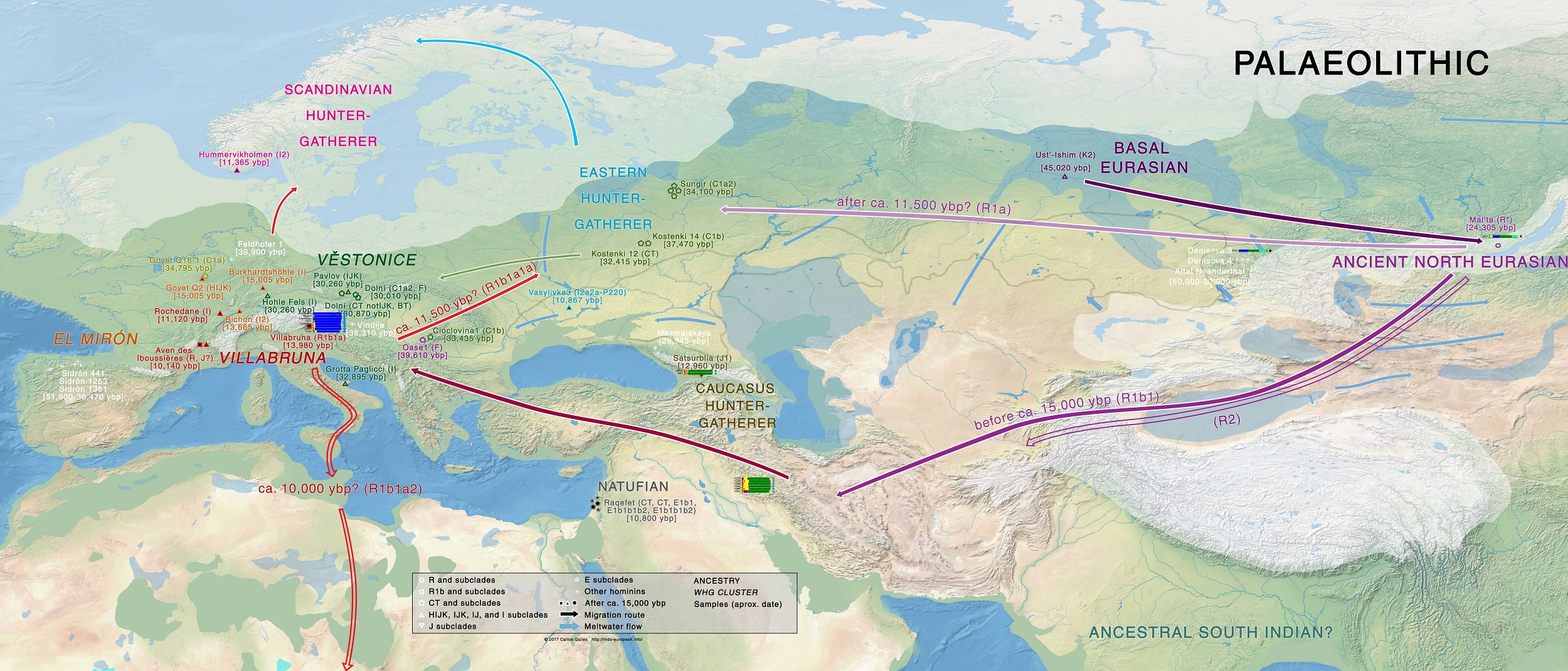
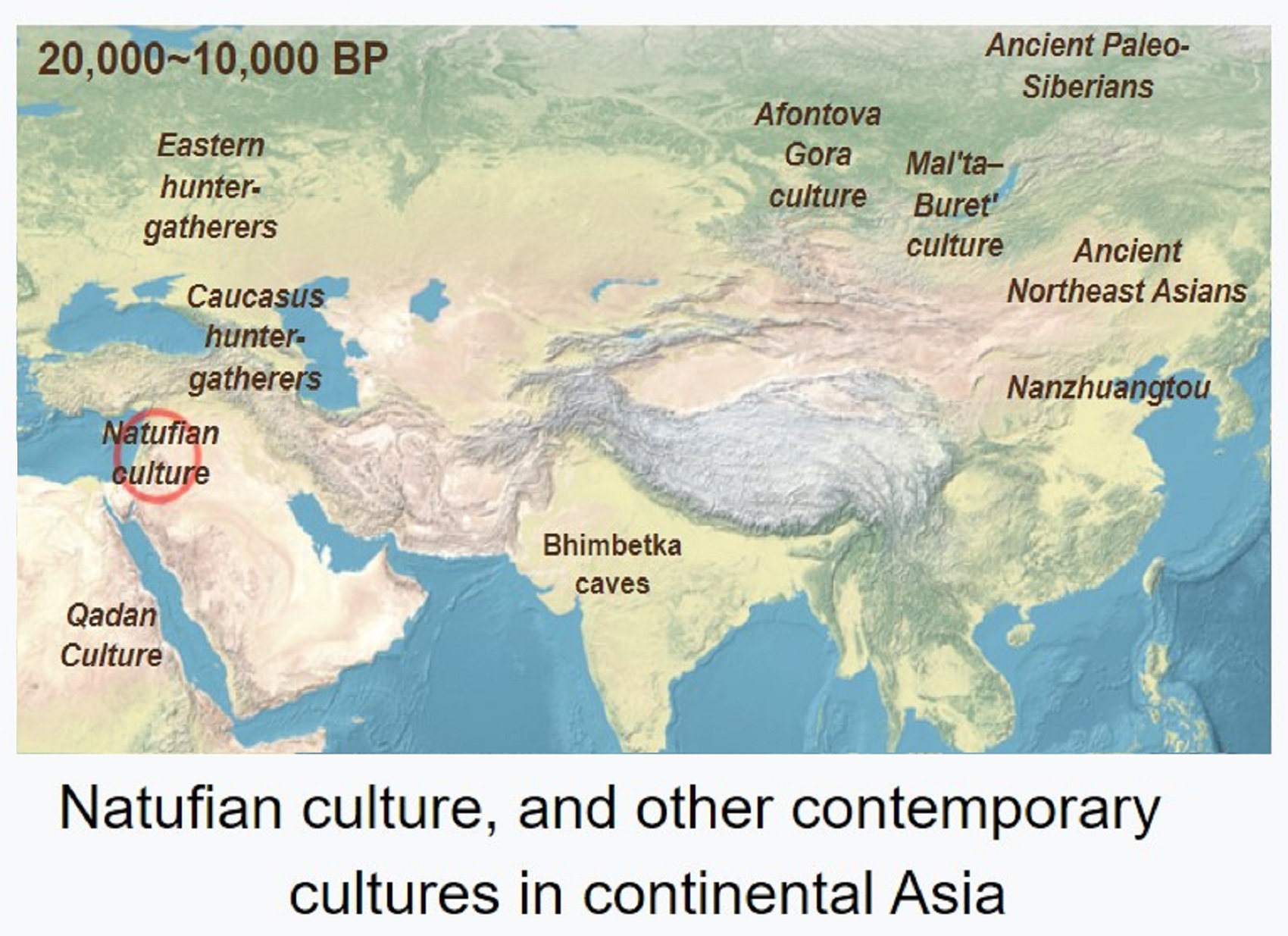
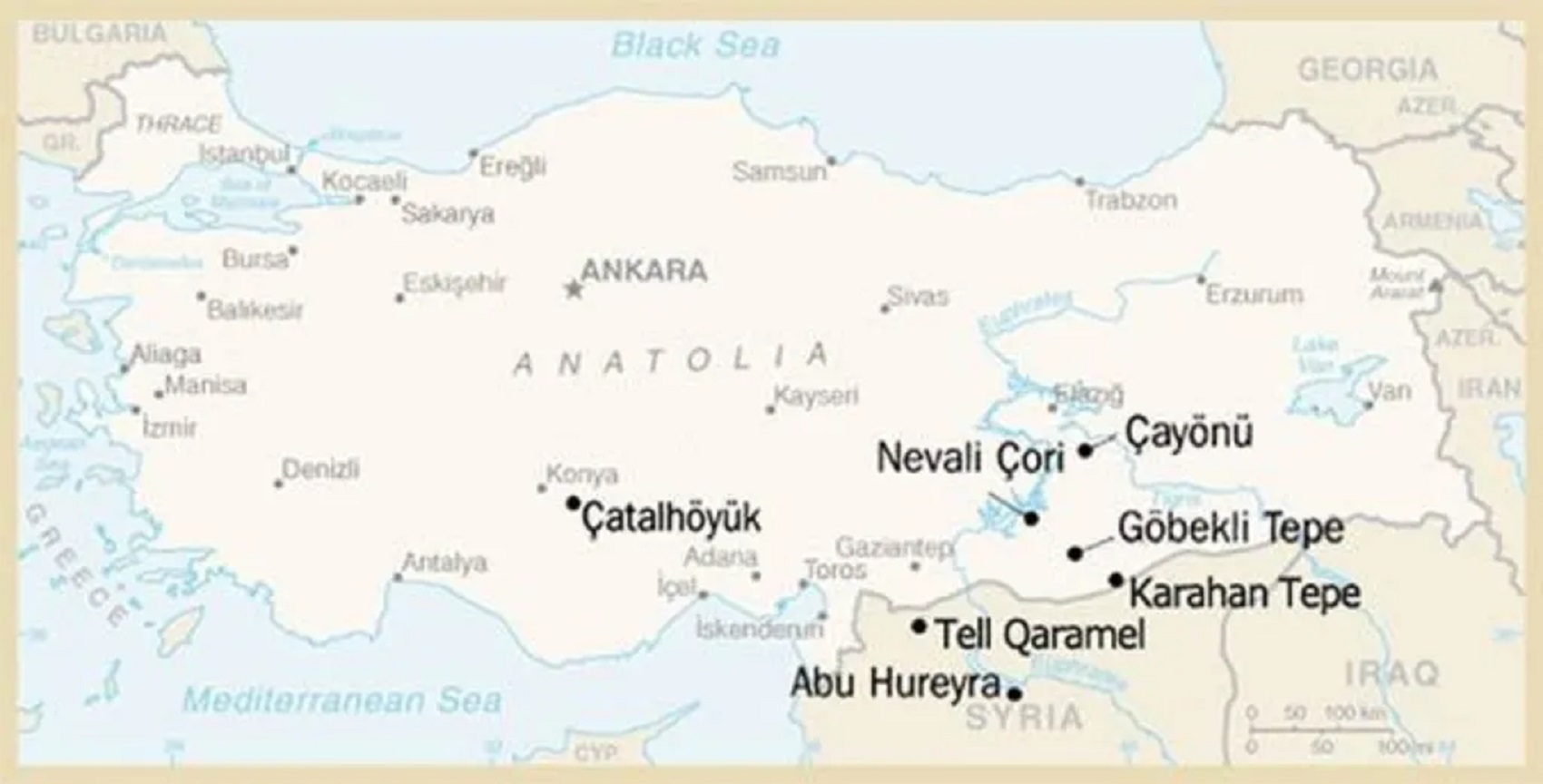

Fertile Crescent 12,500 – 9,500 Years Ago: fertility and death cult belief system?
12,400 – 11,700 Years Ago – Kortik Tepe (Turkey) Pre/early-Agriculture Cultic Ritualism
Kortik Tepe (Turkey) found mound structures, tombs, and grave goods as well as ritual art, demonstrating examples of the symbolic bee-carved stone ritual objects possibly representing a mythic creature(s). Ritualistic behavior is also found on the bones of ten individuals who exhibit cut marks that seem to indicate deflating along with an application of plaster and paint as part of the burial customs has been interpreted by some as corpse purification possibly to help the desist pass to the afterlife. Back to animal veneration, the specific bee idol motif appears early at Hallan Cemi, in southeastern Turkey. Each phase at Kortik Tepe which is also in southeastern Turkey, includes common religio-cultural features particularly true with the burial rites and grave goods.
Similar structures are known at Hallan Çemi, Demirköy in northwest Turkey, and the earliest layers of Çayonu in southeastern Turkey. Kortik Tepe is similar to Demirköy and other sites along the Batman River, which is a major tributary of the Tigris River, in southeast Turkey. Kortik Tepe demonstrated changing mortuary practices as time progressed, going from barring people outside the village to inside the village or structures, showing differences but still holding a shared cultural transfer. Even more interesting is how Hallan Cemi, burials of the dead are not found in the site at all, so perhaps they used a cemetery nearby, which is what happened with Zawi Chemi in northern Iraq, who used a cemetery nearby with 28 burials, 26 of which were associated with a stone platform and existed contemporary Levantine Natufian sites.
The Zawi Chemi site had evidence of far-reaching trade connections exhibited in obsidian that was found there but comes from the Lake Van region of southeastern Turkey. Similarly, the flint and obsidian tools found at Kortik Tepe connecting its culture to contemporary settlements such as Hallan Çemi, Demirköy, and Çayönü in the region and in some ways, its seeming religious themes with contemporaries among other Near East cultures and is one of the earliest manifestations of settled life but had obsidian likely from eastern Turkey, already points to the presence of trade in the region. Demirkoy which had way less obsidian that at Hallan Cemi and held less ritualistic significance in general having only two small canid burials and while the human burials maybe found in the Demirkoy site, it held only an occasional artifact and no grave goods.
As the Kortik Tepe site progressed the new onsite primary burial continues but started to contain valuable grave goods, often including numerous elaborately decorated stone bowls and multiple strands of stone beads all of which were buried with the dead. Ritual may take many forms such as intoxication which does produce an altered state. Along with this line of thinking there are the two stone vessels at Kortik Tepe seems to demonstrate alcohol production similar the finding of six large trough-shaped stone vessels hint at fermenting of grain from Gobekli Tepe in southeastern Turkey.
Turkey interestingly enough is home to both wild wheat and the first cultivated wheat 11,000 years ago originating from the Karacadag mountains in southeast Turkey, not too far from several archeological sites in Turkey with wheat, Cafer Hoyuk around 9600 to 8,200 years ago, Cayonu around 9,500 to 8,700 years ago, and Nevali Cori around 9,200 years ago. The Karacadag mountains with the earliest domestication of grain is near to Göbekli Tepe, possibly linking alcohol fermentation, religion and wheat domestication as use and consumption may have been involved in cultic/shamanistic feast celebrations. It seems wild wheat was still gathered but not yet cultivated at Hallan Cemi and Demirkoy and Gobekli Tepe. Wheat, which we may currently take for granted was once highly sacralized even somewhat supernaturally deified.
Though odd to present thinkers such cultic/shamanistic connection to wheat seems to have held some kind of sacred or ritualistic significance or was used (possibly fermented) practices in how deities related to fertility usually involve wheat like Tammuz, Kybele, Kubaba, Ceres, and Demeter. Tammuz (Turkish “Temmuz”) a Babylonian deity derived from Dumuzid (Sumerian: Zi(d), “faithful, true”) is similar to central Turkey’s people the Hittites whose word for wheat was “Ziz” with cultural connections to a current local Turkish name of wheat, siyez first utilized around 10,000 years ago. Moreover, from Catal Hoyuk and Cayonu in Turkey we can also trace the early stages of farming and female representations like that at Hacilar may possibly connect to some of the earliest traces of a goddess fertility cult. Catal Hoyuk seems to demonstrate the connected worship of sacred females may be a kind of spirit or cultic ancestor or goddess, maybe a mother or fertility figure along with possible sacred bulls.
It is thought that possibly the Goddess Kybele originates around the 9000 years ago, which is around the time of the settlement at Hacilar in southwestern Turkey, where ritual animal-shaped vessels can be found dating to at least around 8,600 years ago and almost every house held what seemingly could be goddess figurines. One such figure reclines dating to as old as 8,000 years ago holds a child and has traces of black paint on her hair and eyes.
An innovation around 7,500 years ago seems to have occurred at Hacilar involving the use of obsidian inlay for eyes and in one case for the navel. Similarly, animal vessels (possibly of a deity) continue to be made but start to have images of a seated and dressed female which could reference a goddess and at the same time figurines of animals appear when before they were rare. Further linking goddesses to grain is where some were found which was buried in grain bins such as wheat in Catal Hoyuk.
References 1, 2, 3, 4, 5, 6, 7, 8, 9, 10, 11, 12, 13
- ‘Sky Burial’ theory and its possible origins at least 12,000 years ago to likely 30,000 years ago or older.
- Sedentism and the Creation of goddesses around 12,000 years ago as well as male gods after 7,000 years ago.
- Paganism: Goddesses around 12,000 years ago then Male Gods after 7,000 years ago
- First Patriarchy: Split of Women’s Status around 12,000 years ago & First Hierarchy: fall of Women’s Status around 5,000 years ago.
- Natufians: an Ancient People at the Origins of Agriculture and Sedentary Life
- Pre-Pottery Neolithic Skull Cult around 11,500 to 8,400 Years Ago?
- Catal Huyuk “first religious designed city” around 9,500 to 7,700 years ago (Turkey)
- Fear of Wars Violence and the Creation of Male God: Hamangia culture around 7,250-6,500 years ago (Romania and Bulgaria)?
- The First Expression of the Male God around 7,000 years ago?
- Kurgan 6,000 years ago/dolmens 7,000 years ago: funeral, ritual, and other?
- Connected “dolmen phenomenon” of above-ground stone burial structures?
- 6,500–5,800 years ago in Israel Late Chalcolithic (Copper Age) Period in the Southern Levant Seems to Express Northern Levant Migrations, Cultural and Religious Transfer
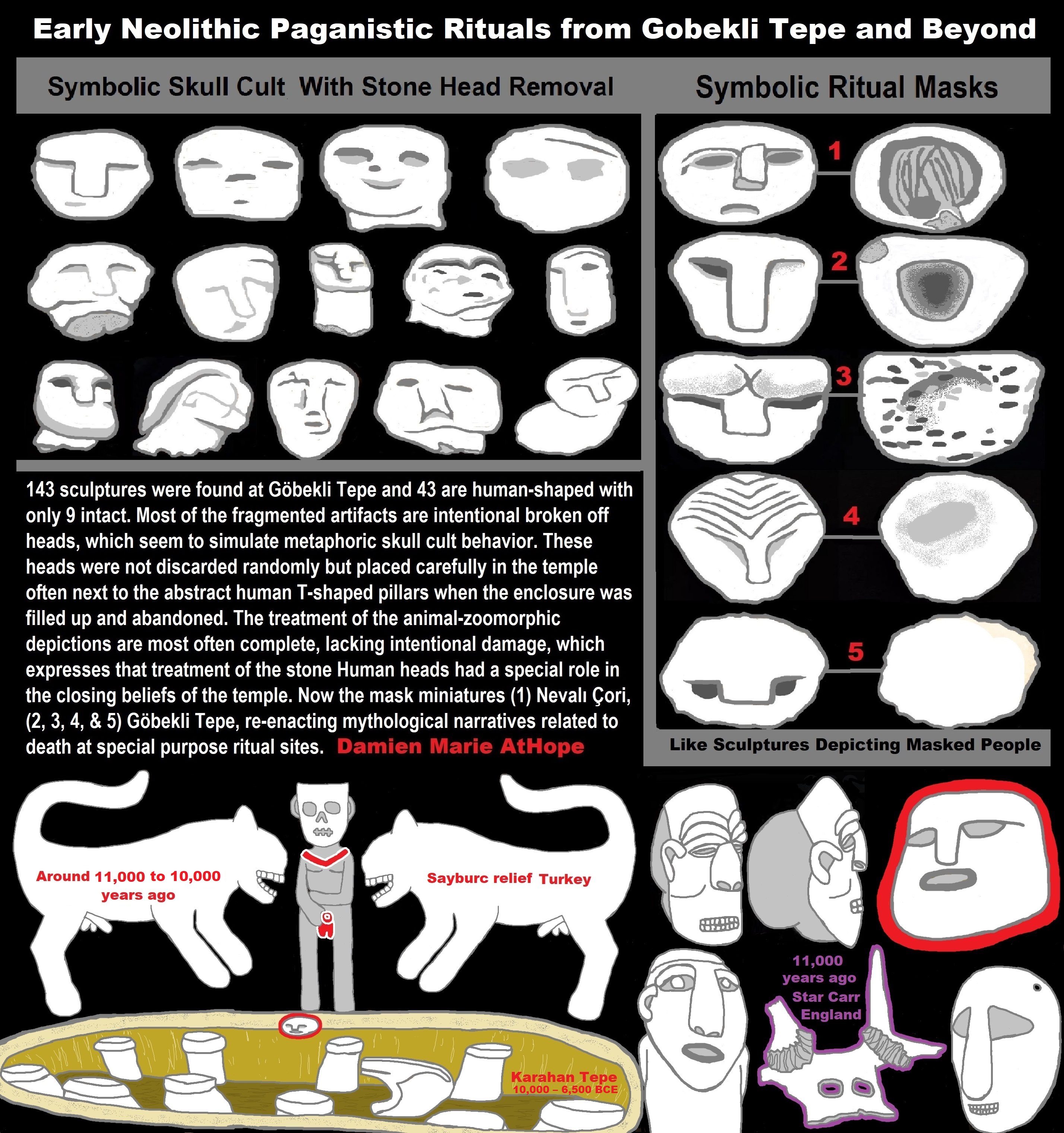
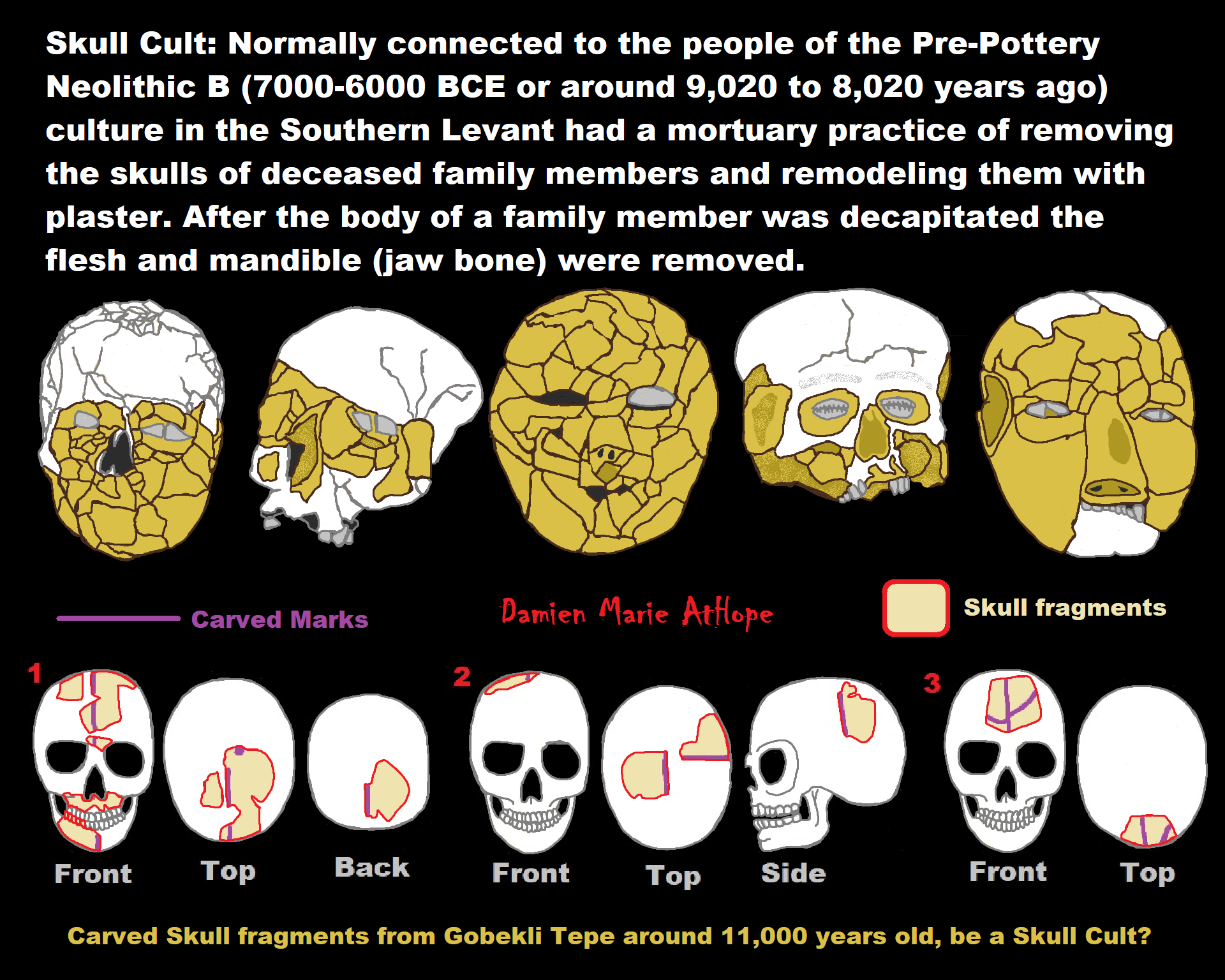
ref, ref, ref, ref, ref, ref, ref
“Most of the skulls belonged to older adults (which by the era’s standards meant around 40 years old). Both men and women could be selected to have their remains plastered, Khalaily adds, noting that at least one of the skulls at Yiftahel belonged to a female. According to Hamoudi Khalaily – an archaeologist with the Israel Antiquities Authority who excavated three plastered skulls at Yiftahel, a Neolithic site in the Galilee – most of these artifacts are found either in central public places or in “secondary burials”, that is, reburied separately from their body after many years of use. This fits the idea of an ancestor cult, Khalaily explains. As long as the ancestors were known and remembered, the artifacts were prominently displayed. But when their memory faded, they were reburied with honor and possibly replaced with the portraits of other elders.” ref
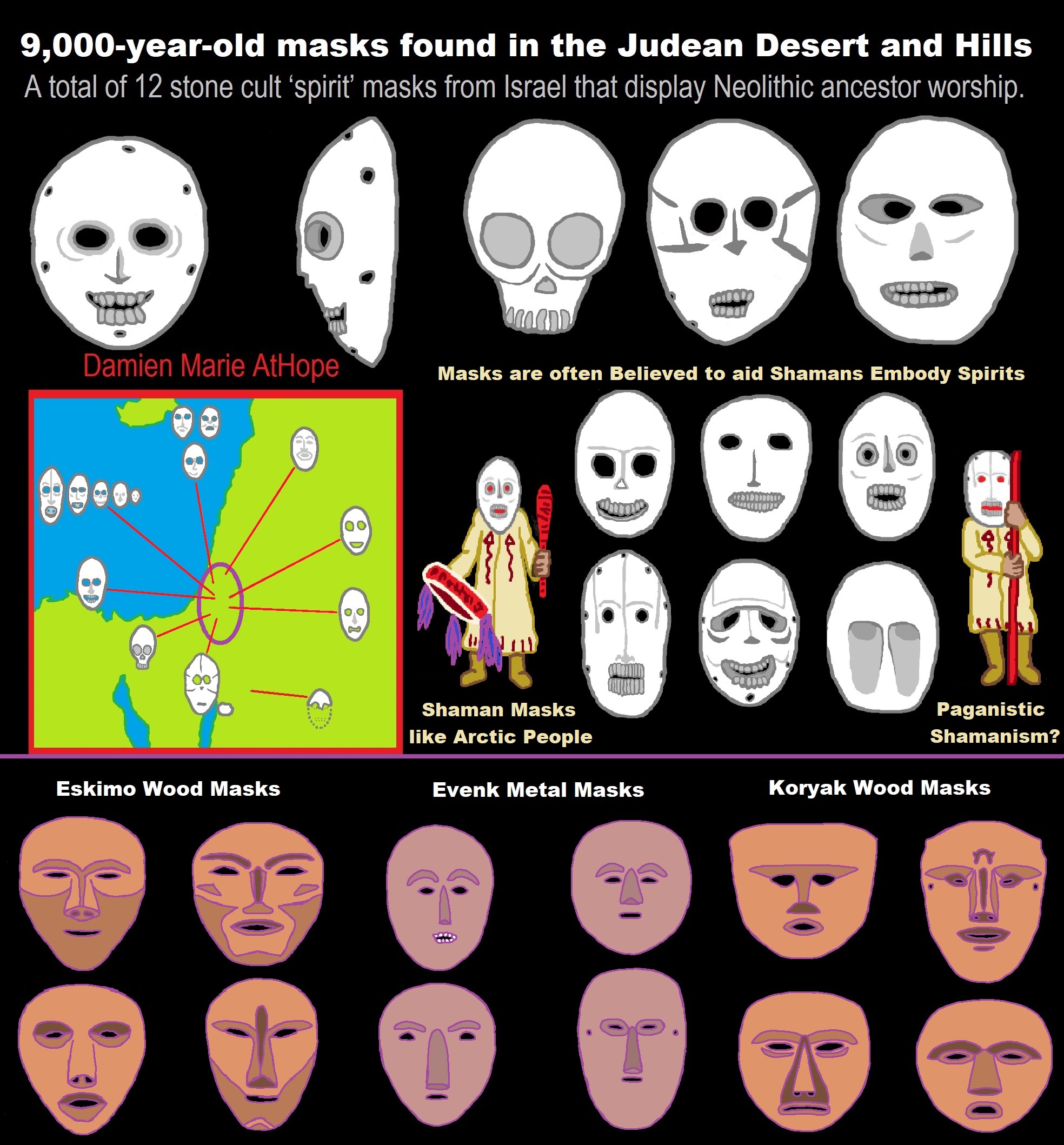

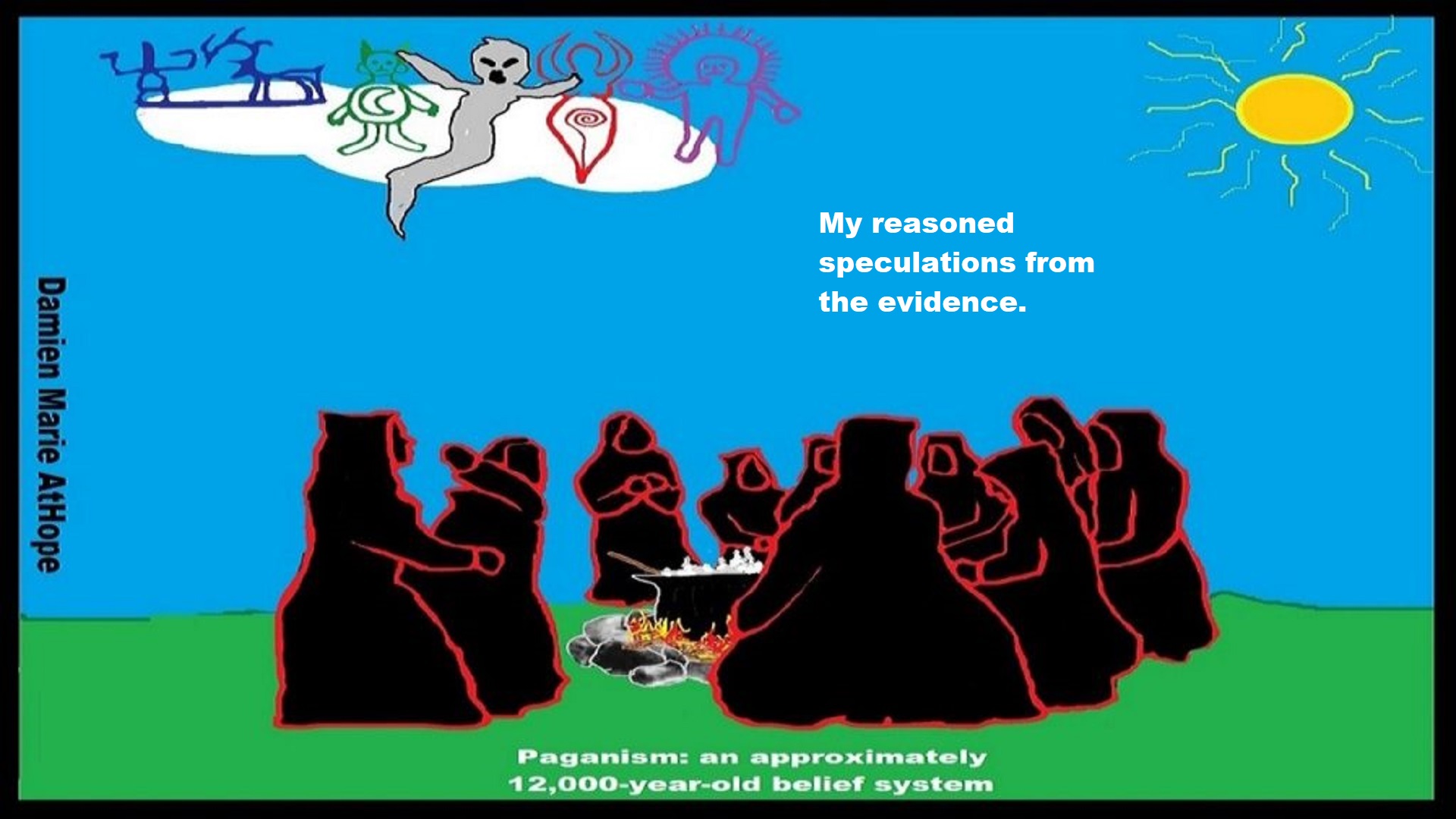
Paganism (beginning around 12,000 years ago)
Paganism is approximately a 12,000-year-old belief system and believe in spirit-filled life and/or afterlife that can be attached to or be expressed in things or objects and these objects can be used by special persons or in special rituals that can connect to spirit-filled life and/or afterlife and who are guided/supported by a goddess/god, goddesses/gods, magical beings, or supreme spirits. If you believe like this, regardless of your faith, you are a hidden paganist.
Around 12,000 years ago, in Turkey, the first evidence of paganism is Gobekli Tepe: “first human-made temple” and around 9,500 years ago, in Turkey, the second evidence of paganism is Catal Huyuk “first religious designed city”. In addition, early paganism is connected to Proto-Indo-European language and religion. Proto-Indo-European religion can be reconstructed with confidence that the gods and goddesses, myths, festivals, and form of rituals with invocations, prayers, and songs of praise make up the spoken element of religion. Much of this activity is connected to the natural and agricultural year or at least those are the easiest elements to reconstruct because nature does not change and because farmers are the most conservative members of society and are best able to keep the old ways.
The reconstruction of goddesses/gods characteristics may be different than what we think of and only evolved later to the characteristics we know of today. One such characteristic is how a deity’s gender may not be fixed, since they are often deified forces of nature, which tend to not have genders. There are at least 40 deities and the Goddesses that have been reconstructed are: *Pria, *Pleto, *Devi, *Perkunos, *Aeusos, and *Yama.
The reconstruction of myths can be connected to Proto-Indo-European culture/language and by additional research, many of these myths have since been confirmed including some areas that were not accessible to the early writers such as Latvian folk songs and Hittite hieroglyphic tablets. There are at least 28 myths and one of the most widely recognized myths of the Indo-Europeans is the myth, “Yama is killed by his brother Manu” and “the world is made from his body”. Some of the forms of this myth in various Indo-European languages are about the Creation Myth of the Indo-Europeans.
The reconstruction of rituals can be connected to Proto-Indo-European culture/language and is estimated to have been spoken as a single language from around 6,500 years ago. One of the earliest ritual is the construction of kurgans or mound graves as a part of a death ritual. kurgans were inspired by common ritual-mythological ideas. Kurgans are complex structures with internal chambers. Within the burial chamber at the heart of the kurgan, elite individuals were buried with grave goods and sacrificial offerings, sometimes including horses and chariots.
The speakers of Pre-Proto-Indo-European lived in Turkey and it associates the distribution of historical Indo-European languages with the expansion around 9,000 years ago, with a proposed homeland of Proto-Indo-European proper in the Balkans around 7,000 years ago. The Proto-Indo-European Religion seemingly stretches at least back around 6,000 years ago or likely much further back and I believe Paganism is possibly an approximately 12,000-year-old belief system.
The earliest kurgans date to 6,000 years ago and are connected to the Proto-Indo-European in the Caucasus. In fact, around 7,000 years ago, there appears to be pre-kurgan in Siberia. Around 7,000 to 2,500 years ago and beyond, kurgans were built with ancient traditions still active in Southern Siberia and Central Asia, which display the continuity of the archaic forming methods. Kurgan cultures are divided archaeologically into different sub-cultures such as Timber Grave, Pit Grave, Scythian, Sarmatian, Hunnish, and Kuman–Kipchak. Kurgans have been found from the Altay Mountains to the Caucasus, Ukraine, Romania, and Bulgaria. Around 5,000 years ago, kurgans were used in the Ukrainian and Russian flat unforested grasslands and their use spread with migration into eastern, central, northern Europe, Turkey, and beyond. ref, ref, ref, ref, ref, ref, ref, ref, ref, ref, ref, ref, & ref
Proto-Europe 8 000 – 5000 BC with ties to Anatolian Civilization and the Indo-European Language Spreads to Western Europe with Agriculture
“Proto-European Cultures 8,000-2,500 BC Interactive map of the Proto-European cultures in the Balkans. It is now assumed that the pre-Indo-European or Proto-European cultures which have evolved from rich archeological finds in the Greater Balkans, Greece and Sicily/Malta in the last 50 years go back to migrations from Anatolia. The archeological objects found in the Greater Balkans by Marija Gimbutas and others show a high sophistication in sculptures, ornaments, and grave culture. The “Proto-European Culture” in the Balkans and Greece is the oldest collective “civilization” known. They preceded Egypt by 4000 and China by 6000 years. Several large urban settlements (20 000 people) have been found, possibly under a female(?) priesthood.. The earliest temple cities have been unearthed in Göbekli (9200 BP) predating agriculture by 2000 years. The excavators believe that the large concentrations of laborers building the temples precipitated the need for agriculture.” ref
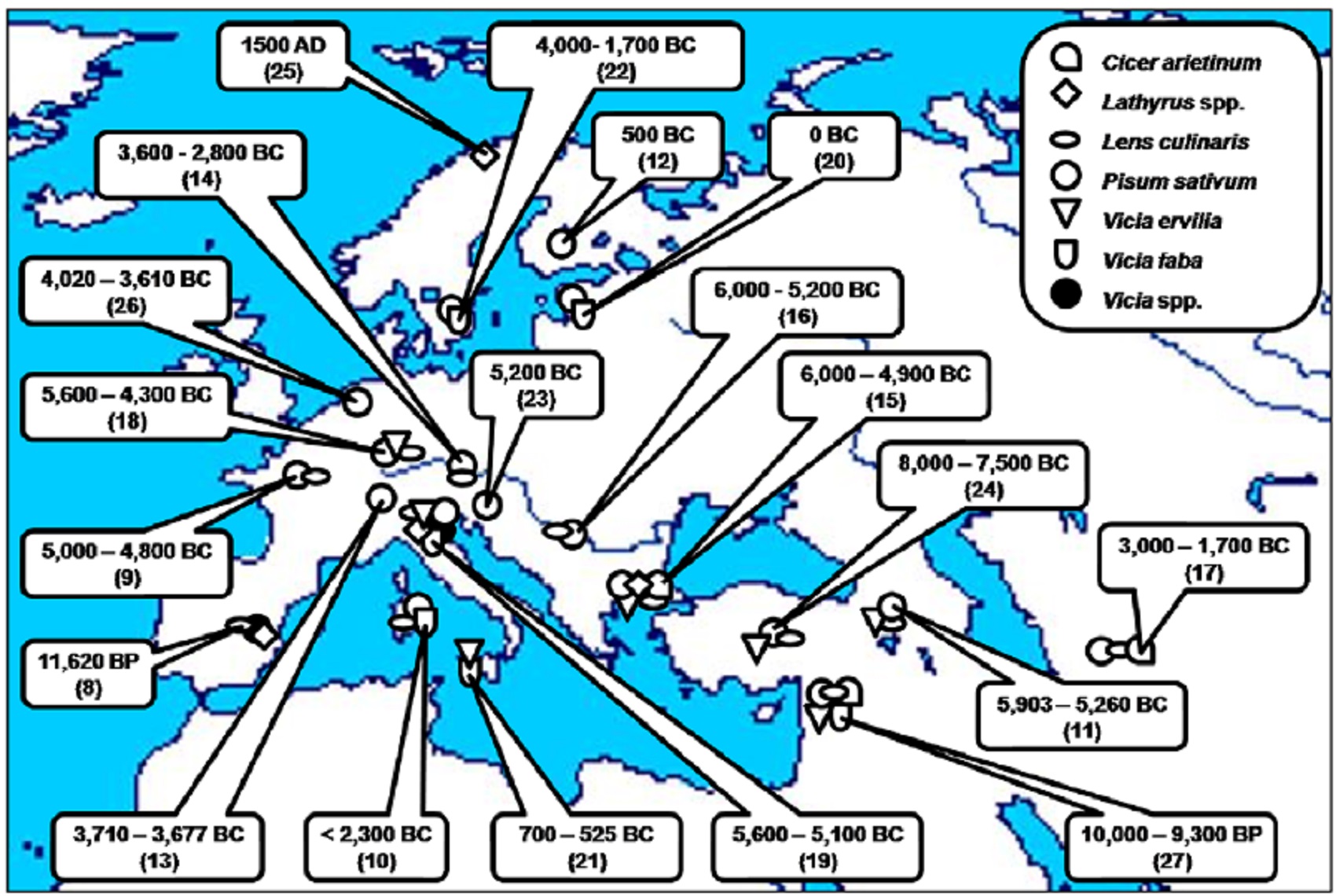
Abstract:
“This preliminary research was aimed at finding the roots in various Eurasian proto-languages directly related to pulses and giving the words denoting the same in modern European languages. Six Proto-Indo-European roots were indentified, namely arnk(‘)- (‘a leguminous plant’), *bhabh- (‘field bean’), * (‘a kernel of leguminous plant’, ‘pea’), ghArs- (‘a leguminous plant’), *kek- (‘pea’) and *lent- (‘lentil’). No Proto-Uralic root was attested save hypothetically *kača (‘pea’), while there were two Proto-Altaic roots, *bŭkrV (‘pea’) and *
(‘lentil’). The Proto-Caucasianx root *
denoted pea, while another one, *hōwł(ā) (‘bean’, ‘lentil’) and the Proto-Basque root *iłha-r (‘pea’, ‘bean’, ‘vetch’) could have a common Proto-Sino-Caucasian ancestor, *hVwłV (‘bean’) within the hypothetic Dené-Caucasian language superfamily. The Modern Maltese preserved the memory of two Proto-Semitic roots, *‘adaš- (‘lentil’) and *pūl- (‘field bean’). The presented results prove that the most ancient Eurasian pulse crops were well-known and extensively cultivated by the ancestors of all modern European nations. The attested lexicological continuum witnesses the existence of a millennia-long links between the peoples of Eurasia to their mutual benefit. This research is meant to encourage interdisciplinary concerted actions between plant scientists dealing with crop evolution and biodiversity, archaeobotanists, and language historians.” ref

Origin of the Words Denoting Some of the Most Ancient Old World Pulse Crops and Their Diversity in Modern European Languages
“Many pulses are, in fact, multifunctional crops that may be also used for animal feed, as green forage, forage dry matter (hay), forage meal, silage, haylage or straw, or as green manure: a valuable feature in contemporary trends such as organic farming and sustainable agriculture. Most traditional Eurasian pulses originated in either the Near Eastern centre of diversity, such as the pea, lentil, chickpea and common vetch ( Vicia sativa L.); or the Mediterranean, such as the grass pea, red vetchling ( Lathyrus cicera L.) and bitter vetch; or the Central Asian, such as the field bean. As other plant species used for food, pulses were first collected by hunter-gatherers. Among the oldest finds of pulses are those of lentil and bitter vetch in Franchthi cave in Greece, dated to about 11,000 BCE.” ref
“Pulses are also considered one of the first domesticated plant species, and thus the first crops, with much archaeobotanical evidence, mainly from present-day Syria. Together with cereals, pulses were part of the ‘agricultural revolution’ in post-glacial Europe, quickly spreading over the entire continent. Pulse seeds are more degradable than those of cereals and are usually found in smaller amounts, except in a few cases such as at Hissar in south Serbia, where thousands of charred pea and bitter vetch seeds were found, but almost no cereals. There has been a growing interest by molecular biologists in extracting ancient DNA (aDNA) from charred and other preserved old seeds, with recent reports on its success in the case of the pea and bitter vetch.” ref
“The European continent has always been rich in a linguistic sense: it is estimated that it is (or was) home to at least 300 extinct and living languages. The most widely-spoken family there is the Indo-European, with all its branches, namely Albanian, Armenian, Baltic, Celtic, Germanic, Hellenic, Indo-Iranian, Italic, and Slavic. It’s commonly regarded that the extinct and the living languages of all these branches had a common ancestor, usually referred to as Proto-Indo-European.” ref
“Although the exact position of the original homeland of the Proto-Indo-Europeans (i.e. the people who actually spoke Proto-Indo-European) still remains uncertain, the widely-accepted Kurgan hypothesis proposes it was the wide Pontic-Caspian steppe, from 4,500 BC to 2,500 BC, following which great migrations began in many directions over Europe and Asia, and Proto-Indo-European started to produce numerous derivatives. The Uralic language family descended from Proto-Uralic, most likely spoken on the eastern slopes of the Ural Mountains millennia ago. It developed into two branches, Finno-Ugric and Samoyedic, with the former spreading over northernmost Europe. Similarly, the Altaic language family slowly evolved from the Proto-Altaic, developing (most likely) in western regions of Siberia and diversifying into Turkic, Mongolic and a few other branches.” ref
The Caucasus is home to two more language families, namely Caucasian, also known as North Caucasian, and by some theories linked with the Basque language isolate into a Den ́-Caucasian superfamily (35), and Kartvelian, or South Caucasian, languages, with Georgian as the best-known representative. Finally, Maltese remains as the only genuinely European language belonging to the Semitic branch of the great Afro-Asiatic family (36). Viewing the said archaeobotanical and linguistic evidence the one in the light of the other, it might be assumed that the pulses were surely among the plant species, from both wild and agricultural floras, which were familiar to the ancestors of the modern European nations during their complex ethnic evolution.” ref
“The mechanisms underlying the genetic, ethnic and linguistic development of each of the great European language families are still far from explaining in a detailed and satisfactory way, and the frequent migrations of each, along with numerous mutual cultural contacts, make this issue even harder to comprehend. One must allow the possibility that the spectra of crop usages, and of words denoting such crops, were manifold. On arrival, newcomers could find cultivated the crop they themselves had grown in their old homeland, and either retain their original word or adopt a new one from the aboriginal population. Also, the introduction of a new technology, or a novel way of using an already cultivated crop, by a neighboring people could also introduce words that would replace old ones. In any event, common vocabularies related to diverse aspects of the everyday life of the ancestral members of one language family are still well preserved, albeit to a varying extent, by the Indo-European languages in particular.” ref
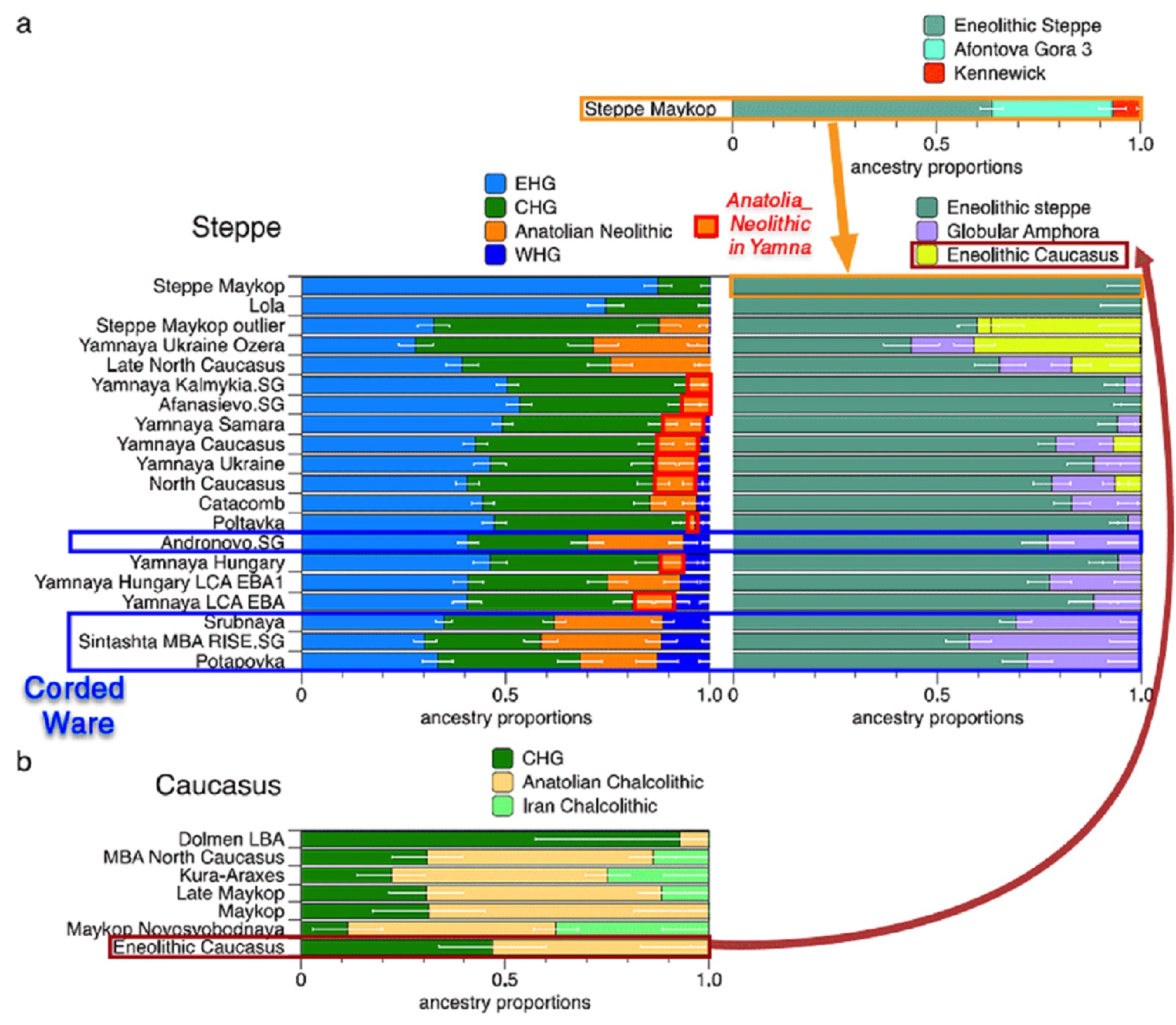
“Steppe ancestry” step by step: Khvalynsk, Sredni Stog, Repin, Yamna, Corded Ware
“The image above was modified from Wang et al. (2018). Marked are in orange: equivalent Steppe_Maykop ADMIXTURE; in red, approximate limit of Anatolia_Neolithic ancestry found in Yamna populations; in blue, Corded Ware-related groups. “Modelling results for the Steppe and Caucasus cluster. Admixture proportions based on (temporally and geographically) distal and proximal models, showing additional Anatolian farmer-related ancestry in Steppe groups as well as additional gene flow from the south in some of the Steppe groups as well as the Caucasus groups. And the arrows of “ancestry movement” in the following PCAs do not necessarily represent physical population movements, or even ethnolinguistic change. To avoid misinterpretations, there is depicted arrows with Y-DNA haplogroup migrations to represent the most likely true ethnolinguistic movements. Admixture graphics shown are from Wang et al. (2018), and also (the K12) from Mathieson et al. (2018). The so-called steppe ancestry was born during the Khvalynsk expansion through the steppes, probably through exogamy of expanding elite clans (eventually all R1b-M269 lineages) originally of Samara_HG ancestry.” ref
“The nearest group to the ANE-like ghost population with which Samara hunter-gatherers admixed is represented by the Steppe_Eneolithic / Steppe_Maykop cluster (from the Northern Caucasus Piedmont). Steppe_Eneolithic samples, of R1b1 lineages, are probably expanded Khvalynsk peoples, showing thus a proximate ancestry of an Early Eneolithic ghost population of the Northern Caucasus. Steppe_Maykop samples represent a later replacement of this Steppe_Eneolithic population – and/or a similar population with a further contribution of ANE-like ancestry – in the area some 1,000 years later. This admixture shows how different Steppe_Maykop is from Steppe_Eneolithic, but in the different supervised ADMIXTURE graphics below Maykop_Eneolithic is roughly equivalent to Eneolithic_Steppe (see orange arrow in ADMIXTURE graphic above). This is useful for a simplified analysis, but actual differences between Khvalynsk, Sredni Stog, Afanasevo, Yamna, and Corded Ware are probably underestimated and will become clearer in the future when more ancestral hunter-gatherer populations are added to the analysis.” ref
“Early Khvalynsk expansion is expressed in direct data of Khvalynsk-Novodanilovka-like populations thanks to Khvalynsk and Steppe_Eneolithic samples (although I’ve used the latter above to represent the ghost Caucasus population with which Samara_HG admixed).” ref
“Proto-Corded Ware expansion may relate to but is unclear if R1a-M459 subclades were continuously in the steppe and resurged after the Khvalynsk expansion, or (the most likely option) they came from the forested region of the Upper Dnieper area, possibly from previous expansions there with hunter-gatherer pottery. Supporting the latter is the millennia-long continuity of R1b-V88 and I2a2 subclades in the north Pontic Mesolithic, Neolithic, and Early Eneolithic Sredni Stog culture, until ca. 4500 BC (and even later, during the second half). Only at the end of the Early Eneolithic with the disappearance of Novodanilovka (and beginning of the steppe ‘hiatus’ of Rassamakin) is R1a to be found in Ukraine again (after disappearing from the record some 2,000 years earlier), related to complex population movements in the north Pontic area. And in the PCA, a tentative position of Novodanilovka closer to Anatolia_Neolithic / Dzudzuana ancestry is selected, based on the apparent cline formed by Ukraine_Eneolithic samples, and on the position and ancestry of Sredni Stog, Yamna, and Corded Ware later. A good alternative would be to place Novodanilovka still closer to the Balkan outliers (i.e. Suvorovo), and a source closer to EHG as the ancestry driven by the migration of R1a-M417.” ref
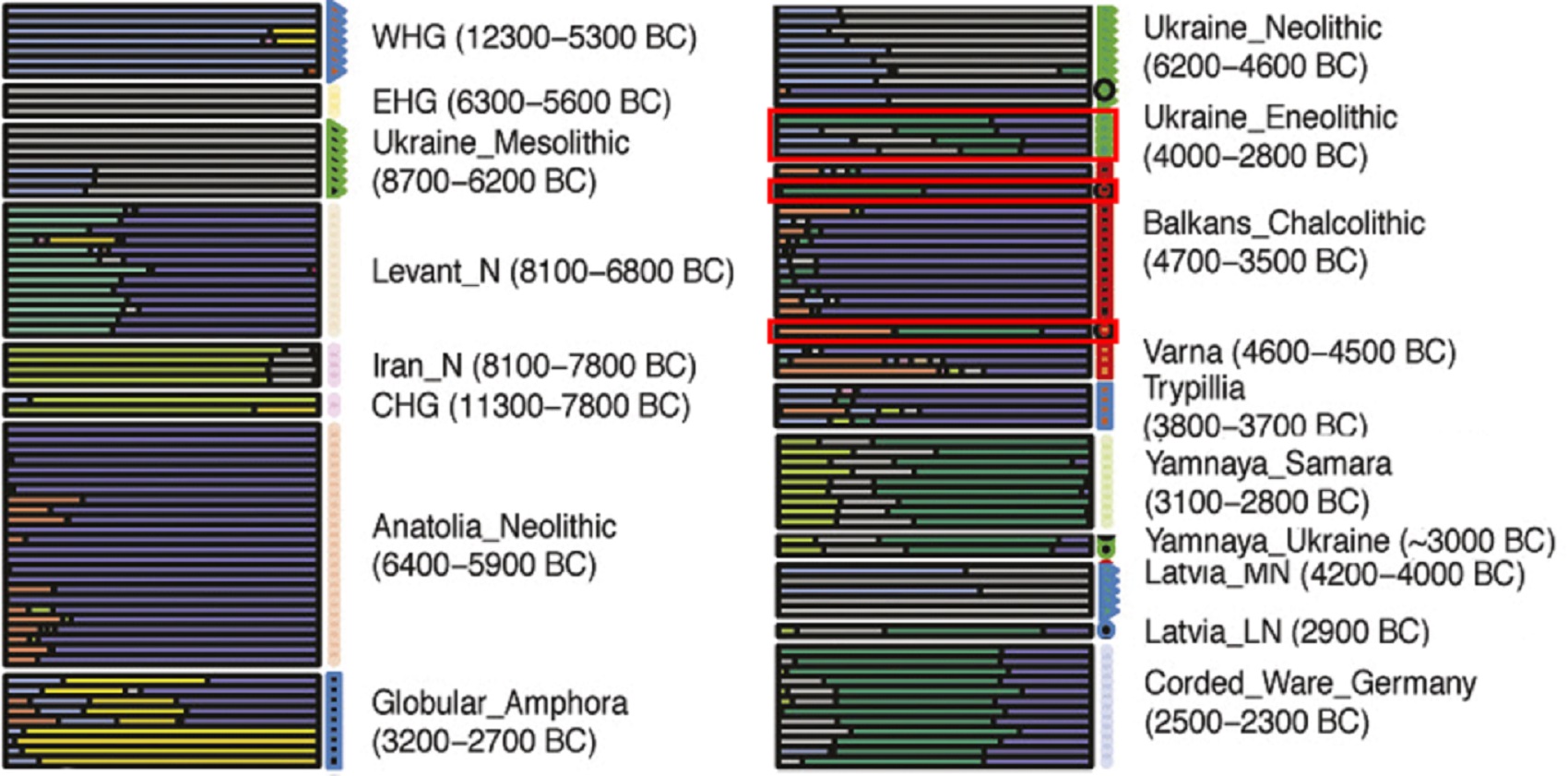
“The first sample with steppe ancestry appears only after 4250 BC in the forest-steppe, centuries after the samples with steppe ancestry from the Northern Caucasus and the Balkans, which points to exogamy of expanding R1a-M417 lineages with the remnants of the Novodanilovka population. And the Repin / Early Yamna expansion is not expressed in direct data on early Repin settlers. But we do have a very close representative: Afanasevo, a population we know comes directly from the Repin/late Khvalynsk expansion ca. 3500/3300 BC (just before the emergence of Early Yamna), and which shows fully Steppe_Eneolithic-like ancestry. Compared to this eastern Repin expansion that gave Afanasevo, the late Repin expansion to the west ca. 3300 BC that gave rise to the Yamna culture was one of colonization, evidenced by the admixture with north Pontic (Sredni Stog-like) populations, no doubt through exogamy. This admixture is also found (in lesser proportion) in east Yamna groups, which supports the high mobility and exogamy practices among western and eastern Yamna clans, not only with locals.” ref
“Corded Ware represents a quite homogeneous expansion of a late Sredni Stog population, compatible with the traditional location of Proto-Corded Ware peoples in the steppe-forest/forest zone of the Dnieper-Dniester region. Moreover, Yamna and Corded Ware show a similar “steppe ancestry” due to convergence. I have said so many times (see e.g. here). This was clear long ago, just by looking at the Y-chromosome bottlenecks that differentiate them – and this difference is seen in ADMIXTURE from the supplementary materials in Mathieson et al. (2017), well before Wang et al. (2018). This different stock stems from (1) completely different ancestral populations + (2)different, long-lasting Y-chromosome bottlenecks. Their similarities come from the two neighboring cultures admixing with similar populations.” ref
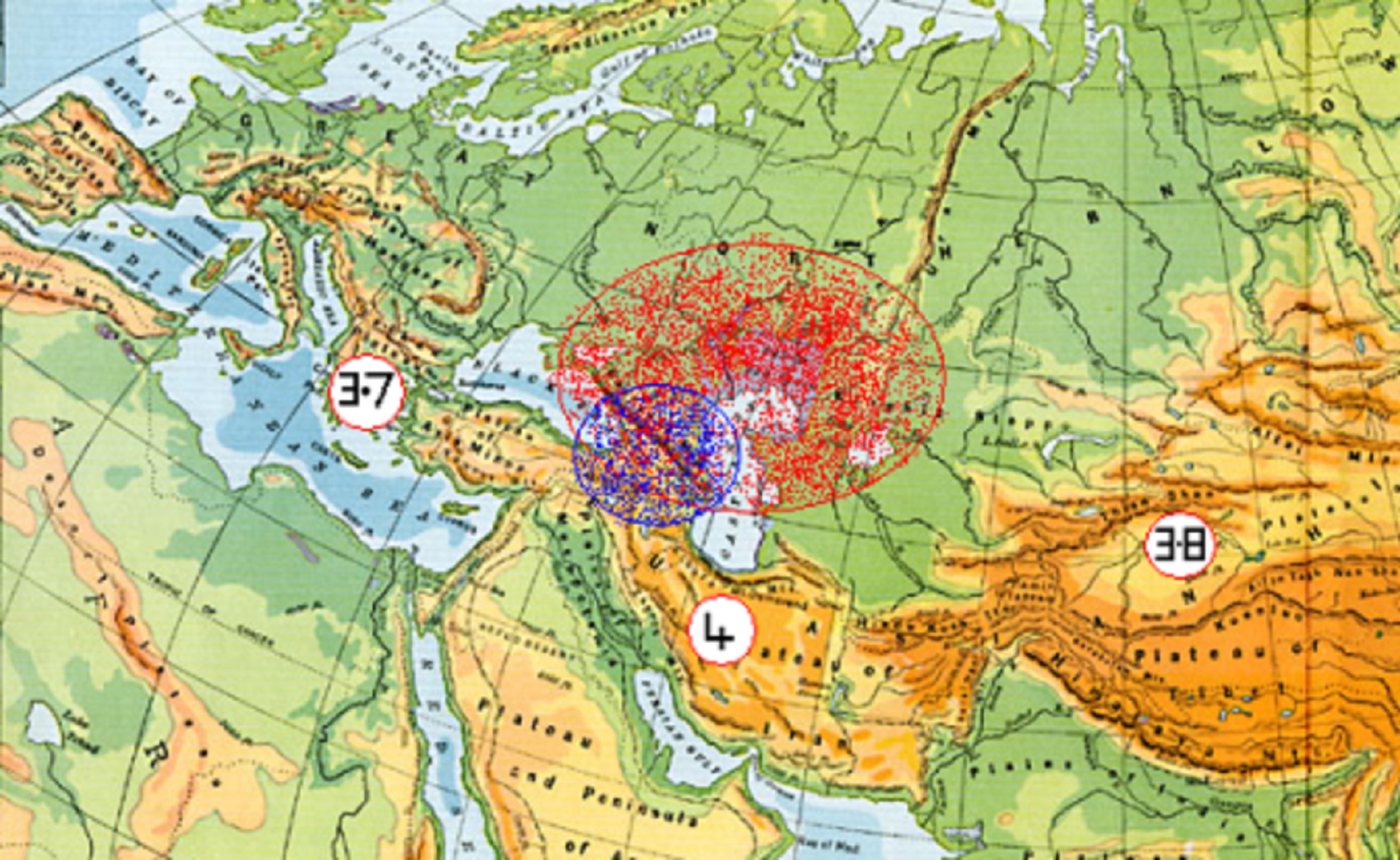
Horses, apples and proto-Indo-European
“The Red shaded area is my most likely area of origin solely from the dates and distances for the appearance of Indo-European languages at Mycenae, Takla Makan, and Persia. Proto-Indo-Iranian is thought to date to 4,500 BP in the Northern part of Iran. A slightly more southerly part of this area, the trans-Caucasus, would have been one of the first areas to have both the wheel and domesticated horses. They also had a mountainous terrain, and access to great quality arsenical copper.” ref
“This area is also mountainous; and home to willow, birch, yew, and hornbeam trees. It even has a leopard native to it (suggested but not proven as a PIE word). The best match for the flora seems to relate to the Black Sea coast of the trans-Caucasus area around Krasnodar, so pretty much the area that was picked for the Kurgan hypothesis, just slightly more into the mountainous areas to the South. The steppes areas may not be ideal in the more Northern possible zone as a homeland, as these wouldn’t account for the plethora of sea/boating related terms, or the trees, or the mountains. These people had plenty of words for mountain and boating, and the steppes, by their nature, are flat, fairly treeless and not easy to sail on.” ref
“It’s not clear cut that the expansion was solely due to direct military conquests as the wheel and horse combo giving them the edge in many areas; agriculture, trade, war… you name it, the cart/chariot has a lot of uses. Wherever Indo-Europeans arrive you see horses arrive at the same time. Seemingly there are possible connections to a culture dating from 5,500 to 5,000 years ago in the North trans-Caucasian area. There are a few possibilities, but the Maykop culture fits the time and place and geographical/flora and fauna perfectly. I’m investigating them today. So far I haven’t had a good look at the genetic evidence dated to the era, but that’s next on the list of things to check.” ref
Researching proto-Semitic seemingly shows:
- Proto-Semitic wasn’t African in origin (I never thought it was, but it’s a nice confirmation), and seems to have radiated out from Anatolia/Iran with the Neolithic expansion, with PIE neighbors.
- That Elamite (extinct Semitic) is related to Dravidian.
- Languages can expand almost explosively and can die out just as quickly.
- There’s probably a good reason for the Celtic languages having an Afro-Asiatic language structure, which has nothing to do with North Africa. It would seem quite possible that the first farmers who expanded into India and Europe all spoke an Afro-Asiataic language, which was then swallowed by IE (a mirror of what happened in India with Dravidian). ref

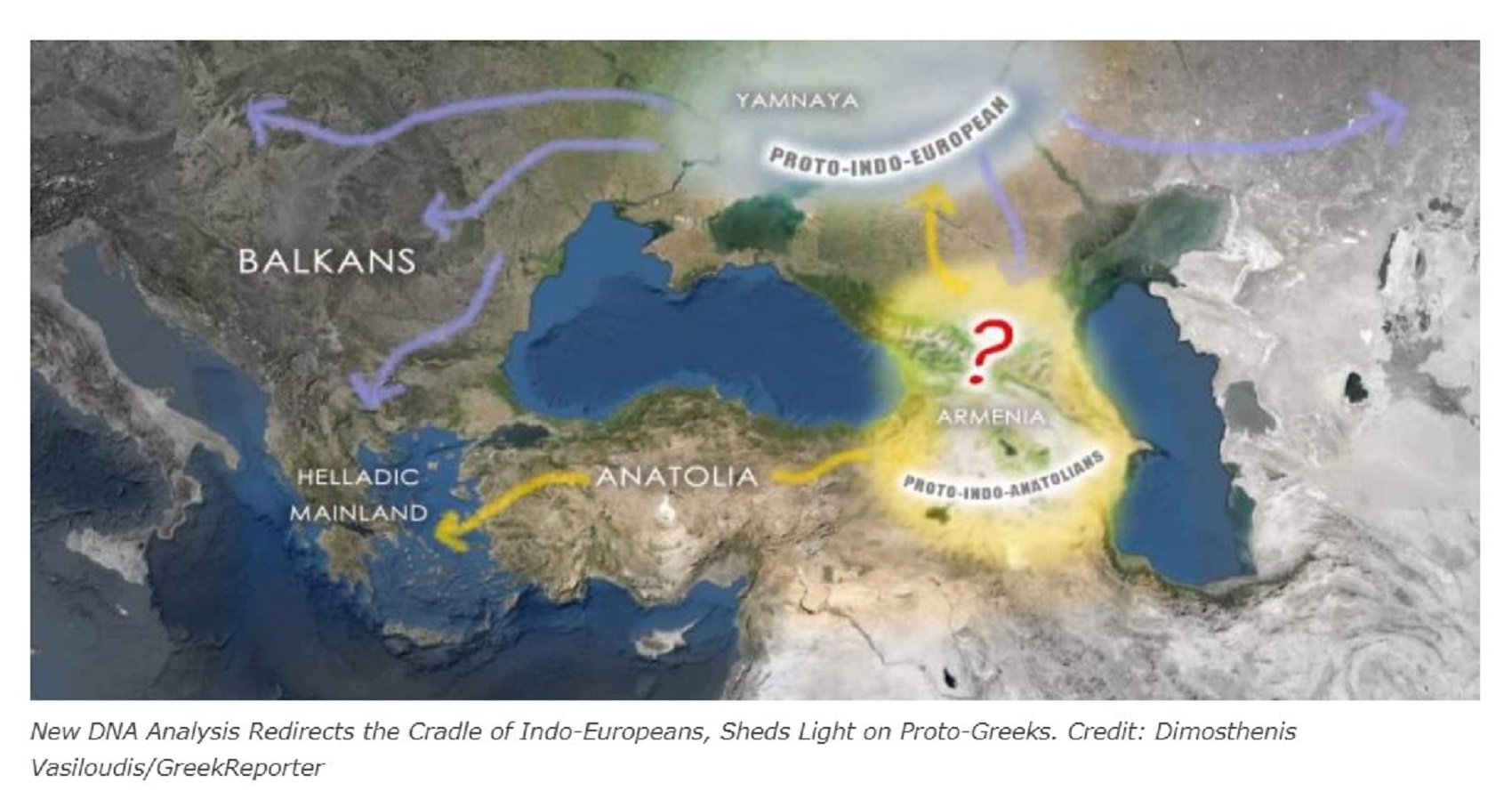
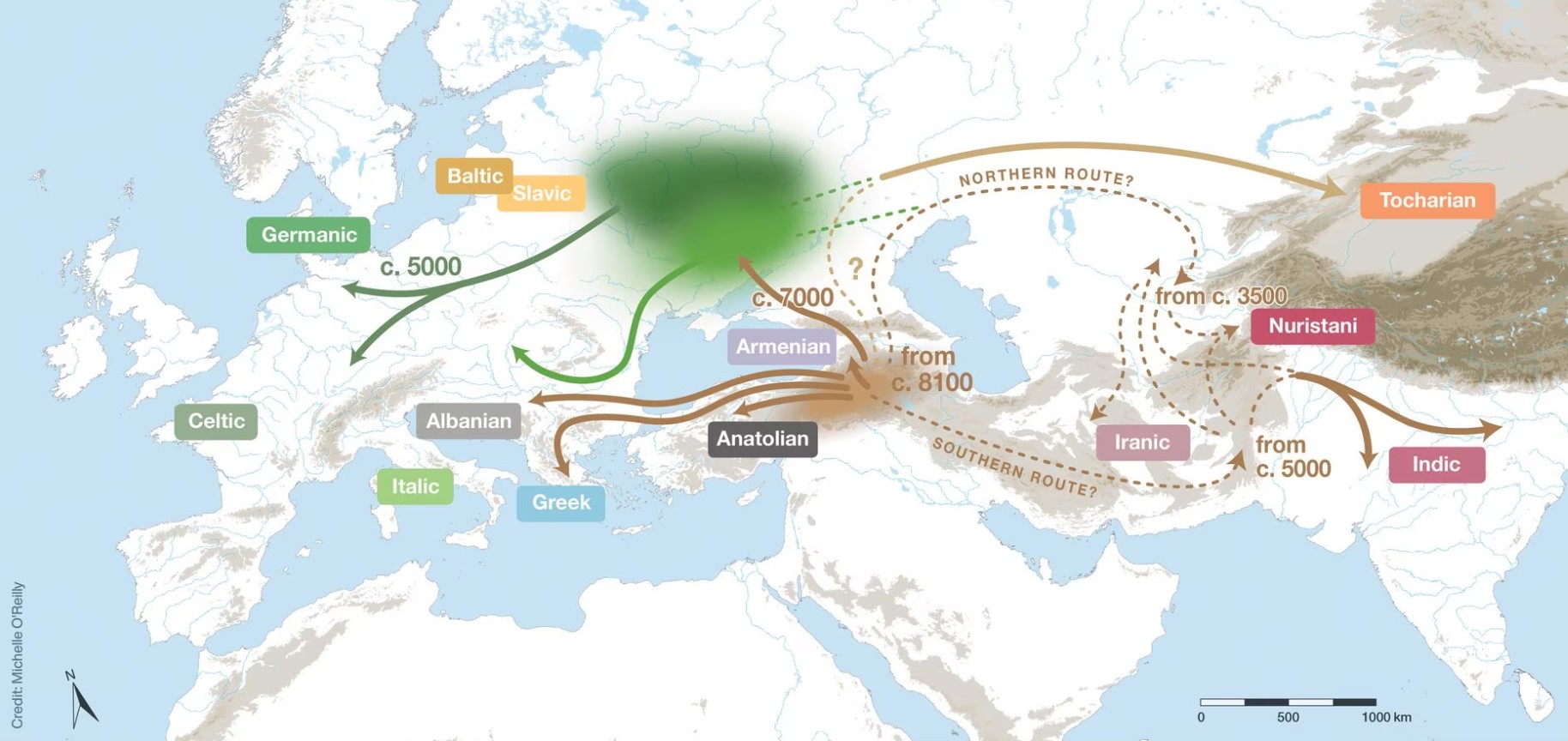
“Approximately 7,000 years ago, the Indo-European linguistic lineage had already split into numerous distinct branches, according to the study published in Science. “This would rule out the steppe hypothesis,” said Heggarty. Around 8,120 years ago, the Proto-Indo-European language likely experienced its initial diversification event, give or take a few centuries. Recent studies of ancient DNA suggest that farmers from the Caucasus region — between the Black Sea and Caspian Sea — migrated towards Anatolia, which supports the Anatolian theory. Hittite, an extinct language spoken by the Anatolian civilization, is another significant branch of the Indo-European family. For decades, a large group of linguists argued that Hittite was the common ancestor of the other Indo-European languages, with some even considering it to be the direct heir of Proto-Indo-European.” ref
“Ancient DNA, on the other hand, has provided compelling evidence in support of the steppe hypothesis. Since 2015, it has become clear that individuals originating from the Pontic steppe, situated to the south and northeast of present-day Russia, Ukraine, and Kazakhstan, migrated to Central Europe approximately 6,000 to 4,500 years ago. Their genetic legacy is evident in both modern Europeans and the indigenous populations of that era. Notably, studies conducted in 2018 and 2019 revealed how these migrant eastern populations replaced a significant proportion of males on the Iberian Peninsula. Furthermore, they brought with them Italic, Germanic, and Celtic languages. It is important to note that when they departed from their original homeland, they likely spoke a common or closely related language descended from Proto-Indo-European. However, as their very slow journey progressed (the Celts took centuries to reach present-day Ireland) and they settled in new territories, language diversification began to emerge.” ref
“The Albanians, Greek-speaking Mycenaeans, and Hittites do not have a dominant genetic signal from the steppe.” – Paul Heggarty, a researcher at the Max Planck Institute for Evolutionary Anthropology in Germany. Heggarty’s team made a significant contribution by shedding light on this question. By combining phylogenetic analysis of cognates with insights from ancient DNA, they found potentially two distinct origins. Expansion initially originated from the southern Caucasus region, resulting in the separation of five major language families approximately 7,000 years ago. “The Albanians, Greek-speaking Mycenaeans, and Hittites do not have a dominant genetic signal from the steppe,” said Heggarty. Several millennia later, another wave emerged, led by nomadic steppe herders from the north. This wave not only influenced the development of western branches of the language tree, but it also possibly played a role in the evolution of Slavic and Baltic languages. It even extended its influence to the Indian subcontinent, while giving rise to the now-extinct Tocharian languages in what is present-day Tibet.” ref
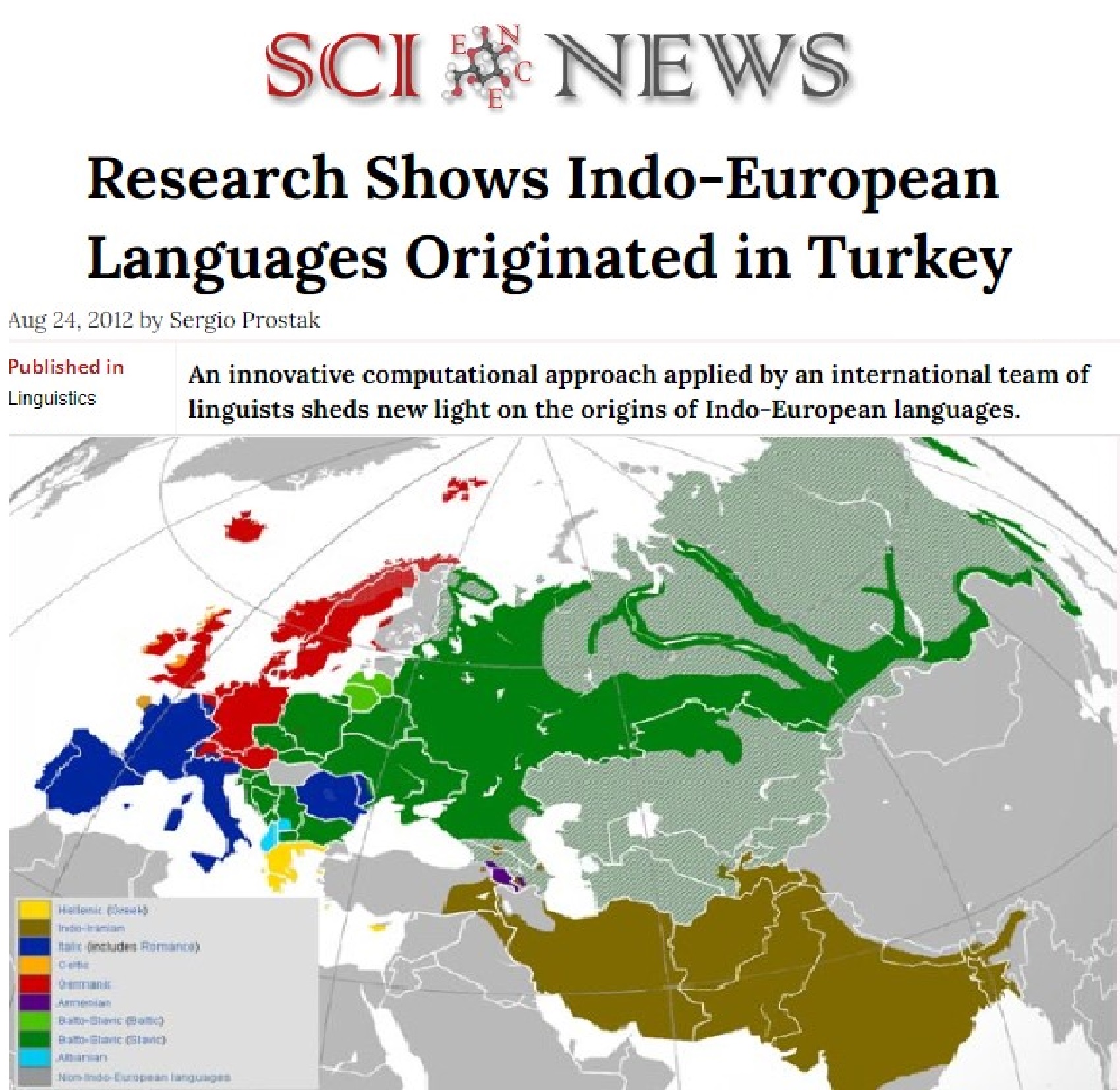
Research Shows Indo-European Languages Originated in Turkey (2012)
“The Indo-European languages belong to one of the widest spread language families of the world. For the last two millennia, many of these languages have been written, and their history is relatively clear. But controversy remains about the time and place of the origins of the family. The majority view in historical linguistics is that the homeland of Indo-European is located in the Pontic steppes – present-day Ukraine – around 6,000 years ago. The evidence for this comes from linguistic paleontology: in particular, certain words to do with the technology of wheeled vehicles are arguably present across all the branches of the Indo-European family; and archaeology tells us that wheeled vehicles arose no earlier than this date. The minority view links the origins of Indo-European with the spread of farming from Anatolia 8,000-9,500 years ago. The team’s innovative Bayesian phylogeographic analysis of Indo-European linguistic and spatial data, including basic vocabulary data from 103 ancient and contemporary Indo-European languages, decisively supports this theory. The linguists report their results in a paper in the journal Science.” ref
The Indo-European languages have a large number of branches:
Albanian, Anatolian, Armenian, Balto-Slavic, Celtic, Germanic, Greek, Indo-Iranian, Italic, and Tocharian.
“The Albanian language is the last branch of Indo-European languages to appear in written form. There are two hypotheses on the origin of Albanian. The first one says that Albanian is a modern descendant of Illyrian, a language which was widely spoken in the region during classical times. Since we know very little about Illyrian, this assertion can be neither denied nor confirmed from a linguistic standpoint. From a historical and geographical perspective, however, this assertion makes sense. Another hypothesis says that Albanian is a descendant of Thracian, another lost language that was spoken farther east than Illyrian. Today Albanian is spoken in Albania as the official language, in several other areas in of the former Yugoslavia and also in small enclaves in southern Italy, Greece and the Republic of Macedonia.” ref
“The Anatolian languages was predominant in the Asian portion of Turkey and some areas in northern Syria. The most famous of these languages is Hittite. In 1906 CE, a large amount of Hittite finds were made on the site of Hattusas, the capital of the Hittite Kingdom, where about 10,000 cuneiform tablets and various other fragments were found in the remains of a royal archive. These texts date back to the mid to late second millennium BCE. Luvian, Palaic, Lycian, and Lydian are other examples of families belonging to this group. All languages of this branch are currently extinct. This branch has the oldest surviving evidence of an Indo-European language, dated about 1800 BCE.” ref
“The Armenian language origins of the Armenian-speaking people is a topic still unresolved. It is probable that the Armenians and the Phrygians belonged to the same migratory wave that entered Anatolia, coming from the Balkans around the late 2nd millennium BCE. The Armenians settled in an area around Lake Van, currently Turkey; this region belonged to the state of Urartu during the early 1st millennium BCE. In the 8th century BCE, Urartu came under Assyrian control, and in the 7th century BCE, the Armenians took over the region. The Medes absorbed the region soon after and Armenia became a vassal state. During the time of the Achaemenid Empire, the region turned into a Persian satrap. The Persian domination had a strong linguistic impact on Armenian, which mislead many scholars in the past to believe that Armenian actually belonged to the Iranian group.” ref
“The five major Indo-European subfamilies—Balto-Slavic, Celtic, Germanic, Indo-Iranian, and Italic—all emerged as distinct lineages between 4000 to 6000 years ago, contemporaneous with a number of later cultural expansions evident in the archaeological record, including the Kurgan expansion.” ref
“The Balto-Slavic languages are a branch of the Indo-European family of languages. It traditionally comprises the Baltic and Slavic languages. Baltic and Slavic languages share several linguistic traits not found in any other Indo-European branch, which points to a period of common development. A Proto-Balto-Slavic language is reconstructable by the comparative method, descending from Proto-Indo-European by means of well-defined sound laws, and out of which modern Slavic and Baltic languages descended.” ref
“The Celtic languages are a group of related languages descended from Proto-Celtic, or “Common Celtic”; a branch of the greater Indo-Europeanfamily of languages. During the 1st millennium BCE, they were spoken across much of Europe, in the Iberian Peninsula, from the Atlantic and NorthSea coastlines, up to the Rhine valley and down the Danube valley to the Black Sea, the northern Balkan Peninsula and in central Asia Minor. The spread to Cape Breton and Patagonia occurred in modern times.” ref
“The Germanic languages are a branch of the Indo-European language family spoken natively by a population of about 515 million people] mainly in Europe, North America, Oceania, and Southern Africa. The common ancestor of all of the languages in this branch is called Proto-Germanic, also known as Common Germanic, which was spoken in about the middle of the 1st millennium BCE in Iron Age Scandinavia. Early varieties of Germanic entered history with the Germanic tribes moving south from Scandinavia in the 2nd century BCE, to settle in the area of today’s northern Germany and southern Denmark. All Germanic languages are thought to be descended from a hypothetical Proto-Germanic, united by subjection to the sound shifts of Grimm’s law and Verner’s law. These probably took place during the Pre-Roman Iron Age of Northern Europe from c. 500 BCE. Proto-Germanic itself was likely spoken after c. 500 BCE, and Proto-Norse from the 2nd century CE and later is still quite close to reconstructed Proto-Germanic, but other common innovations separating Germanic from Proto-Indo-European suggest a common history of pre-Proto-Germanic speakers throughout the Nordic Bronze Age. The West Germanic languages include the three most widely spoken Germanic languages: English, German, and Dutch, as well as Afrikaans, an offshoot of Dutch. In addition, to Low German, Yiddish–Jews and Scots, both Limburgish varieties along the Dutch–Belgian–German border; and the Frisian languages in the Netherlands and Germany. The main North Germanic languages are Danish, Faroese, Icelandic, Norwegian, and Swedish. The East Germanic branch included Gothic, Burgundian, and Vandalic, all of which are now extinct. The last to die off was Crimean Gothic, spoken until the late 18th century in some isolated areas of Crimea.” ref
“The Indo-Iranian languages, Indo-Iranic languages, or Aryan languages constitute the largest and southeasternmost extant branch of the Indo-Europeanlanguage family. It has more than 1.5 billion speakers, stretching from Europe (Romani), Turkey (Kurdish and Zaza–Gorani), and the Caucasus (Ossetian) eastward to Xinjiang(Sarikoli) and Assam (Assamese), and south to Sri Lanka(Sinhalese) and the Maldives (Maldivian). Furthermore, there are large communities of Indo-Iranian speakers in northwestern Europe (the United Kingdom), North America, and Australia. The common ancestor of all of the languages in this family is called Proto-Indo-Iranian—also known as Common Aryan—which was spoken in approximately the late 3rd millennium BC. The three branches of the modern Indo-Iranian languages are Indo-Aryan, Iranian, and Nuristani. Additionally, sometimes a fourth independent branch, Dardic, is posited, but recent scholarship in general places Dardic languages as archaic members of the Indo-Aryan branch. The common proto-language of the Indo-Iranian languages is Proto-Indo-Iranian, which has been reconstructed. The oldest attested Indo-Iranian languages are Vedic Sanskrit(ancient Indo-Aryan), Older and Younger Avestan, and Old Persian(ancient Iranian languages). A few words from another Indo-Aryan language (see Indo-Aryan superstrate in Mitanni) are attested in documents from the ancient Mitanni and Hittite kingdoms in the Near East.” ref
“The Italic languages are a branch of the Indo-European language family, originally spoken by Italic peoples. They include Latin and its descendants (the Romance languages), as well as a number of extinct languages of the Italian Peninsula, including Umbrian, Oscan, Faliscan, South Picene, and possibly Venetic and Sicel. The Italic languages are one of the ten or eleven major subgroups of the Indo-European language family and might, therefore, have had an ancestor, Common Italic or Proto-Italic, from which its daughter languages descended. Moreover, there are similarities between major groups, but the interpretation of these similarities is one of the major debated issues in the historical linguistics of Indo-European. The Italic peoples came from the north to the Italian Peninsula in the 2nd millennium BCE. There were two waves – an earlier one (the Latino-Faliscan languages, including Sicel, which has gone far to the south) and later (the Osco-Umbrian languages). Previously, it was customary to identify the first wave with the Terramare culture, and the second one with the Proto-Villanovan culture; modern archaeologists point to more complex processes. The Italic languages share a certain number of isoglosses and common phonetic changes with respect to the common Proto-Indo-European.” ref
“And, finally, the Tocharian or Tokharian language which is an extinct branch of the Indo-European language family. It is known from manuscripts dating from the 6th to the 8th century AD, which were found in oasis cities on the northern edge of the Tarim Basin (now part of Xinjiang in northwest China). The existence of the Tocharian languages and alphabet was not even suspected until the archaeological exploration of the Tarim basin in northwest China. Located in China’s Xinjiang region, with the Taklamakan Desert dominates much of the basin. Of note, in the Tarim basin, ancient boats were used for burials. The earliest inhabitants of the Tarim Barin may be the Tocharians whose languages are the easternmost group of Indo-European languages. Caucasoid mummies have been found in various locations in the Tarim Basin such as Loulan, the Xiaohe Tomb complex, and Qäwrighul. These mummies have been suggested to be of Tocharian origin, and these people may have inhabited the region since at least 1800 BCE. They may be related to the “Yuezhi” mentioned in Chinese texts. Protected by the Taklamakan Desert from steppe nomads, elements of Tocharian culture survived until the 7th century, at the dawning of the 800s with the arriving Turkic immigrants from the collapsing Uyghur Khaganate of modern-day Mongolia began to absorb the Tocharians to form the modern-day Uyghur ethnic group. Another people in the region besides Tocharian, are the Indo-Iranian Saka people who spoke various Eastern IranianKhotanese Scythian or Saka dialects. In the Achaemenid-era Old Persian inscriptions found at Persepolis, dated to the reign of Darius I (r. 522-486 BCE), the Saka are said to have lived just beyond the borders of Sogdiana. Likewise, an inscription dated to the reign of Xerxes I (r. 486-465 BCE) has them coupled with the Dahaepeople of Central Asia. The contemporary Greek historian Herodotus noted that the Achaemenid Persians called all of the Indo-Iranian Scythian peoples as the Saka. They were known as the Sai in ancient Chinese records. These records indicate that they originally inhabited Ili and Chu River valleys of modern Kazakhstan. In the Chinese Book of Han, the area was called the “land of the Sai”, i.e. the Saka. The presence of a people believed to be Saka has also been found in various locations in the Tarim Basin, for example in the Keriya region at Yumulak Kum (Djoumboulak Koum, Yuansha) around 200 km east of Khotan, with a tomb dated to as early as the 7th century BC.” ref
Bronze-Age Populations in Caucasus Region Studied
“According to a Genome Web report, a study of the genomes of 45 people who lived between 6,500 and 3,500 years ago throughout the Caucasus region indicates that they were genetically similar to each other, even though the artifacts they left behind suggest they lived in distinct cultural groups. The Caucasus region stretches from the Black Sea to the Caspian Sea, and includes part or all of what is now Russia, Azerbaijan, Armenia, Georgia, Iran, and Turkey. Wolfgang Haak of the Max Planck Institute for the Science of Human History suggested that Bronze Age farmers living in the southern Caucasus likely spread north over the mountains, where they met nomads from the Eurasian steppe, some of whom were related to Yamnaya groups to the northwest. Other steppe-dwellers, such as the Steppe Maykop, had genes resembling those found in Paleolithic Siberians, ancient Native Americans, and modern North Asians, he said. Some of these groups met in an interaction zone, where they were likely to have exchanged genes along with cultural, technological, and social innovations such as effective metal weapons, the wheel, and the wagon. To read about a slightly more recent culture from the Caucasus, go to “Rites of the Scythians.” ref
The History and Expansion of Grapes and Wine Relating to the Caucasus
“In Europe, wild grape (Vitis vinifera) pips have been found in fairly ancient contexts, such as Franchthi Cave, Greece (12,000 years ago), and Balma de l’Abeurador, France (about 10,000 years ago). But evidence for domesticated grapes is later than that of the East Asia, but similar to that of the western Asia grapes.” ref
“In China. Residues on pottery sherds from the Chinese early Neolithic site of Jiahu have been recognized as coming from a fermented beverage made of a mixture of rice, honey, and fruit, radiocarbon dated to ~9,000–8,600 years ago. The presence of fruit was identified by the tartaric acid/tartrate remnants in the bottom of a jar, familiar to anyone who drinks wine from corked bottles today. Researchers could not narrow the species of the tartrate down between grape, hawthorn, or longyan or cornelian cherry, or a combination of two or more of those. Grape seeds and hawthorn seeds have both been found at Jiahu.” ref
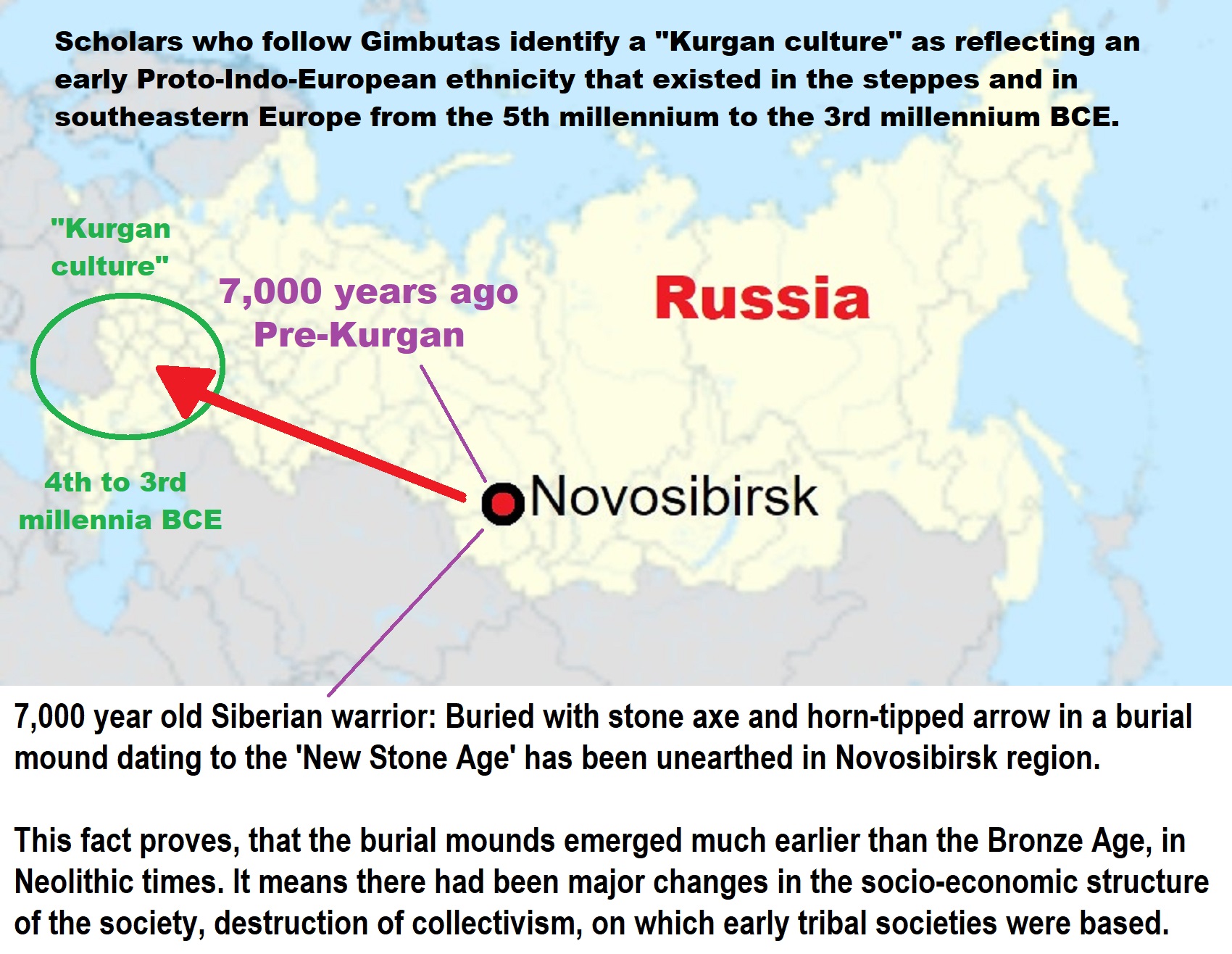
Kurgan Hypothesis
“The Kurgan hypothesis (also known as the Kurgan theory or Kurgan model) or Steppe theory is the most widely accepted proposal to identify the Proto-Indo-European homeland from which the Indo-European languages spread out throughout Europe and parts of Asia. It postulates that the people of a Kurgan culture in the Pontic steppe north of the Black Sea were the most likely speakers of the Proto-Indo-European language (PIE). The term is derived from the Russian kurgan (курга́н), meaning tumulus or burial mound. The Steppe theory was first formulated by Otto Schrader (1883) and V. Gordon Childe (1926), then systematized in the 1950s by Marija Gimbutas, who used the term to group various prehistoric cultures, including the Yamnaya (or Pit Grave) culture and its predecessors. In the 2000s, David Anthony instead used the core Yamnaya culture and its relationship with other cultures as a point of reference.” ref
“Gimbutas defined the Kurgan culture as composed of four successive periods, with the earliest (Kurgan I) including the Samara and Seroglazovo cultures of the Dnieper–Volga region in the Copper Age (early 4th millennium BCE). The people of these cultures were nomadic pastoralists, who, according to the model, by the early 3rd millennium BCE had expanded throughout the Pontic–Caspian steppe and into Eastern Europe. Recent genetics studies have demonstrated that populations bearing specific Y-DNA haplogroups and a distinct genetic signature expanded into Europe and South Asia from the Pontic-Caspian steppe during the third and second millennia BCE. These migrations provide a plausible explanation for the spread of at least some of the Indo-European languages, and suggest that the alternative Anatolian hypothesis, which places the Proto-Indo-European homeland in Neolithic Anatolia, is less likely to be correct.” ref
“Cultures that Gimbutas considered as part of the “Kurgan culture”:
- Bug–Dniester (6th millennium)
- Samara (5th millennium)
- Khvalynsk (5th millennium)
- Dnieper–Donets (5th to 4th millennia)
- Sredny Stog (mid-5th to mid-4th millennia)
- Maikop–Dereivka (mid-4th to mid-3rd millennia)
- Yamnaya (Pit Grave): This is itself a varied cultural horizon, spanning the entire Pontic–Caspian steppe from the mid-4th to the 3rd millennium.
- Usatovo culture (late 4th millennium)” ref
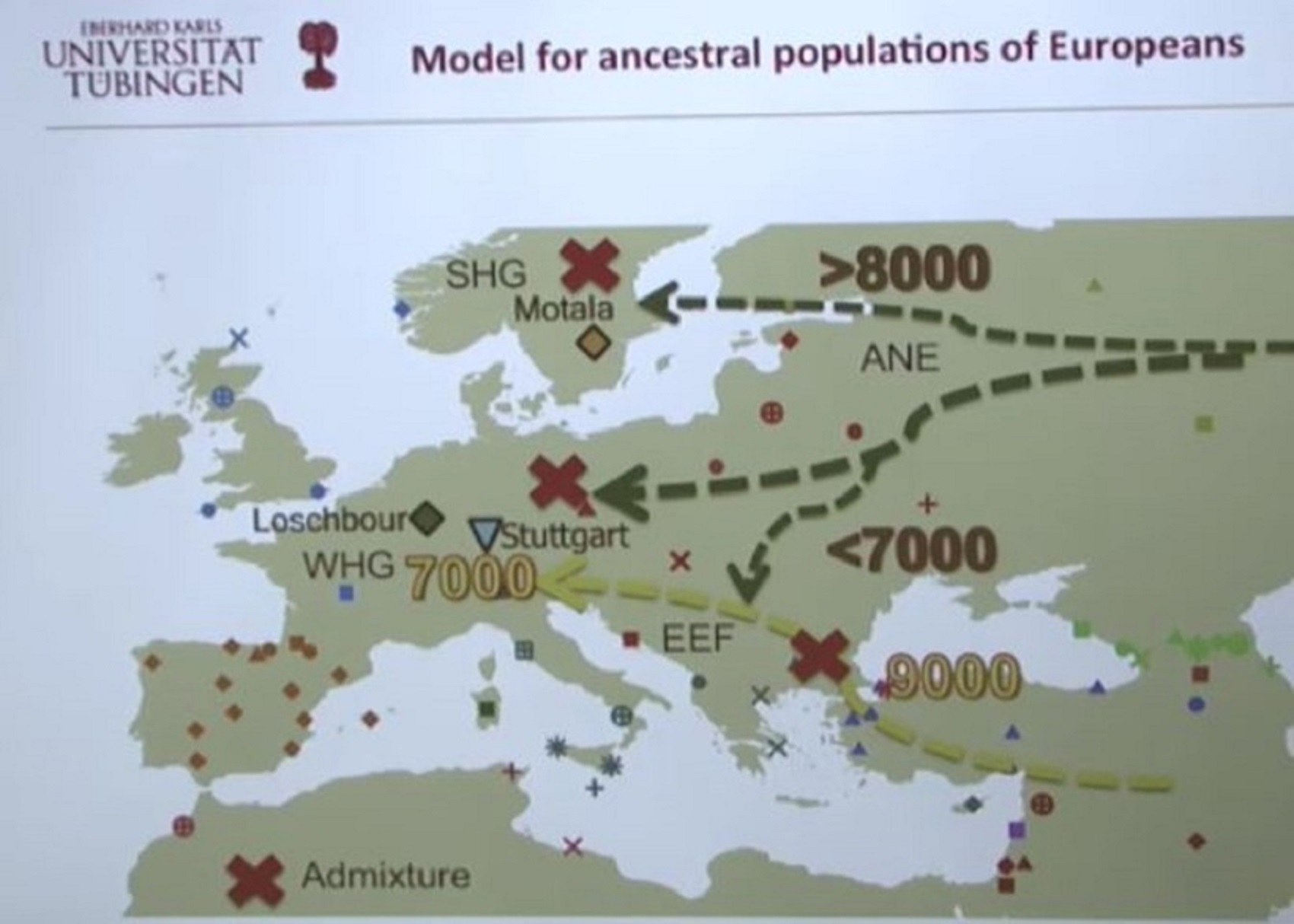
Pic ref
Ancient Human Genomes…Present-Day Europeans – Johannes Krause (Video)
Ancient North Eurasian (ANE)
Eastern Hunter-Gatherer (EHG)
Western Hunter-Gatherers (WHG)
Scandinavian Hunter-Gatherer (SHG)
Early European Farmers (EEF)
A quick look at the Genetic history of Europe
“The most significant recent dispersal of modern humans from Africa gave rise to an undifferentiated “non-African” lineage by some 70,000-50,000 years ago. By about 50–40 ka a basal West Eurasian lineage had emerged, as had a separate East Asian lineage. Both basal East and West Eurasians acquired Neanderthal admixture in Europe and Asia. European early modern humans (EEMH) lineages between 40,000-26,000 years ago (Aurignacian) were still part of a large Western Eurasian “meta-population”, related to Central and Western Asian populations. Divergence into genetically distinct sub-populations within Western Eurasia is a result of increased selection pressure and founder effects during the Last Glacial Maximum (LGM, Gravettian). By the end of the LGM, after 20,000 years ago, A Western European lineage, dubbed West European Hunter-Gatherer (WHG) emerges from the Solutrean refugium during the European Mesolithic. These Mesolithic hunter-gatherer cultures are substantially replaced in the Neolithic Revolution by the arrival of Early European Farmers (EEF) lineages derived from Mesolithic populations of West Asia (Anatolia and the Caucasus). In the European Bronze Age, there were again substantial population replacements in parts of Europe by the intrusion of Ancient North Eurasian (ANE) lineages from the Pontic–Caspian steppes. These Bronze Age population replacements are associated with the Beaker culture archaeologically and with the Indo-European expansion linguistically.” ref
“As a result of the population movements during the Mesolithic to Bronze Age, modern European populations are distinguished by differences in WHG, EEF, and ANE ancestry. Admixture rates varied geographically; in the late Neolithic, WHG ancestry in farmers in Hungary was at around 10%, in Germany around 25%, and in Iberia as high as 50%. The contribution of EEF is more significant in Mediterranean Europe, and declines towards northern and northeastern Europe, where WHG ancestry is stronger; the Sardinians are considered to be the closest European group to the population of the EEF. ANE ancestry is found throughout Europe, with a maximum of about 20% found in Baltic people and Finns. Ethnogenesis of the modern ethnic groups of Europe in the historical period is associated with numerous admixture events, primarily those associated with the Roman, Germanic, Norse, Slavic, Berber, Arab and Turkish expansions. Research into the genetic history of Europe became possible in the second half of the 20th century, but did not yield results with a high resolution before the 1990s. In the 1990s, preliminary results became possible, but they remained mostly limited to studies of mitochondrial and Y-chromosomal lineages. Autosomal DNA became more easily accessible in the 2000s, and since the mid-2010s, results of previously unattainable resolution, many of them based on full-genome analysis of ancient DNA, have been published at an accelerated pace.” ref
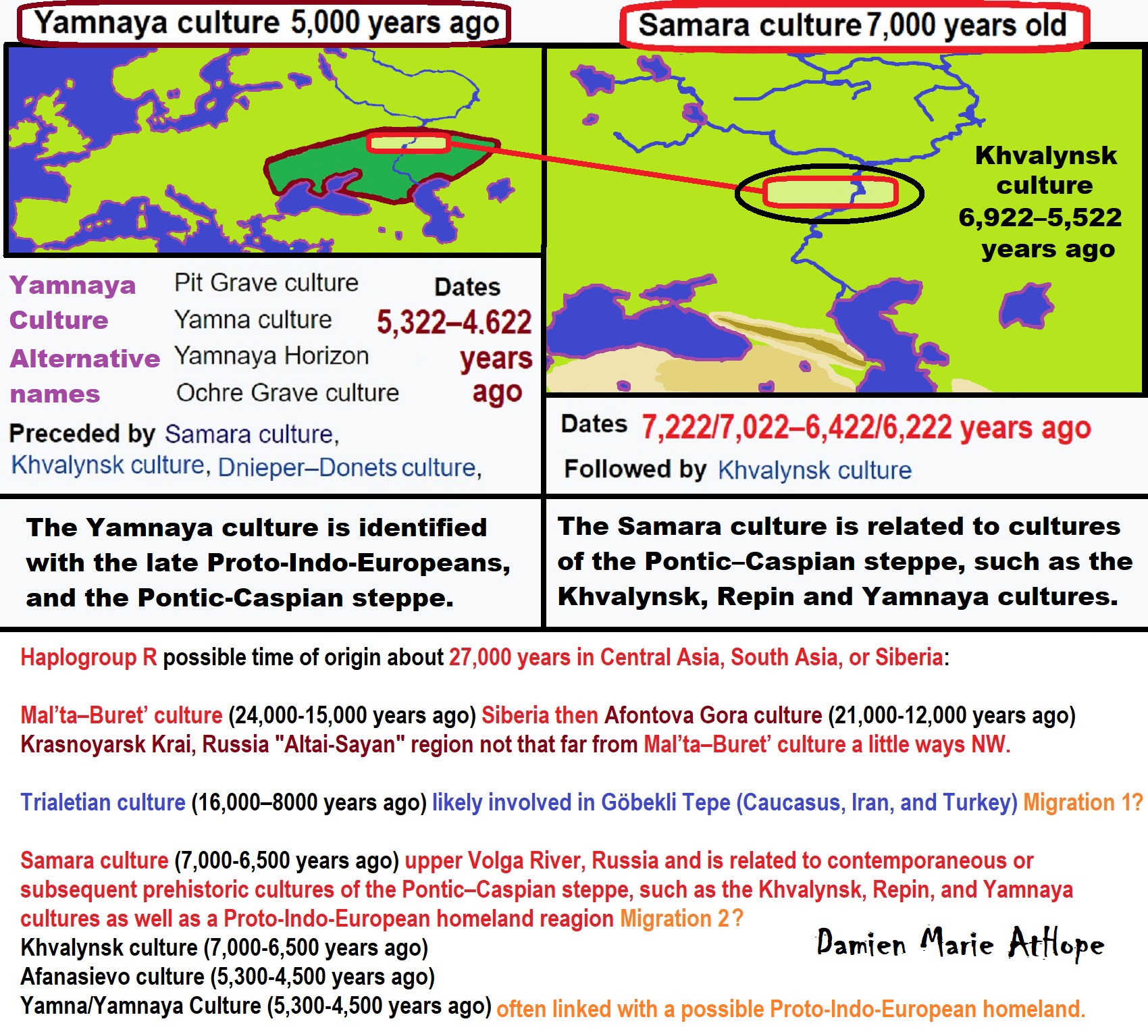
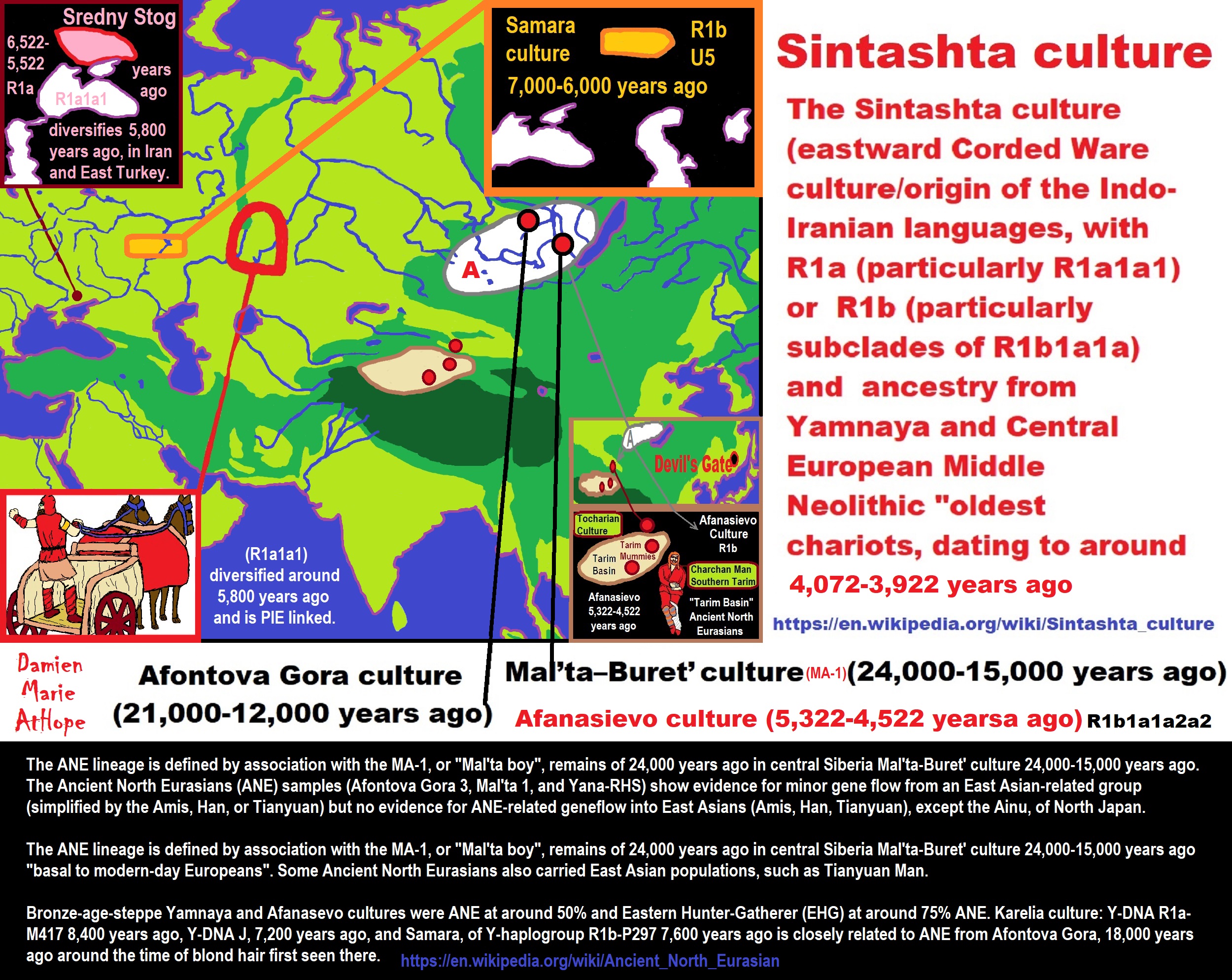
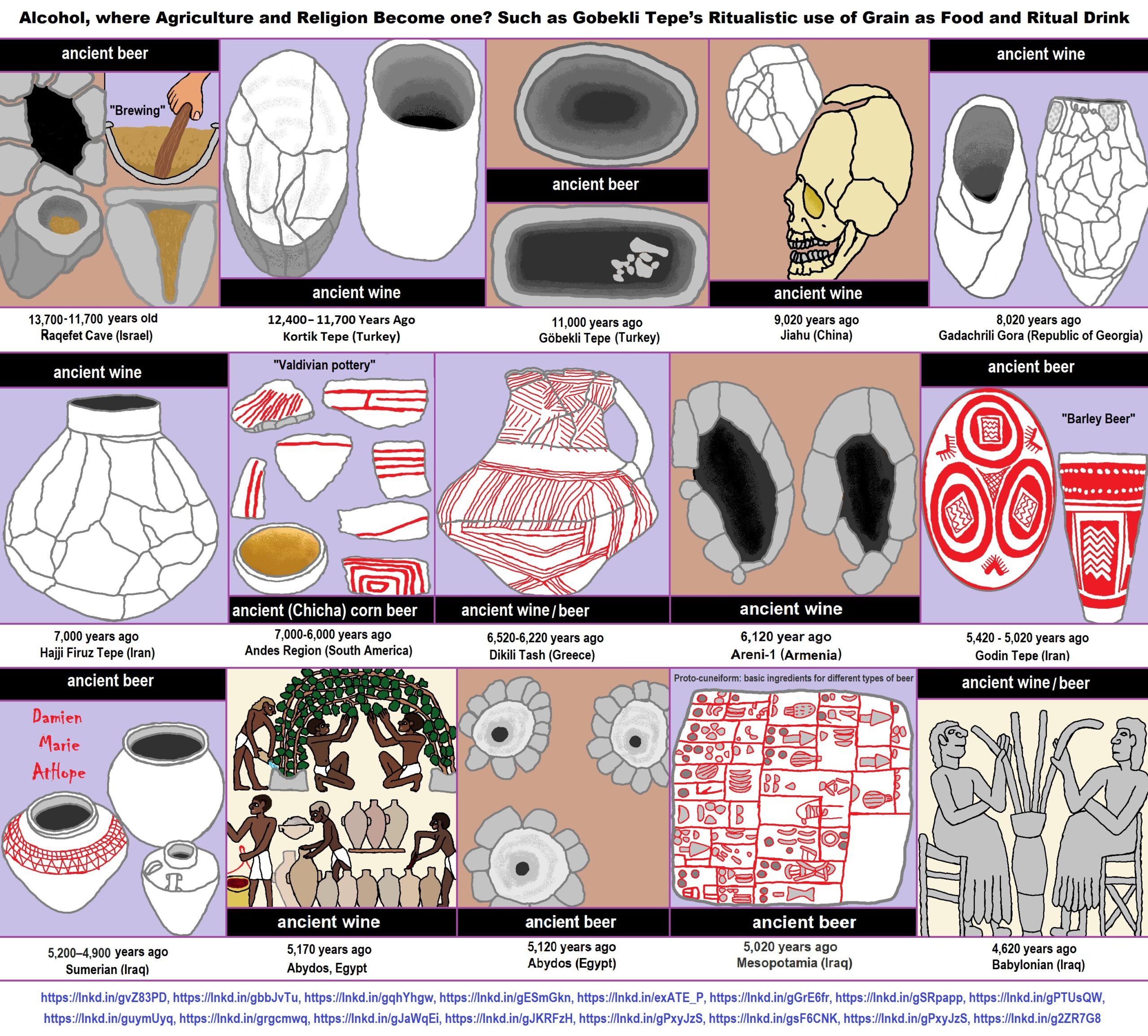
ref, ref, ref, ref, ref, ref, ref, ref, ref, ref, ref, ref, ref, ref, ref
Raqefet Cave
13,000-year-old stone mortars offers the earliest known physical evidence of an extensive ancient beer-brewing operation.
“The find comes on the heels of a July report that archaeologists working in northeastern Jordan discovered the charred remains of bread baked by Natufians some 11,600 to 14,600 years ago. According to the Stanford scientists, the ancient beer residue comes from 11,700 to 13,700 years old. Through laboratory analysis, other archaeological evidence found in the cave, and the wear of the stones, the team discovered that the ancient Natufians used species from seven plant families, “including wheat or barley, oat, legumes and bast fibers (including flax),” according to the article. “They packed plant-foods, including malted wheat/barley, in fiber-made containers and stored them in boulder mortars. They used bedrock mortars for pounding and cooking plant-foods, including brewing wheat/barley-based beer likely served in ritual feasts ca. 13,000 years ago,” the scientists write. “It has long been speculated that the thirst for beer may have been the stimulus behind cereal domestication, which led to a major social-technological change in human history; but this hypothesis has been highly controversial,” the Stanford authors say. “We report here of the earliest archaeological evidence for cereal-based beer brewing by a semi-sedentary, foraging people.” ref
“Beer making was an integral part of rituals and feasting, a social regulatory mechanism in hierarchical societies,” said Stanford’s Wang. The Raqefet Cave discovery of the first man-made alcohol production, the cave also provides one of the earliest pieces of evidence of the use of flower beds on gravesites, discovered under human skeletons. “The Natufian remains in Raqefet Cave never stop surprising us,” co-author Prof. Dani Nadel, of the University of Haifa’s Zinman Institute of Archaeology, said in a press release. “We exposed a Natufian burial area with about 30 individuals, a wealth of small finds such as flint tools, animal bones and ground stone implements, and about 100 stone mortars and cupmarks. Some of the skeletons are well-preserved and provided direct dates and even human DNA, and we have evidence for flower burials and wakes by the graves.” ref
“And now, with the production of beer, the Raqefet Cave remains provide a very vivid and colorful picture of Natufian lifeways, their technological capabilities, and inventions,” he said. Stanford’s Liu posited that the beer production was of a religious nature because its production was found near a graveyard. “This discovery indicates that making alcohol was not necessarily a result of agricultural surplus production, but it was developed for ritual purposes and spiritual needs, at least to some extent, prior to agriculture,” she said. “Alcohol making and food storage were among the major technological innovations that eventually led to the development of civilizations in the world, and archaeological science is a powerful means to help reveal their origins and decode their contents,” said Liu. “We are excited to have the opportunity to present our findings, which shed new light on a deeper history of human society.” ref
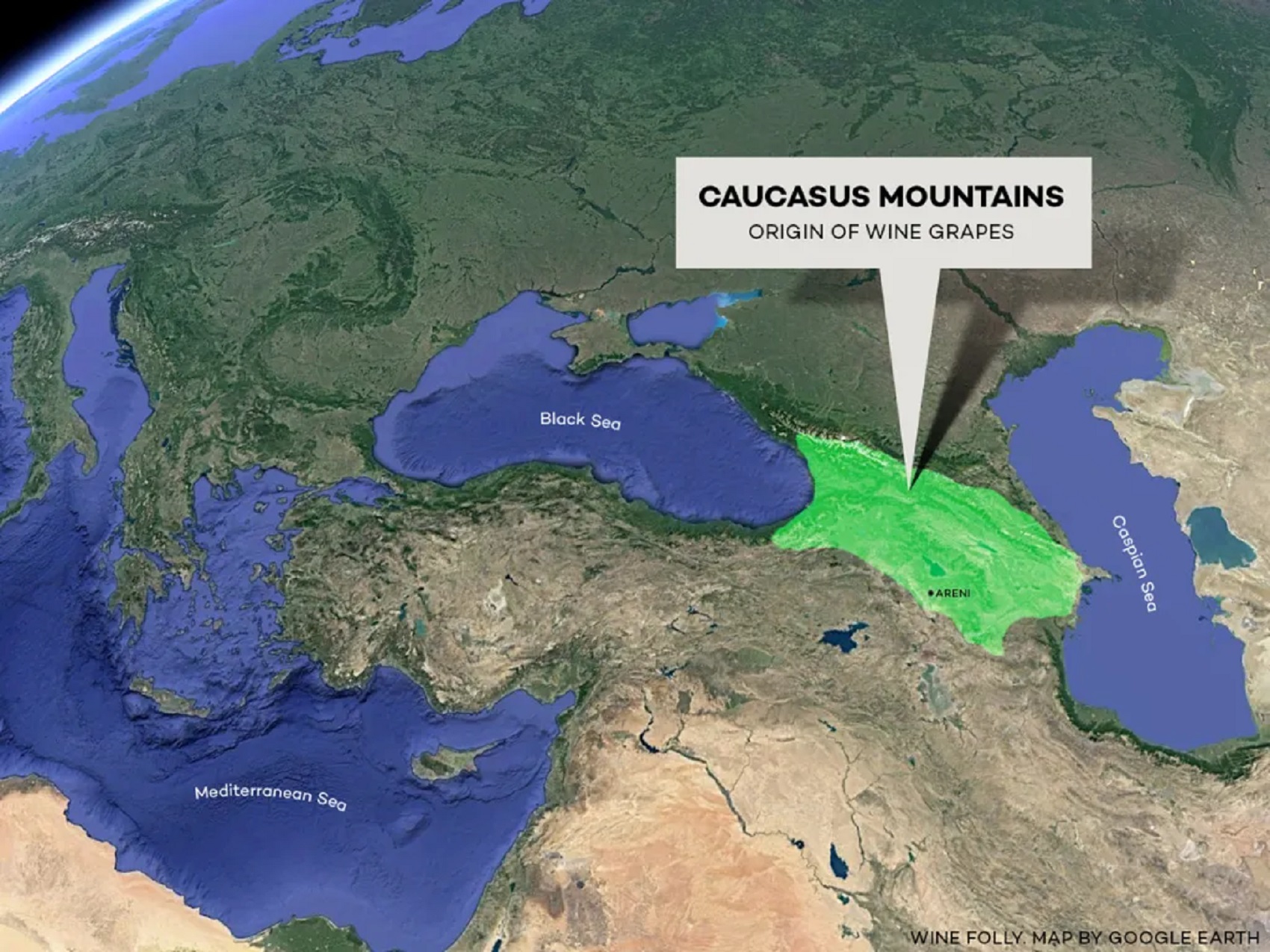
“The grape vine, which grows naturally in most geographical areas between 30° and 50° north with annual isotherms of 10-20 °C, was probably first cultivated (as vitis vinifera sativa) in the Caucasus region prior to the Neolithic period. From there the practice of pressing grapes into wine spread to the Near East and Mediterranean. Cultivated in Egypt, Mesopotamia, Phoenicia, and Mycenaean Greece, by the Classical period wine was an important feature of ritual and everyday life. As trade routes were established in the Mediterranean the consumption of wine and cultivation of vines spread from the Black Sea to the North African coast and along to the Iberian peninsula. Winemaking thus became one of the most visible manifestations of cultural colonization in the ancient world.” ref
“Current evidence suggests that wine originated in the Caucasus Mountains and the Zagros Mountains which contain the highest peaks of Europe. These mountain ranges span from Armenia through Azerbaijan, Georgia, northern Iran, southeastern Anatolia, and eastern Turkey. The ancient wine production evidence dates from between 8000 B.C. and 4100 B.C. which includes an ancient winery site in Armenia at around 6,100 years old, wth grape residue found in clay jars in Georgia, and signs of grape domestication in eastern Turkey. And the history of wine is closely tied to the history and evolution of humankind. From the beginning, wine consumption was built into culture largely due to religious sacraments. As people spread across the world, so did wine. The people who made the first wines were of the Shulaveri-Shomu culture. They were a people of the Stone Age who used obsidian for tools, raised cattle and pigs, and most importantly, grew grapes.” ref
“The Shulaveri-Shomu culture is a Late Neolithic/Eneolithic culture that existed on the territory of present-day Georgia, Colchis, Azerbaijan, and the Armenian Highlands. According to the material culture examples found in the sites depict that the main activities of the population were farming and breeding. The culture is dated to mid-6th or early-5th millennia BC and is thought to be one of the earliest known Neolithic cultures and Colchis. As a result of archaeological research in the area of Goytepe, the Shulaveri-Shomutepe culture has been identified as belonging to the 7th millennium BC and the second half of the 6th millennium. Although Shulaveri-Shomutepe complex firstly was attributed to the Eneolithic era, it is now considered as a material and cultural example of the Neolithic era except for the upper layers where metal objects have been discovered as in KhramisDidi-Gora and Arucho I. The earliest evidence of domesticated grapes in the world has been found in the general “Shulaveri area”, near the site of Shulaveri gora, in Marneuli Municipality, in the southeastern Republic of Georgia.” ref, ref
“Specifically, the most recent evidence comes from Gadachrili gora, near the village of Imiri in the same region; carbon-dating points to the date of about 6000 BC. The Shulaveri-Shomu culture was preceded by Trialetian culture and was followed by Kura–Araxes culture and Trialeti culture. Sulaveri-Shomu culture is distinguished by circular mud-brick architectures, domestic animals breeding and cultivating cereals. Handmade pottery with engraved decorations, blades, burins and scrapers made of obsidian, tolls made of bone and antler, besides rare examples of metal items, remains of plant, such as wheat, pips, barley and grape, as well as animal bones (pigs, goats, dogs and bovids) have been discovered during the excavations. Anthropomorphic figurines of mainly seated women found in the sites represent the items used for religious purposes relating to the fertility cult. The similarities between the microlithic tools and the use of ochre also bring Shulaveri-Shomu culture closer to the culture of Halaf. Pestles and mortars found in Shulaveri-Shomu sites and Late Neolithic layers of Tell Sabi Abyad in Syria are also similar to each other.” ref
THE KVEVRI – INVENTED IN GEORGIA CIRCA 6,000 BCE
“Unlike the rest of the storage devices we’ll talk about, kvevris (also translated as qvevri) were probably not used for transporting wine. Some historians speculate that they were, but it’s not very likely. Why isn’t it likely? They were quite large and they were buried in the ground to ensure climate control sans electricity. While it’s hard to pin specific dates when archeologists take us this far back in history, we can say with certainty that the Ancient Georgians were using these large, beeswax coated, earthenware vessels as early as 6,000 BC. And what makes a kvevri so special aside from being the oldest storage vessels we’ve discovered to date, is that they were used in every stage of wine production, from grape crushing to aging. Unfermented grapes, naturally growing in the region, were dumped into a kvevri, which could hold hundreds to thousands of liters of liquid depending on its size. The grapes were then crushed (stems included), the kvevri was buried (to keep the wine at a steady temperature) and primary fermentation commenced. Once the period of primary fermentation was over, the kvevri was covered with a large stone to create an airtight seal. The kvevri was then left undisturbed for up to two years, allowing the wine to undergo malolactic fermentation and a period of aging. What came out at the end was an earthenware-aged wine that was highly tannic.” ref
“In the highlands of eastern Anatolia and South Caucasus, the right combination of domesticable animals and sowable grains and legumes made possible the earliest agriculture. In this sense, the region can justly be considered one of the “cradles of civilization”. And the signs of Neolithic culture and the transition from foraging and hunting to agriculture and stock-raising are found in Georgia from at least the beginning of the 6th millennium BC. The so-called early Neolithic sites are chiefly found in western Georgia. These are Khutsubani, Anaseuli, Kistriki, Kobuleti, Tetramitsa, Apiancha, Makhvilauri, Kotias Klde, Paluri, and others. In the 5th millennium BC, the Kura (Mtkvari) basin also became stably populated, and settlements such as those at Tsopi, Aruchlo, and Sadakhlo along the Kura in eastern Georgia are distinguished by a long-lasting cultural tradition, distinctive architecture, and considerable skill in stoneworking. Most of these sites relate to the flourishing late Neolithic/Eneolithic archaeological complex known as the Shulaveri-Shomu culture. Radiocarbon dating at Shulaveri sites indicates that some of the earliest settlements there date from the late sixth − early fifth millennium BC.” ref
“Early metallurgy started in Georgia during the 6th millennium BC. Very early metal objects have been discovered in layers of the Neolithic Shulaveri-Shomutepe culture. From the beginning of the 4th millennium, metals became used to a larger extent in East Georgia and in the whole Transcaucasian region. From c. 3400 BC to 2000 BC, the region saw the development of the Kura-Araxes or Early Transcaucasian culture centered on the basins of Kura and Araxes. During this era, economic stability based on cattle and sheep raising and noticeable cultural development was achieved. The local chieftains appear to have been men of wealth and power. Their burial mounds have yielded finely wrought vessels in gold and silver; a few are engraved with ritual scenes suggesting the Middle Eastern cult influence. This vast and flourishing culture was in contact with the more advanced civilization of Akkadian Mesopotamia, but went into gradual decline and stagnated c. 2300 BC, beingeventually broken up into a number of regional cultures. One of the earliest of these successor cultures is the Bedeni culture in eastern Georgia. And at the end of the 3rd millennium BC, there is evidence of considerable economic development and increased commerce among the tribes. In western Georgia, a unique culture known as Colchian developed between 1800 and 700 BC, and in eastern Georgia the kurgan (tumulus) culture of Trialeti reached its zenith around 1500 BC.” ref
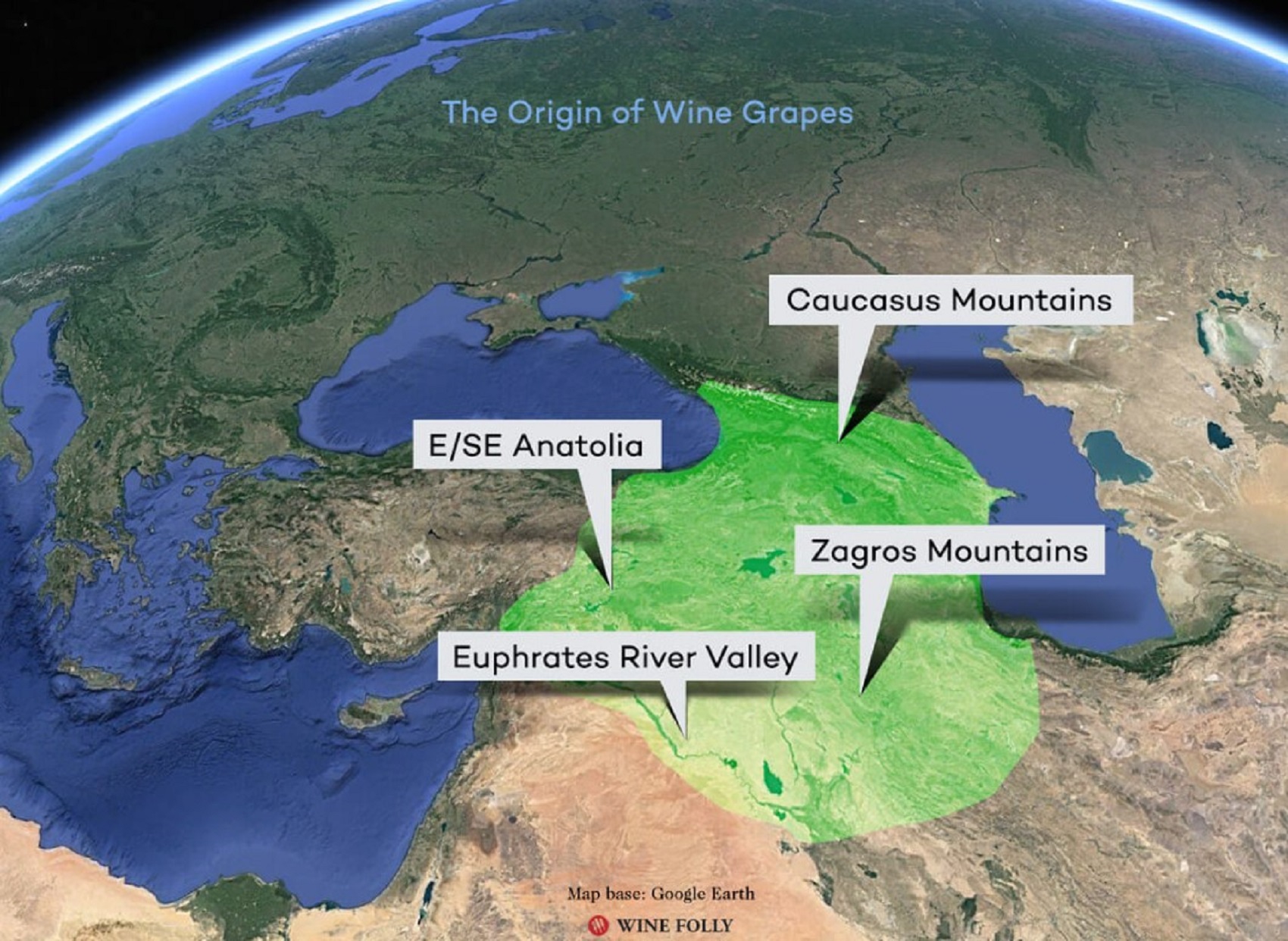
“Current evidence suggests that wine originated in West Asia including Caucasus Mountains, Zagros Mountains, Euphrates River Valley, and Southeastern Anatolia. This area spans a large area that includes the modern-day nations of Armenia, Azerbaijan, Georgia, northern Iran, and eastern Turkey. Ancient wine production evidence dates between 6,000 to 4,000 BCE, and includes an ancient winery site in Armenia, grape residue found in clay jars in Georgia, and signs of grape domestication in eastern Turkey.” ref
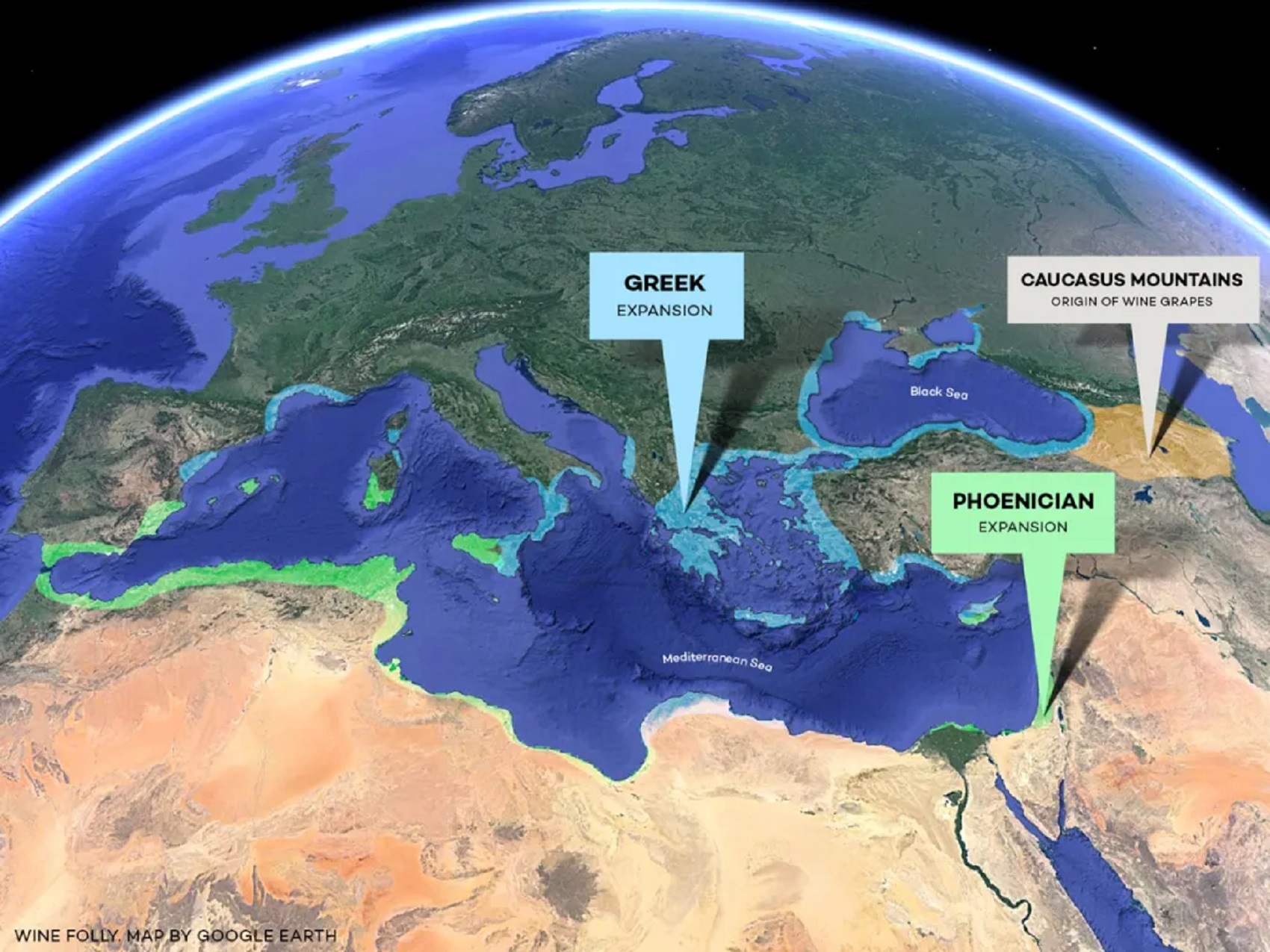
“From Caucasus, wine grapes have followed human civilization as it expanded southward and westward and into the Mediterranean. These sea-fairing civilizations of the Phoenicians and Greeks were the most responsible for the spread of wine throughout Western Europe. With each new region that was planted, the grapes slowly mutated and adapted to their unique environments. This slow divergence over thousands of years is what created the incredible diversity of over the 1300 identified wine varieties we have today.” ref
“After 10 years of research, we understand that Anatolia/Turkey, especially from the North West, is part of the basis of all European peoples spreading from both the Mediterranean and Balkan routs. Matching how all European cattle are all descended from Iranian cattle dispersed by farmer herders leaving Anatolia/Turkey.” – Joachim Burger – Anthropologist & Population Geneticist Johannes Gutenberg University, Mainz. ref
Access to milk and cheese has been linked to the spread of agriculture across Europe starting around 9,000 years ago. And there is Mediterranean Cheese Production dated to around 7,200 Years Ago from the analysis of fatty residue in pottery from two Neolithic archaeological sites in Croatia has revealed evidence of fermented dairy products (soft cheeses and yogurts). ref

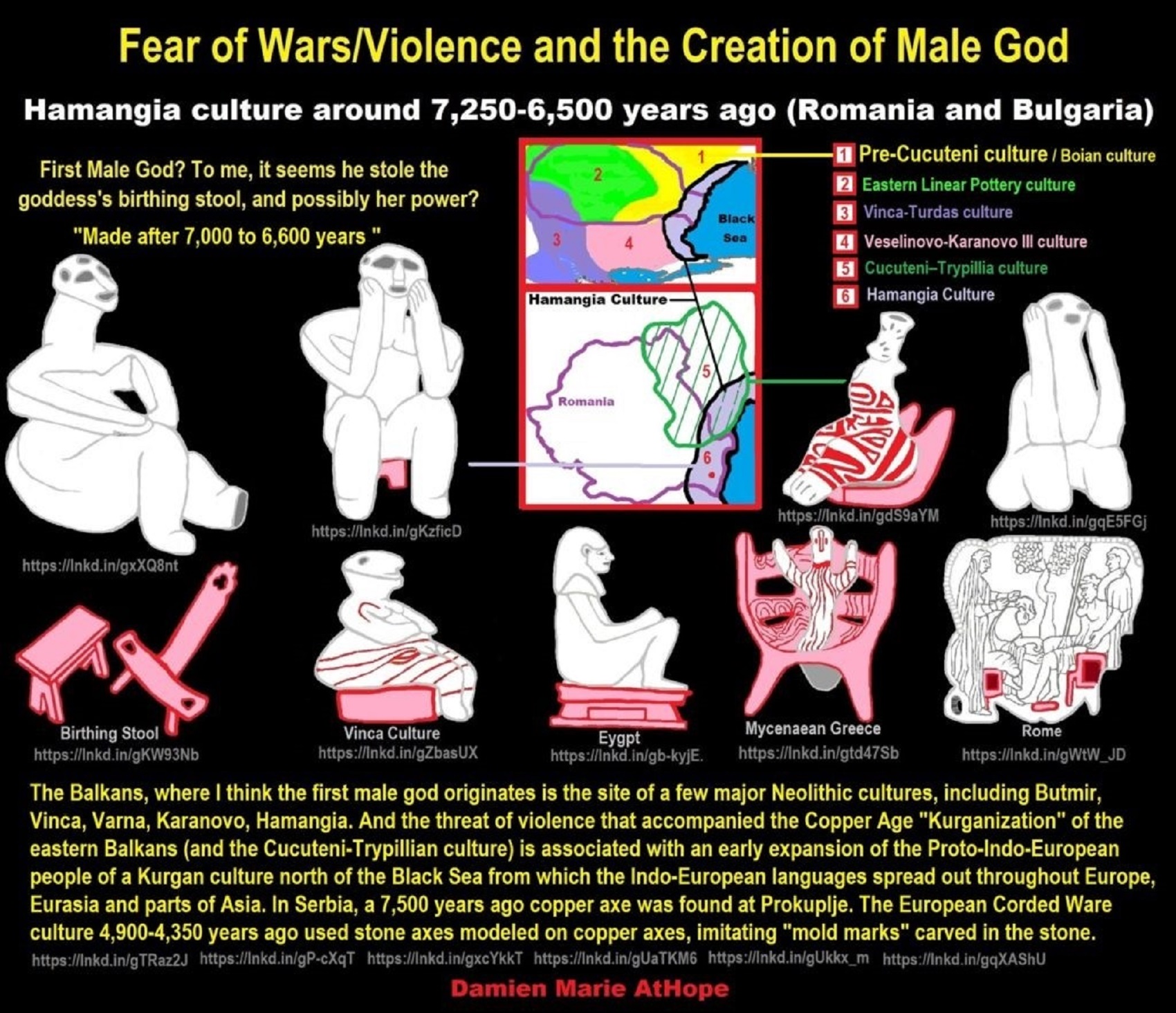
The First Expression of the Male God around 7,000 years ago?
The Balkans, where I think the first male god originates is the site of a few major Neolithic cultures, including Butmir, Vinča, Varna, Karanovo, Hamangia. And the threat of violence that accompanied the Copper Age “Kurganization” of the eastern Balkans (and the Cucuteni-Trypillian culture) is associated with an early expansion of the Proto-Indo-European people of a Kurgan culture north of the Black Sea from which the Indo-European languages spread out throughout Europe, Eurasia and parts of Asia. In Serbia, a 7,500 years ago copper axe was found at Prokuplje. The European Corded Ware culture 4,900-4,350 years ago used stone axes modeled on copper axes, imitating “mold marks” carved in the stone. ref, ref, ref, ref, ref, ref, ref
The Dead among the Living in the Hamangia Culture
“Human bones in the domestic space are not uncommon during Prehistory, but the settlements of the Hamangia culture did not provide, many such remains. A recent reanalysis of the excavations performed at Cernavodă–Columbia C settlement brought to light the discovery of several human bone fragments from the habitation layer. But they do exist, and they were found at various depths, in association with pottery.” ref
“Is there’s a connection between “Hamangia Thinker” and Cycladic art and the “Hamangia Thinker.” These and other similar figures could relate to another Neolithic clay figure that was found at a Cucuteni-Trypillian culture site in the town of Tarpesti, Romania called the “Thinker of Tarpesti” resemblance between the Thinker of Tarpesti statue and the Hamangia Thinker statue is uncanny.” ref
The Funnel Beaker Culture – “First Farmers of Scandinavia” around 6,200-4,650 years ago marks the arrival of Megalithic structures in Scandinavia from western Europe. Megaliths seem to have originated in the Near East. The oldest ones in Europe were found in Sicily and southern Portugal and date from around 9,000 years ago. The Funnelbeaker culture marks the appearance of megalithic tombs at the coasts of the Baltic and of the North sea, an example of which are the Sieben Steinhäuser in northern Germany. At graves, the people sacrificed ceramic vessels that contained food along with amber jewelry and flint-axes. Flint-axes and vessels were also deposed in streams and lakes near the farmlands, and virtually all Sweden’s 10,000 flint axes that have been found from this culture were probably sacrificed in water. They also constructed large cult centres surrounded by pales, earthworks, and moats. The Atlantic Megalithic culture really started with the advent of farming and would have spread from Iberia to France, the British Isles, and the Low Countries before reaching Scandinavia. Considering the high Northwest African admixture in Funnelbeaker, there is a good chance that Iberian Megalithic people inherited genes from Northwest Africans, probably from the North African Neolithic route that brought R1b-V88, E-M78, J1 and T1a to Iberia. R1b-V88 and E-M78 (V13) have both been found in Early Neolithic Iberia, and are both found throughout western Europe today. The two samples below also carried about 3% of Southwest Asian admixture, which is perfectly consistent with a Neolithic dispersal from the southern Levant across North Africa until Iberia. ref, ref
- Funnelbeaker Culture(samples from Sweden) : H (x3), H1, H24, J1d5, J2b1a, K1a5, T2b
- Baalberge group(c. 5,800 to 5,350 ybp ; central-east Germany): H (x3), H1e1a, H7d5, HV, J, K1a (x2), N1a1a, T1a1, T2b, T2c (x2), T2e1, U5b2a2, U8a1a, X, X2c
- Walternienburg-Bernburg group(c. 5,100 to 4,700 ybp ; central-east Germany): H, H1e1a3, H5, K1, K1a (x2), T2b, U5a, U5b, U5b1c1, U5b2a1a, V, W, X
- Salzmünde group(5,400 to 5,000 ybp : central-east Germany): H (x2), H3 (x2), H5, HV, HV0, J, J1c (x2), J2b1a, K1, K1a, K1a4a1a2, N1a1a1a3 (x2), T2b (x2), U3a, U3a1, U5b, V, X2b1’2’3’4’5’6
- Outliers from Gotland, Sweden(5,300 to 4,700 ybp): H7d, HV0a, J1c5 (2x), J1c8a, K1a2b (2x), K2b1a, T2b8 ref
The presence of H1 was confirmed in remains from the Late Neolithic Funnel Beaker culture in Scandinavia, which can also be classified as a Megalithic culture. H1 and H3 lineages would have been some of the most prevalent mt-haplogroups among the Megalithic cultures of Western Europe, which spanned the whole Neolithic and Chalcolithic periods, from the 5th millennium BCE until the arrival of the Proto-Celts (Y-DNA R1b) from 2200 BCE to 1800 BCE (or up to 1200 BCE in parts of Iberia). Megalithic people would have belonged essentially to Y-haplogroups I2, G2a and E1b1b, with the possible addition of J2 lineages during the Chalcolithic. From the Bronze Age, R1b male lineages replaced a large percentage of Megalithic Y-haplogroups, but female Megalithic lineages survived almost unchanged in frequency. Celtic culture was born from the fusion of Indo-European paternal lineages (R1b) with native Central and Western European maternal lineages (including H1, H3, H10, J1c, K1a, T2, U5, and X2). The first pottery produced in the Fertile Crescent appeared circa 6500 BCE. It is from this period that early agriculturalists began expanding towards western Anatolia and Greece. These Neolithic farmers potentially belonged to haplogroups H5, as well as J1c, K1a, N1a, T2 and X2, all of which have been found in ancient Neolithic samples from Europe and Anatolia, and are also found throughout the Middle East today. The mutation defining haplogroup H took place at least 25,000 years ago, and perhaps closer to 30,000 years ago. Its place of origin is unknown, but it was probably somewhere around the northeastern Mediterraean (Balkans, Anatolia or Levant), possibly even in Italy. ref
Journeys to the Sun: Heavenly Symbols in Shamanism and Rock Art of Siberia and Central Asia
7,000-year-old burial mound unearthed in Siberia (pre-kurgan?)
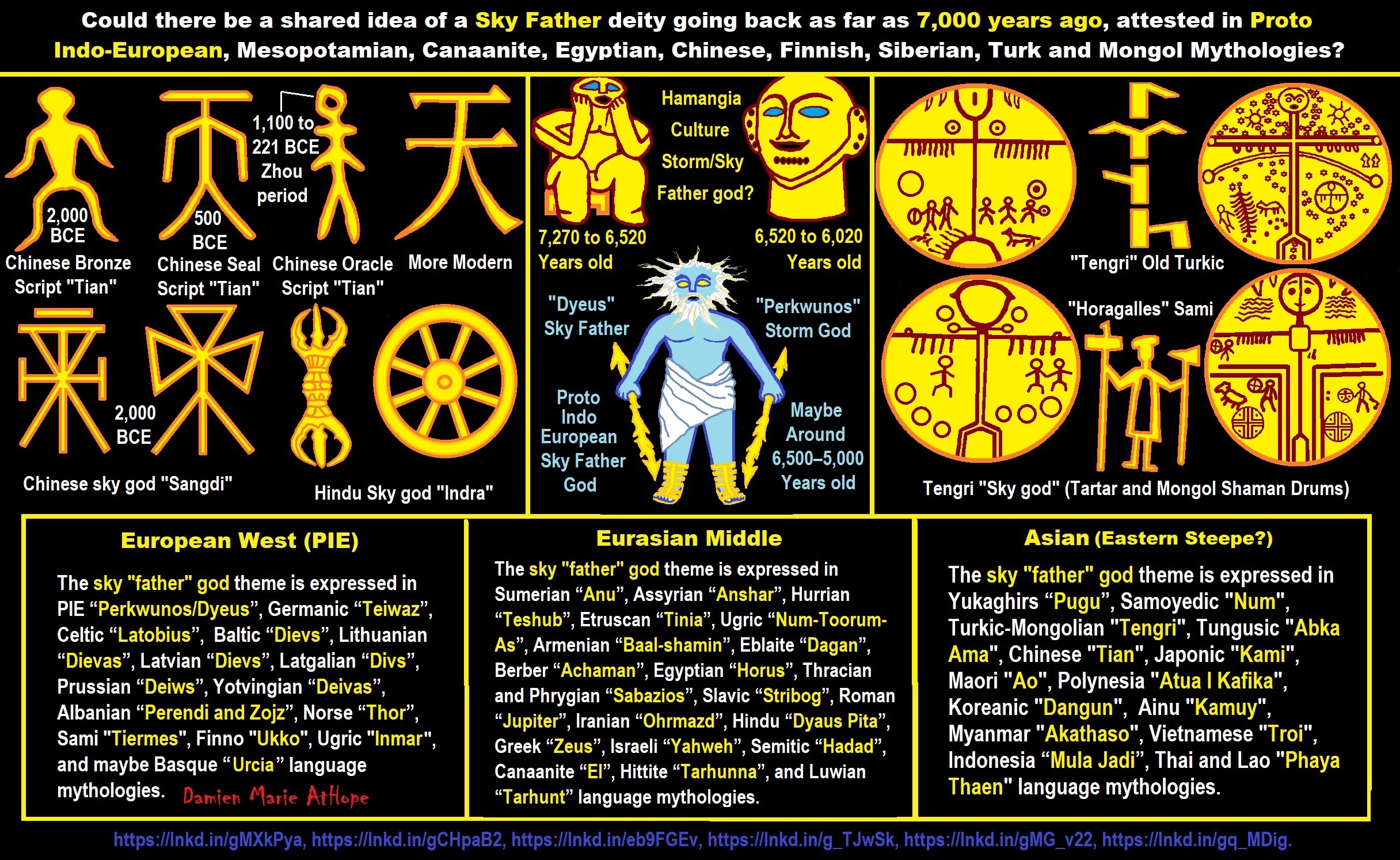
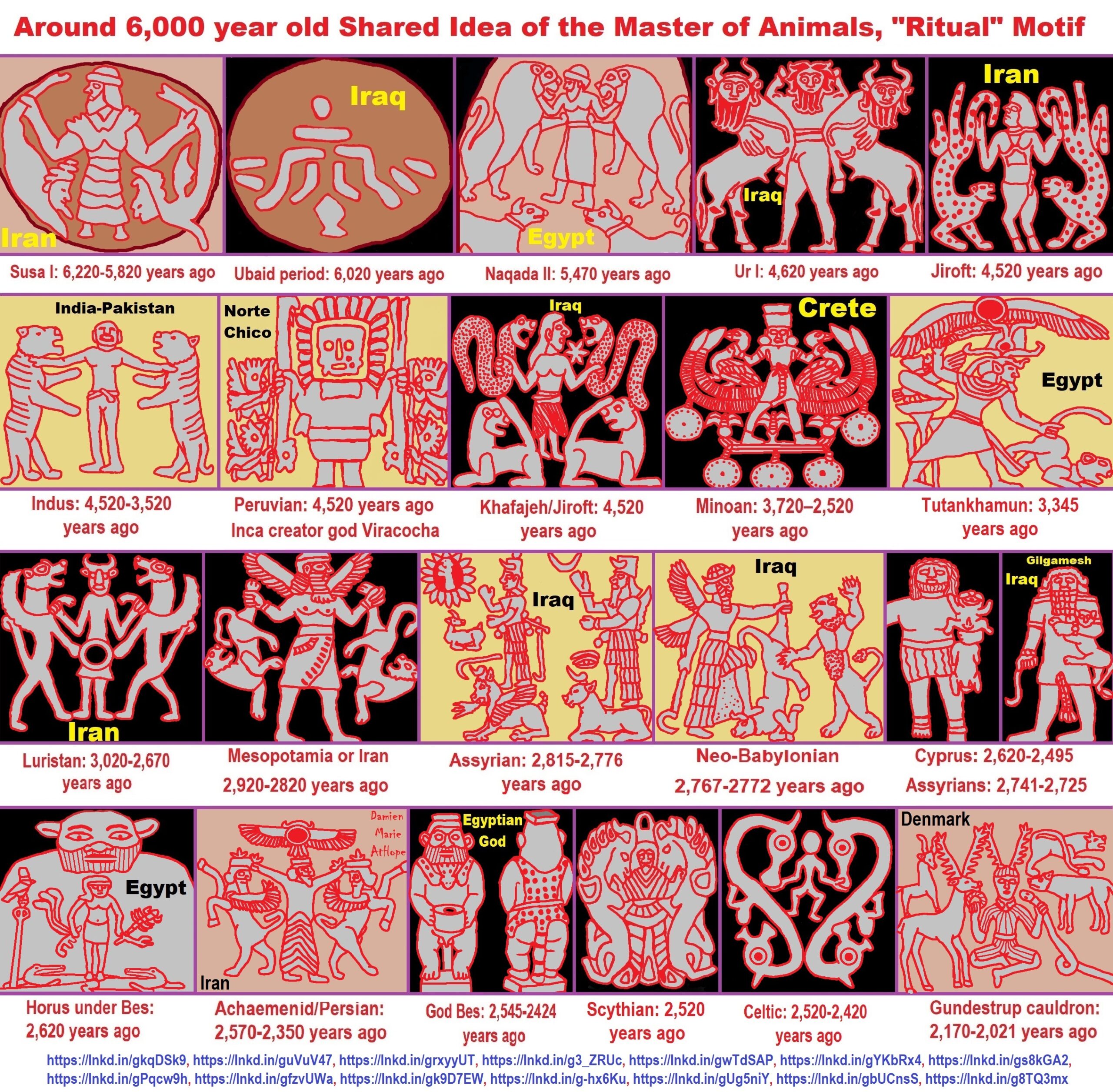

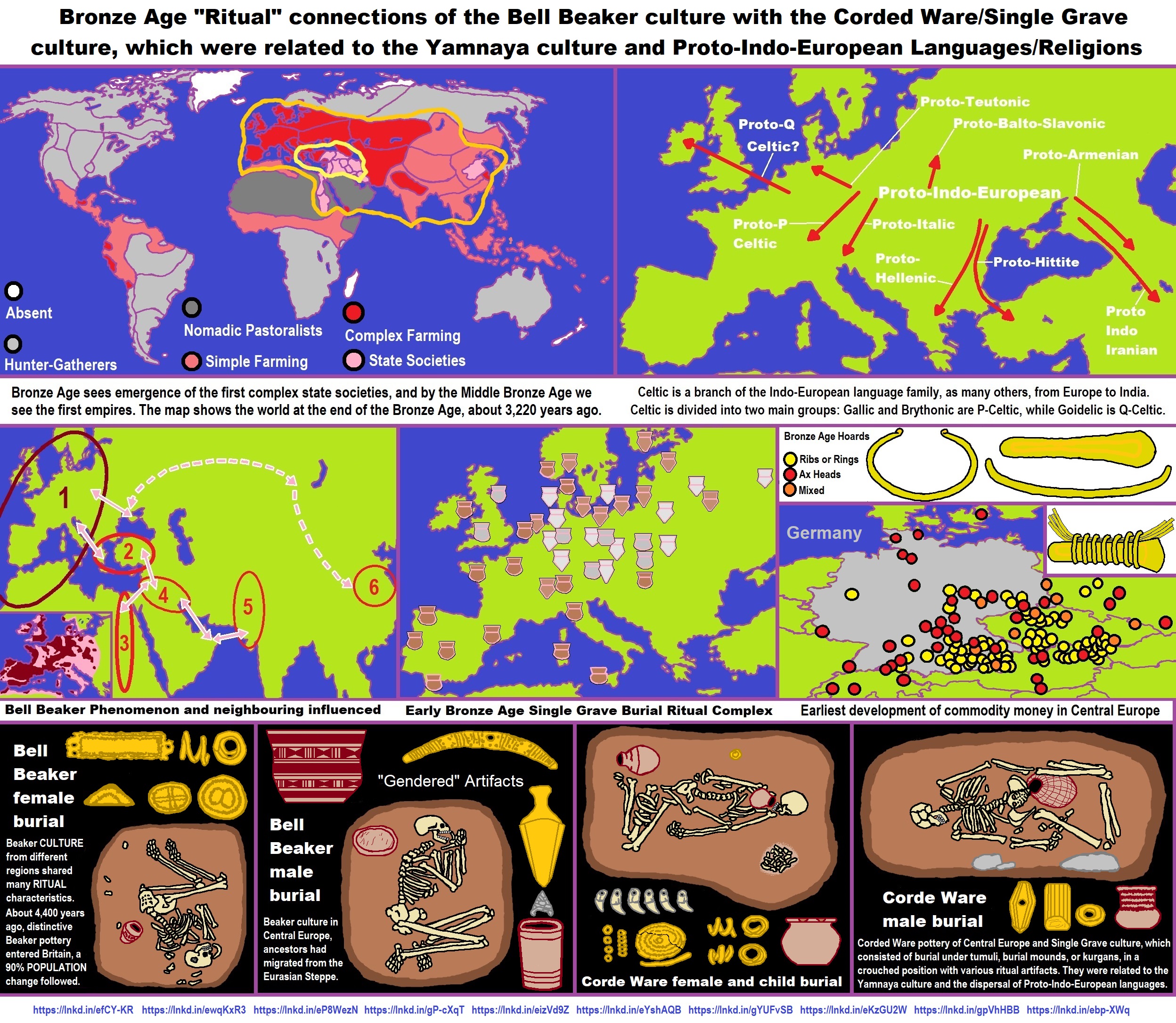
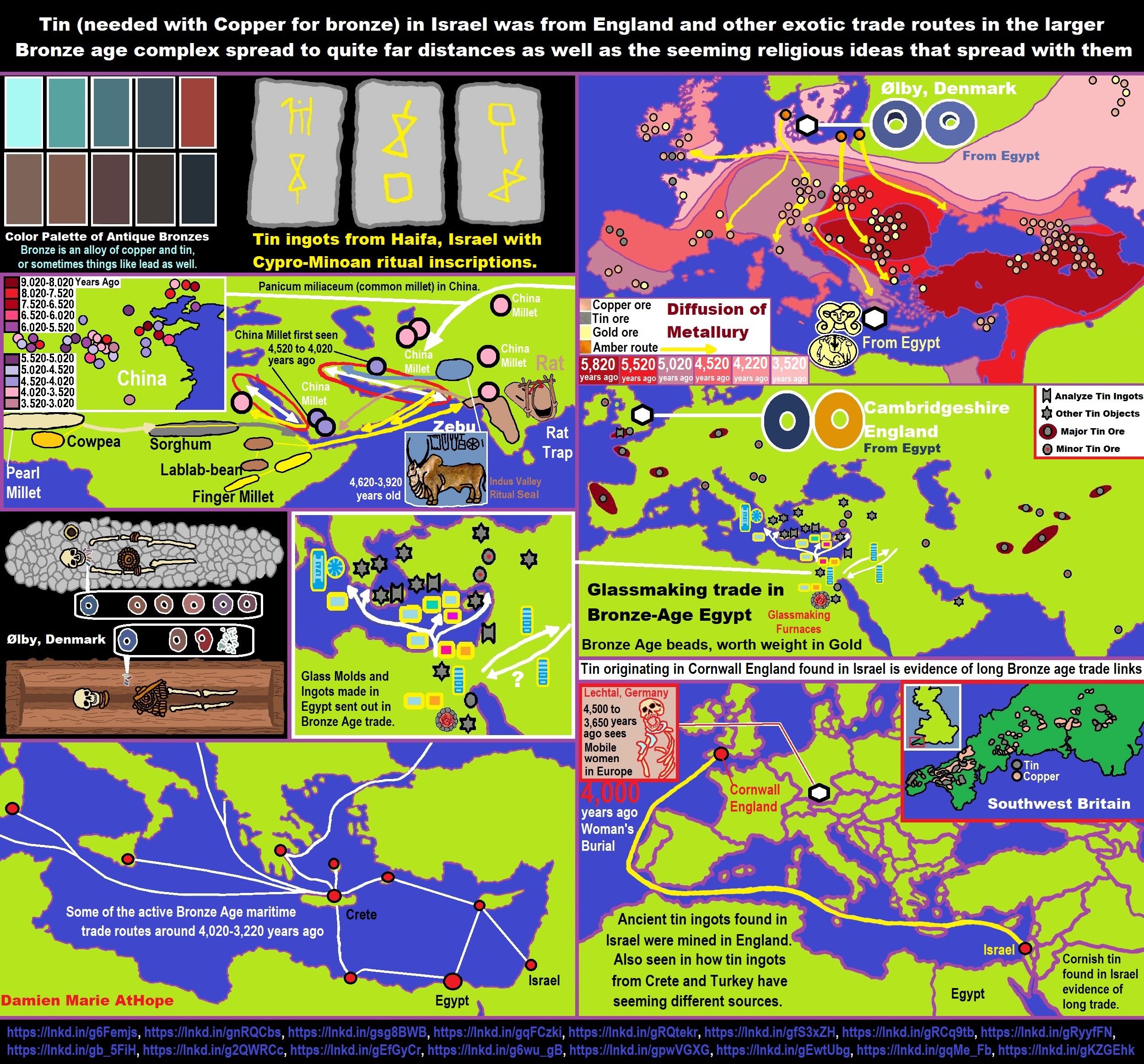



Animism: Respecting the Living World by Graham Harvey
“How have human cultures engaged with and thought about animals, plants, rocks, clouds, and other elements in their natural surroundings? Do animals and other natural objects have a spirit or soul? What is their relationship to humans? In this new study, Graham Harvey explores current and past animistic beliefs and practices of Native Americans, Maori, Aboriginal Australians, and eco-pagans. He considers the varieties of animism found in these cultures as well as their shared desire to live respectfully within larger natural communities. Drawing on his extensive casework, Harvey also considers the linguistic, performative, ecological, and activist implications of these different animisms.” ref


My thoughts on Religion Evolution with external links for more info:
- (Pre-Animism Africa mainly, but also Europe, and Asia at least 300,000 years ago), (Pre-Animism – Oxford Dictionaries)
- (Animism Africa around 100,000 years ago), (Animism – Britannica.com)
- (Totemism Europe around 50,000 years ago), (Totemism – Anthropology)
- (Shamanism Siberia around 30,000 years ago), (Shamanism – Britannica.com)
- (Paganism Turkey around 12,000 years ago), (Paganism – BBC Religion)
- (Progressed Organized Religion “Institutional Religion” Egypt around 5,000 years ago), (Ancient Egyptian Religion – Britannica.com)
- (CURRENT “World” RELIGIONS after 4,000 years ago) (Origin of Major Religions – Sacred Texts)
- (Early Atheistic Doubting at least by 2,600 years ago) (History of Atheism – Wikipedia)
“Religion is an Evolved Product” and Yes, Religion is Like Fear Given Wings…
Atheists talk about gods and religions for the same reason doctors talk about cancer, they are looking for a cure, or a firefighter talks about fires because they burn people and they care to stop them. We atheists too often feel a need to help the victims of mental slavery, held in the bondage that is the false beliefs of gods and the conspiracy theories of reality found in religions.
Understanding Religion Evolution:
- Pre-Animism (at least 300,000 years ago)
- Animism (Africa: 100,000 years ago)
- Totemism (Europe: 50,000 years ago)
- Shamanism (Siberia: 30,000 years ago)
- Paganism (Turkey: 12,000 years ago)
- Progressed organized religion (Egypt: 5,000 years ago), (Egypt, the First Dynasty 5,150 years ago)
- CURRENT “World” RELIGIONS (after 4,000 years ago)
- Early Atheistic Doubting (at least by 2,600 years ago)
“An Archaeological/Anthropological Understanding of Religion Evolution”
It seems ancient peoples had to survived amazing threats in a “dangerous universe (by superstition perceived as good and evil),” and human “immorality or imperfection of the soul” which was thought to affect the still living, leading to ancestor worship. This ancestor worship presumably led to the belief in supernatural beings, and then some of these were turned into the belief in gods. This feeble myth called gods were just a human conceived “made from nothing into something over and over, changing, again and again, taking on more as they evolve, all the while they are thought to be special,” but it is just supernatural animistic spirit-belief perceived as sacred.
Quick Evolution of Religion?
Pre-Animism (at least 300,000 years ago) pre-religion is a beginning that evolves into later Animism. So, Religion as we think of it, to me, all starts in a general way with Animism (Africa: 100,000 years ago) (theoretical belief in supernatural powers/spirits), then this is physically expressed in or with Totemism (Europe: 50,000 years ago) (theoretical belief in mythical relationship with powers/spirits through a totem item), which then enlists a full-time specific person to do this worship and believed interacting Shamanism (Siberia/Russia: 30,000 years ago) (theoretical belief in access and influence with spirits through ritual), and then there is the further employment of myths and gods added to all the above giving you Paganism (Turkey: 12,000 years ago) (often a lot more nature-based than most current top world religions, thus hinting to their close link to more ancient religious thinking it stems from). My hypothesis is expressed with an explanation of the building of a theatrical house (modern religions development). Progressed organized religion (Egypt: 5,000 years ago) with CURRENT “World” RELIGIONS (after 4,000 years ago).
Historically, in large city-state societies (such as Egypt or Iraq) starting around 5,000 years ago culminated to make religion something kind of new, a sociocultural-governmental-religious monarchy, where all or at least many of the people of such large city-state societies seem familiar with and committed to the existence of “religion” as the integrated life identity package of control dynamics with a fixed closed magical doctrine, but this juggernaut integrated religion identity package of Dogmatic-Propaganda certainly did not exist or if developed to an extent it was highly limited in most smaller prehistoric societies as they seem to lack most of the strong control dynamics with a fixed closed magical doctrine (magical beliefs could be at times be added or removed). Many people just want to see developed religious dynamics everywhere even if it is not. Instead, all that is found is largely fragments until the domestication of religion.
Religions, as we think of them today, are a new fad, even if they go back to around 6,000 years in the timeline of human existence, this amounts to almost nothing when seen in the long slow evolution of religion at least around 70,000 years ago with one of the oldest ritual worship. Stone Snake of South Africa: “first human worship” 70,000 years ago. This message of how religion and gods among them are clearly a man-made thing that was developed slowly as it was invented and then implemented peace by peace discrediting them all. Which seems to be a simple point some are just not grasping how devastating to any claims of truth when we can see the lie clearly in the archeological sites.
I wish people fought as hard for the actual values as they fight for the group/clan names political or otherwise they think support values. Every amount spent on war is theft to children in need of food or the homeless kept from shelter.
Here are several of my blog posts on history:
- To Find Truth You Must First Look
- (Magdalenian/Iberomaurusian) Connections to the First Paganists of the early Neolithic Near East Dating from around 17,000 to 12,000 Years Ago
- Natufians: an Ancient People at the Origins of Agriculture and Sedentary Life
- Possible Clan Leader/Special “MALE” Ancestor Totem Poles At Least 13,500 years ago?
- Jewish People with DNA at least 13,200 years old, Judaism, and the Origins of Some of its Ideas
- Baltic Reindeer Hunters: Swiderian, Lyngby, Ahrensburgian, and Krasnosillya cultures 12,020 to 11,020 years ago are evidence of powerful migratory waves during the last 13,000 years and a genetic link to Saami and the Finno-Ugric peoples.
- The Rise of Inequality: patriarchy and state hierarchy inequality
- Fertile Crescent 12,500 – 9,500 Years Ago: fertility and death cult belief system?
- 12,400 – 11,700 Years Ago – Kortik Tepe (Turkey) Pre/early-Agriculture Cultic Ritualism
- Ritualistic Bird Symbolism at Gobekli Tepe and its “Ancestor Cult”
- Male-Homosexual (female-like) / Trans-woman (female) Seated Figurine from Gobekli Tepe
- Could a 12,000-year-old Bull Geoglyph at Göbekli Tepe relate to older Bull and Female Art 25,000 years ago and Later Goddess and the Bull cults like Catal Huyuk?
- Sedentism and the Creation of goddesses around 12,000 years ago as well as male gods after 7,000 years ago.
- Alcohol, where Agriculture and Religion Become one? Such as Gobekli Tepe’s Ritualistic use of Grain as Food and Ritual Drink
- Neolithic Ritual Sites with T-Pillars and other Cultic Pillars
- Paganism: Goddesses around 12,000 years ago then Male Gods after 7,000 years ago
- First Patriarchy: Split of Women’s Status around 12,000 years ago & First Hierarchy: fall of Women’s Status around 5,000 years ago.
- Natufians: an Ancient People at the Origins of Agriculture and Sedentary Life
- J DNA and the Spread of Agricultural Religion (paganism)
- Paganism: an approximately 12,000-year-old belief system
- Paganism 12,000 years old: related to “Anarchism and Socialism” (Pre-Capitalism)
- Shaman burial in Israel 12,000 years ago and the Shamanism Phenomena
- Need to Mythicized: gods and goddesses
- 12,000 – 7,000 Years Ago – Paleo-Indian Culture (The Americas)
- 12,000 – 2,000 Years Ago – Indigenous-Scandinavians (Nordic)
- Norse did not wear helmets with horns?
- Pre-Pottery Neolithic Skull Cult around 11,500 to 8,400 Years Ago?
- 10,400 – 10,100 Years Ago, in Turkey the Nevail Cori Religious Settlement
- 9,000-6,500 Years Old Submerged Pre-Pottery/Pottery Neolithic Ritual Settlements off Israel’s Coast
- Catal Huyuk “first religious designed city” around 9,500 to 7,700 years ago (Turkey)
- Cultic Hunting at Catal Huyuk “first religious designed city”
- Special Items and Art as well as Special Elite Burials at Catal Huyuk
- New Rituals and Violence with the appearance of Pottery and People?
- Haplogroup N and its related Uralic Languages and Cultures
- Ainu people, Sámi people, Native Americans, the Ancient North Eurasians, and Paganistic-Shamanism with Totemism
- Ideas, Technology and People from Turkey, Europe, to China and Back again 9,000 to 5,000 years ago?
- First Pottery of Europe and the Related Cultures
- 9,000 years old Neolithic Artifacts Judean Desert and Hills Israel
- 9,000-7,000 years-old Sex and Death Rituals: Cult Sites in Israel, Jordan, and the Sinai
- 9,000-8500 year old Horned Female shaman Bad Dürrenberg Germany
- Neolithic Jewelry and the Spread of Farming in Europe Emerging out of West Turkey
- 8,600-year-old Tortoise Shells in Neolithic graves in central China have Early Writing and Shamanism
- Swing of the Mace: the rise of Elite, Forced Authority, and Inequality begin to Emerge 8,500 years ago?
- Migrations and Changing Europeans Beginning around 8,000 Years Ago
- My “Steppe-Anatolian-Kurgan hypothesis” 8,000/7,000 years ago
- Around 8,000-year-old Shared Idea of the Mistress of Animals, “Ritual” Motif
- Pre-Columbian Red-Paint (red ochre) Maritime Archaic Culture 8,000-3,000 years ago
- 7,522-6,522 years ago Linear Pottery culture which I think relates to Arcane Capitalism’s origins
- Arcane Capitalism: Primitive socialism, Primitive capital, Private ownership, Means of production, Market capitalism, Class discrimination, and Petite bourgeoisie (smaller capitalists)
- 7,500-4,750 years old Ritualistic Cucuteni-Trypillian culture of Moldova, Romania, and Ukraine
- Roots of a changing early society 7,200-6,700 years ago Jordan and Israel
- Agriculture religion (Paganism) with farming reached Britain between about 7,000 to 6,500 or so years ago and seemingly expressed in things like Western Europe’s Long Barrows
- My Thoughts on Possible Migrations of “R” DNA and Proto-Indo-European?
- “Millet” Spreading from China 7,022 years ago to Europe and related Language may have Spread with it leading to Proto-Indo-European
- Proto-Indo-European (PIE), ancestor of Indo-European languages: DNA, Society, Language, and Mythology
- The Dnieper–Donets culture and Asian varieties of Millet from China to the Black Sea region of Europe by 7,022 years ago
- Kurgan 6,000 years ago/dolmens 7,000 years ago: funeral, ritual, and other?
- 7,020 to 6,020-year-old Proto-Indo-European Homeland of Urheimat or proposed home of their Language and Religion
- Ancient Megaliths: Kurgan, Ziggurat, Pyramid, Menhir, Trilithon, Dolman, Kromlech, and Kromlech of Trilithons
- The Mytheme of Ancient North Eurasian Sacred-Dog belief and similar motifs are found in Indo-European, Native American, and Siberian comparative mythology
- Elite Power Accumulation: Ancient Trade, Tokens, Writing, Wealth, Merchants, and Priest-Kings
- Sacred Mounds, Mountains, Kurgans, and Pyramids may hold deep connections?
- Between 7,000-5,000 Years ago, rise of unequal hierarchy elite, leading to a “birth of the State” or worship of power, strong new sexism, oppression of non-elites, and the fall of Women’s equal status
- Paganism 7,000-5,000 years old: related to “Anarchism and Socialism” (Capitalism) (World War 0) Elite & their slaves
- Hell and Underworld mythologies starting maybe as far back as 7,000 to 5,000 years ago with the Proto-Indo-Europeans?
- The First Expression of the Male God around 7,000 years ago?
- White (light complexion skin) Bigotry and Sexism started 7,000 years ago?
- Around 7,000-year-old Shared Idea of the Divine Bird (Tutelary and/or Trickster spirit/deity), “Ritual” Motif
- Nekhbet an Ancient Egyptian Vulture Goddess and Tutelary Deity
- 6,720 to 4,920 years old Ritualistic Hongshan Culture of Inner Mongolia with 5,000-year-old Pyramid Mounds and Temples
- First proto-king in the Balkans, Varna culture around 6,500 years ago?
- 6,500–5,800 years ago in Israel Late Chalcolithic (Copper Age) Period in the Southern Levant Seems to Express Northern Levant Migrations, Cultural and Religious Transfer
- KING OF BEASTS: Master of Animals “Ritual” Motif, around 6,000 years old or older…
- Around 6000-year-old Shared Idea of the Solid Wheel & the Spoked Wheel-Shaped Ritual Motif
- “The Ghassulian Star,” a mysterious 6,000-year-old mural from Jordan; a Proto-Star of Ishtar, Star of Inanna or Star of Venus?
- Religious/Ritual Ideas, including goddesses and gods as well as ritual mounds or pyramids from Northeastern Asia at least 6,000 years old, seemingly filtering to Iran, Iraq, the Mediterranean, Europe, Egypt, and the Americas?
- Maykop (5,720–5,020 years ago) Caucasus region Bronze Age culture-related to Copper Age farmers from the south, influenced by the Ubaid period and Leyla-Tepe culture, as well as influencing the Kura-Araxes culture
- 5-600-year-old Tomb, Mummy, and First Bearded Male Figurine in a Grave
- Kura-Araxes Cultural 5,520 to 4,470 years old DNA traces to the Canaanites, Arabs, and Jews
- Minoan/Cretan (Keftiu) Civilization and Religion around 5,520 to 3,120 years ago
- Evolution Of Science at least by 5,500 years ago
- 5,500 Years old birth of the State, the rise of Hierarchy, and the fall of Women’s status
- “Jiroft culture” 5,100 – 4,200 years ago and the History of Iran
- Stonehenge: Paganistic Burial and Astrological Ritual Complex, England (5,100-3,600 years ago)
- Around 5,000-year-old Shared Idea of the “Tree of Life” Ritual Motif
- Complex rituals for elite, seen from China to Egypt, at least by 5,000 years ago
- Around 5,000 years ago: “Birth of the State” where Religion gets Military Power and Influence
- The Center of the World “Axis Mundi” and/or “Sacred Mountains” Mythology Could Relate to the Altai Mountains, Heart of the Steppe
- Progressed organized religion starts, an approximately 5,000-year-old belief system
- China’s Civilization between 5,000-3,000 years ago, was a time of war and class struggle, violent transition from free clans to a Slave or Elite society
- Origin of Logics is Naturalistic Observation at least by around 5,000 years ago.
- Paganism 5,000 years old: progressed organized religion and the state: related to “Anarchism and Socialism” (Kings and the Rise of the State)
- Ziggurats (multi-platform temples: 4,900 years old) to Pyramids (multi-platform tombs: 4,700 years old)
- Did a 4,520–4,420-year-old Volcano In Turkey Inspire the Bible God?
- Finland’s Horned Shaman and Pre-Horned-God at least 4,500 years ago?
- 4,000-year-Old Dolmens in Israel: A Connected Dolmen Religious Phenomenon?
- Creation myths: From chaos, Ex nihilo, Earth-diver, Emergence, World egg, and World parent
- Bronze Age “Ritual” connections of the Bell Beaker culture with the Corded Ware/Single Grave culture, which were related to the Yamnaya culture and Proto-Indo-European Languages/Religions
- Low Gods (Earth/ Tutelary deity), High Gods (Sky/Supreme deity), and Moralistic Gods (Deity enforcement/divine order)
- The exchange of people, ideas, and material-culture including, to me, the new god (Sky Father) and goddess (Earth Mother) religion between the Cucuteni-Trypillians and others which is then spread far and wide
- Koryaks: Indigenous People of the Russian Far East and Big Raven myths also found in Tlingit, Haida, Tsimshian, and other Indigenous People of North America
- 42 Principles Of Maat (Egyptian Goddess of the justice) around 4,400 years ago, 2000 Years Before Ten Commandments
- “Happy Easter” Well Happy Eostre/Ishter
- 4,320-3,820 years old “Shimao” (North China) site with Totemistic-Shamanistic Paganism and a Stepped Pyramid
- 4,250 to 3,400 Year old Stonehenge from Russia: Arkaim?
- 4,100-year-old beaker with medicinal & flowering plants in a grave of a woman in Scotland
- Early European Farmer ancestry, Kelif el Boroud people with the Cardial Ware culture, and the Bell Beaker culture Paganists too, spread into North Africa, then to the Canary Islands off West Africa
- Flood Accounts: Gilgamesh epic (4,100 years ago) Noah in Genesis (2,600 years ago)
- Paganism 4,000 years old: related to “Anarchism and Socialism” (First Moralistic gods, then the Origin time of Monotheism)
- When was the beginning: TIMELINE OF CURRENT RELIGIONS, which start around 4,000 years ago.
- Early Religions Thought to Express Proto-Monotheistic Systems around 4,000 years ago
- Kultepe? An archaeological site with a 4,000 years old women’s rights document.
- Single God Religions (Monotheism) = “Man-o-theism” started around 4,000 years ago with the Great Sky Spirit/God Tiān (天)?
- Confucianism’s Tiān (Shangdi god 4,000 years old): Supernaturalism, Pantheism or Theism?
- Yes, Your Male God is Ridiculous
- Mythology, a Lunar Deity is a Goddess or God of the Moon
- Sacred Land, Hills, and Mountains: Sami Mythology (Paganistic Shamanism)
- Horse Worship/Sacrifice: mythical union of Ruling Elite/Kingship and the Horse
- The Amorite/Amurru people’s God Amurru “Lord of the Steppe”, relates to the Origins of the Bible God?
- Bronze Age Exotic Trade Routes Spread Quite Far as well as Spread Religious Ideas with Them
- Sami and the Northern Indigenous Peoples Landscape, Language, and its Connection to Religion
- Prototype of Ancient Analemmatic Sundials around 3,900-3,150 years ago and a Possible Solar Connection to gods?
- Judaism is around 3,450 or 3,250 years old. (“Paleo-Hebrew” 3,000 years ago and Torah 2,500 years ago)
- The Weakening of Ancient Trade and the Strengthening of Religions around 3000 years ago?
- Are you aware that there are religions that worship women gods, explain now religion tears women down?
- Animistic, Totemistic, and Paganistic Superstition Origins of bible god and the bible’s Religion.
- Myths and Folklore: “Trickster gods and goddesses”
- Jews, Judaism, and the Origins of Some of its Ideas
- An Old Branch of Religion Still Giving Fruit: Sacred Trees
- Dating the BIBLE: naming names and telling times (written less than 3,000 years ago, provable to 2,200 years ago)
- Did a Volcano Inspire the bible god?
- Dené–Yeniseian language, Old Copper Complex, and Pre-Columbian Mound Builders?
- No “dinosaurs and humans didn’t exist together just because some think they are in the bible itself”
- Sacred Shit and Sacred Animals?
- Everyone Killed in the Bible Flood? “Nephilim” (giants)?
- Hey, Damien dude, I have a question for you regarding “the bible” Exodus.
- Archaeology Disproves the Bible
- Bible Battle, Just More, Bible Babble
- The Jericho Conquest lie?
- Canaanites and Israelites?
- Accurate Account on how did Christianity Began?
- Let’s talk about Christianity.
- So the 10 commandments isn’t anything to go by either right?
- Misinformed christian
- Debunking Jesus?
- Paulism vs Jesus
- Ok, you seem confused so let’s talk about Buddhism.
- Unacknowledged Buddhism: Gods, Savior, Demons, Rebirth, Heavens, Hells, and Terrorism
- His Foolishness The Dalai Lama
- Yin and Yang is sexist with an ORIGIN around 2,300 years ago?
- I Believe Archaeology, not Myths & Why Not, as the Religious Myths Already Violate Reason!
- Archaeological, Scientific, & Philosophic evidence shows the god myth is man-made nonsense.
- Aquatic Ape Theory/Hypothesis? As Always, Just Pseudoscience.
- Ancient Aliens Conspiracy Theorists are Pseudohistorians
- The Pseudohistoric and Pseudoscientific claims about “Bakoni Ruins” of South Africa
- Why do people think Religion is much more than supernaturalism and superstitionism?
- Religion is an Evolved Product
- Was the Value of Ancient Women Different?
- 1000 to 1100 CE, human sacrifice Cahokia Mounds a pre-Columbian Native American site
- Feminist atheists as far back as the 1800s?
- Promoting Religion as Real is Mentally Harmful to a Flourishing Humanity
- Screw All Religions and Their Toxic lies, they are all fraud
- Forget Religions’ Unfounded Myths, I Have Substantiated “Archaeology Facts.”
- Religion Dispersal throughout the World
- I Hate Religion Just as I Hate all Pseudoscience
- Exposing Scientology, Eckankar, Wicca and Other Nonsense?
- Main deity or religious belief systems
- Quit Trying to Invent Your God From the Scraps of Science.
- Archaeological, Scientific, & Philosophic evidence shows the god myth is man-made nonsense.
- Ancient Alien Conspiracy Theorists: Misunderstanding, Rhetoric, Misinformation, Fabrications, and Lies
- Misinformation, Distortion, and Pseudoscience in Talking with a Christian Creationist
- Judging the Lack of Goodness in Gods, Even the Norse God Odin
- Challenging the Belief in God-like Aliens and Gods in General
- A Challenge to Christian use of Torture Devices?
- Yes, Hinduism is a Religion
- Trump is One of the Most Reactionary Forces of Far-right Christian Extremism
- Was the Bull Head a Symbol of God? Yes!
- Primate Death Rituals
- Christian – “God and Christianity are objectively true”
- Australopithecus afarensis Death Ritual?
- You Claim Global Warming is a Hoax?
- Doubter of Science and Defamer of Atheists?
- I think that sounds like the Bible?
- History of the Antifa (“anti-fascist”) Movements
- Indianapolis Anti-Blasphemy Laws #Free Soheil Rally
- Damien, you repeat the golden rule in so many forms then you say religion is dogmatic?
- Science is a Trustable Methodology whereas Faith is not Trustable at all!
- Was I ever a believer, before I was an atheist?
- Atheists rise in reason
- Mistrust of science?
- Open to Talking About the Definition of ‘God’? But first, we address Faith.
- ‘United Monarchy’ full of splendor and power – Saul, David, and Solomon? Most likely not.
- Is there EXODUS ARCHAEOLOGY? The short answer is “no.”
- Lacking Proof of Bigfoots, Unicorns, and Gods is Just a Lack of Research?
- Religion and Politics: Faith Beliefs vs. Rational Thinking
- Hammer of Truth that lying pig RELIGION: challenged by an archaeologist
- “The Hammer of Truth” -ontology question- What do You Mean by That?
- Navigation of a bad argument: Ad Hominem vs. Attack
- Why is it Often Claimed that Gods have a Gender?
- Why are basically all monotheistic religions ones that have a male god?
- Shifting through the Claims in support of Faith
- Dear Mr. AtHope, The 20th Century is an Indictment of Secularism and a Failed Atheist Century
- An Understanding of the Worldwide Statistics and Dynamics of Terrorist Incidents and Suicide Attacks
- Intoxication and Evolution? Addressing and Assessing the “Stoned Ape” or “Drunken Monkey” Theories as Catalysts in Human Evolution
- Sacred Menstrual cloth? Inanna’s knot, Isis knot, and maybe Ma’at’s feather?
- Damien, why don’t the Hebrews accept the bible stories?
- Dealing with a Troll and Arguing Over Word Meaning
- Knowledge without Belief? Justified beliefs or disbeliefs worthy of Knowledge?
- Afrocentrism and African Religions
- Crecganford @crecganford offers history & stories of the people, places, gods, & culture
- Empiricism-Denier?
I am not an academic. I am a revolutionary that teaches in public, in places like social media, and in the streets. I am not a leader by some title given but from my commanding leadership style of simply to start teaching everywhere to everyone, all manner of positive education.









ref, ref, ref, ref, ref, ref, ref, ref, ref, ref, ref, ref, ref, ref, ref, ref, ref, ref, ref, ref, ref
Low Gods “Earth” or Tutelary deity and High Gods “Sky” or Supreme deity
“An Earth goddess is a deification of the Earth. Earth goddesses are often associated with the “chthonic” deities of the underworld. Ki and Ninhursag are Mesopotamian earth goddesses. In Greek mythology, the Earth is personified as Gaia, corresponding to Roman Terra, Indic Prithvi/Bhūmi, etc. traced to an “Earth Mother” complementary to the “Sky Father” in Proto-Indo-European religion. Egyptian mythology exceptionally has a sky goddess and an Earth god.” ref
“A mother goddess is a goddess who represents or is a personification of nature, motherhood, fertility, creation, destruction or who embodies the bounty of the Earth. When equated with the Earth or the natural world, such goddesses are sometimes referred to as Mother Earth or as the Earth Mother. In some religious traditions or movements, Heavenly Mother (also referred to as Mother in Heaven or Sky Mother) is the wife or feminine counterpart of the Sky father or God the Father.” ref
“Any masculine sky god is often also king of the gods, taking the position of patriarch within a pantheon. Such king gods are collectively categorized as “sky father” deities, with a polarity between sky and earth often being expressed by pairing a “sky father” god with an “earth mother” goddess (pairings of a sky mother with an earth father are less frequent). A main sky goddess is often the queen of the gods and may be an air/sky goddess in her own right, though she usually has other functions as well with “sky” not being her main. In antiquity, several sky goddesses in ancient Egypt, Mesopotamia, and the Near East were called Queen of Heaven. Neopagans often apply it with impunity to sky goddesses from other regions who were never associated with the term historically. The sky often has important religious significance. Many religions, both polytheistic and monotheistic, have deities associated with the sky.” ref
“In comparative mythology, sky father is a term for a recurring concept in polytheistic religions of a sky god who is addressed as a “father”, often the father of a pantheon and is often either a reigning or former King of the Gods. The concept of “sky father” may also be taken to include Sun gods with similar characteristics, such as Ra. The concept is complementary to an “earth mother“. “Sky Father” is a direct translation of the Vedic Dyaus Pita, etymologically descended from the same Proto-Indo-European deity name as the Greek Zeûs Pater and Roman Jupiter and Germanic Týr, Tir or Tiwaz, all of which are reflexes of the same Proto-Indo-European deity’s name, *Dyēus Ph₂tḗr. While there are numerous parallels adduced from outside of Indo-European mythology, there are exceptions (e.g. In Egyptian mythology, Nut is the sky mother and Geb is the earth father).” ref
Tutelary deity
“A tutelary (also tutelar) is a deity or spirit who is a guardian, patron, or protector of a particular place, geographic feature, person, lineage, nation, culture, or occupation. The etymology of “tutelary” expresses the concept of safety and thus of guardianship. In late Greek and Roman religion, one type of tutelary deity, the genius, functions as the personal deity or daimon of an individual from birth to death. Another form of personal tutelary spirit is the familiar spirit of European folklore.” ref
“A tutelary (also tutelar) in Korean shamanism, jangseung and sotdae were placed at the edge of villages to frighten off demons. They were also worshiped as deities. Seonangshin is the patron deity of the village in Korean tradition and was believed to embody the Seonangdang. In Philippine animism, Diwata or Lambana are deities or spirits that inhabit sacred places like mountains and mounds and serve as guardians. Such as: Maria Makiling is the deity who guards Mt. Makiling and Maria Cacao and Maria Sinukuan. In Shinto, the spirits, or kami, which give life to human bodies come from nature and return to it after death. Ancestors are therefore themselves tutelaries to be worshiped. And similarly, Native American beliefs such as Tonás, tutelary animal spirit among the Zapotec and Totems, familial or clan spirits among the Ojibwe, can be animals.” ref
“A tutelary (also tutelar) in Austronesian beliefs such as: Atua (gods and spirits of the Polynesian peoples such as the Māori or the Hawaiians), Hanitu (Bunun of Taiwan‘s term for spirit), Hyang (Kawi, Sundanese, Javanese, and Balinese Supreme Being, in ancient Java and Bali mythology and this spiritual entity, can be either divine or ancestral), Kaitiaki (New Zealand Māori term used for the concept of guardianship, for the sky, the sea, and the land), Kawas (mythology) (divided into 6 groups: gods, ancestors, souls of the living, spirits of living things, spirits of lifeless objects, and ghosts), Tiki (Māori mythology, Tiki is the first man created by either Tūmatauenga or Tāne and represents deified ancestors found in most Polynesian cultures). ” ref, ref, ref, ref, ref, ref, ref
Mesopotamian Tutelary Deities can be seen as ones related to City-States
“Historical city-states included Sumerian cities such as Uruk and Ur; Ancient Egyptian city-states, such as Thebes and Memphis; the Phoenician cities (such as Tyre and Sidon); the five Philistine city-states; the Berber city-states of the Garamantes; the city-states of ancient Greece (the poleis such as Athens, Sparta, Thebes, and Corinth); the Roman Republic (which grew from a city-state into a vast empire); the Italian city-states from the Middle Ages to the early modern period, such as Florence, Siena, Ferrara, Milan (which as they grew in power began to dominate neighboring cities) and Genoa and Venice, which became powerful thalassocracies; the Mayan and other cultures of pre-Columbian Mesoamerica (including cities such as Chichen Itza, Tikal, Copán and Monte Albán); the central Asian cities along the Silk Road; the city-states of the Swahili coast; Ragusa; states of the medieval Russian lands such as Novgorod and Pskov; and many others.” ref
“The Uruk period (ca. 4000 to 3100 BCE; also known as Protoliterate period) of Mesopotamia, named after the Sumerian city of Uruk, this period saw the emergence of urban life in Mesopotamia and the Sumerian civilization. City-States like Uruk and others had a patron tutelary City Deity along with a Priest-King.” ref
“Chinese folk religion, both past, and present, includes myriad tutelary deities. Exceptional individuals, highly cultivated sages, and prominent ancestors can be deified and honored after death. Lord Guan is the patron of military personnel and police, while Mazu is the patron of fishermen and sailors. Such as Tu Di Gong (Earth Deity) is the tutelary deity of a locality, and each individual locality has its own Earth Deity and Cheng Huang Gong (City God) is the guardian deity of an individual city, worshipped by local officials and locals since imperial times.” ref
“A tutelary (also tutelar) in Hinduism, personal tutelary deities are known as ishta-devata, while family tutelary deities are known as Kuladevata. Gramadevata are guardian deities of villages. Devas can also be seen as tutelary. Shiva is the patron of yogis and renunciants. City goddesses include: Mumbadevi (Mumbai), Sachchika (Osian); Kuladevis include: Ambika (Porwad), and Mahalakshmi. In NorthEast India Meitei mythology and religion (Sanamahism) of Manipur, there are various types of tutelary deities, among which Lam Lais are the most predominant ones. Tibetan Buddhism has Yidam as a tutelary deity. Dakini is the patron of those who seek knowledge.” ref
“A tutelary (also tutelar) The Greeks also thought deities guarded specific places: for instance, Athena was the patron goddess of the city of Athens. Socrates spoke of hearing the voice of his personal spirit or daimonion:
You have often heard me speak of an oracle or sign which comes to me … . This sign I have had ever since I was a child. The sign is a voice which comes to me and always forbids me to do something which I am going to do, but never commands me to do anything, and this is what stands in the way of my being a politician.” ref
“Tutelary deities who guard and preserve a place or a person are fundamental to ancient Roman religion. The tutelary deity of a man was his Genius, that of a woman her Juno. In the Imperial era, the Genius of the Emperor was a focus of Imperial cult. An emperor might also adopt a major deity as his personal patron or tutelary, as Augustus did Apollo. Precedents for claiming the personal protection of a deity were established in the Republican era, when for instance the Roman dictator Sulla advertised the goddess Victory as his tutelary by holding public games (ludi) in her honor.” ref
“Each town or city had one or more tutelary deities, whose protection was considered particularly vital in time of war and siege. Rome itself was protected by a goddess whose name was to be kept ritually secret on pain of death (for a supposed case, see Quintus Valerius Soranus). The Capitoline Triad of Juno, Jupiter, and Minerva were also tutelaries of Rome. The Italic towns had their own tutelary deities. Juno often had this function, as at the Latin town of Lanuvium and the Etruscan city of Veii, and was often housed in an especially grand temple on the arx (citadel) or other prominent or central location. The tutelary deity of Praeneste was Fortuna, whose oracle was renowned.” ref
“The Roman ritual of evocatio was premised on the belief that a town could be made vulnerable to military defeat if the power of its tutelary deity were diverted outside the city, perhaps by the offer of superior cult at Rome. The depiction of some goddesses such as the Magna Mater (Great Mother, or Cybele) as “tower-crowned” represents their capacity to preserve the city. A town in the provinces might adopt a deity from within the Roman religious sphere to serve as its guardian, or syncretize its own tutelary with such; for instance, a community within the civitas of the Remi in Gaul adopted Apollo as its tutelary, and at the capital of the Remi (present-day Rheims), the tutelary was Mars Camulus.” ref
Household deity (a kind of or related to a Tutelary deity)
“A household deity is a deity or spirit that protects the home, looking after the entire household or certain key members. It has been a common belief in paganism as well as in folklore across many parts of the world. Household deities fit into two types; firstly, a specific deity – typically a goddess – often referred to as a hearth goddess or domestic goddess who is associated with the home and hearth, such as the ancient Greek Hestia.” ref
“The second type of household deities are those that are not one singular deity, but a type, or species of animistic deity, who usually have lesser powers than major deities. This type was common in the religions of antiquity, such as the Lares of ancient Roman religion, the Gashin of Korean shamanism, and Cofgodas of Anglo-Saxon paganism. These survived Christianisation as fairy-like creatures existing in folklore, such as the Anglo-Scottish Brownie and Slavic Domovoy.” ref
“Household deities were usually worshipped not in temples but in the home, where they would be represented by small idols (such as the teraphim of the Bible, often translated as “household gods” in Genesis 31:19 for example), amulets, paintings, or reliefs. They could also be found on domestic objects, such as cosmetic articles in the case of Tawaret. The more prosperous houses might have a small shrine to the household god(s); the lararium served this purpose in the case of the Romans. The gods would be treated as members of the family and invited to join in meals, or be given offerings of food and drink.” ref
“In many religions, both ancient and modern, a god would preside over the home. Certain species, or types, of household deities, existed. An example of this was the Roman Lares. Many European cultures retained house spirits into the modern period. Some examples of these include:
- Brownie (Scotland and England) or Hob (England) / Kobold (Germany) / Goblin / Hobgoblin
- Domovoy (Slavic)
- Nisse (Norwegian or Danish) / Tomte (Swedish) / Tonttu (Finnish)
- Húsvættir (Norse)” ref
“Although the cosmic status of household deities was not as lofty as that of the Twelve Olympians or the Aesir, they were also jealous of their dignity and also had to be appeased with shrines and offerings, however humble. Because of their immediacy they had arguably more influence on the day-to-day affairs of men than the remote gods did. Vestiges of their worship persisted long after Christianity and other major religions extirpated nearly every trace of the major pagan pantheons. Elements of the practice can be seen even today, with Christian accretions, where statues to various saints (such as St. Francis) protect gardens and grottos. Even the gargoyles found on older churches, could be viewed as guardians partitioning a sacred space.” ref
“For centuries, Christianity fought a mop-up war against these lingering minor pagan deities, but they proved tenacious. For example, Martin Luther‘s Tischreden have numerous – quite serious – references to dealing with kobolds. Eventually, rationalism and the Industrial Revolution threatened to erase most of these minor deities, until the advent of romantic nationalism rehabilitated them and embellished them into objects of literary curiosity in the 19th century. Since the 20th century this literature has been mined for characters for role-playing games, video games, and other fantasy personae, not infrequently invested with invented traits and hierarchies somewhat different from their mythological and folkloric roots.” ref
“In contradistinction to both Herbert Spencer and Edward Burnett Tylor, who defended theories of animistic origins of ancestor worship, Émile Durkheim saw its origin in totemism. In reality, this distinction is somewhat academic, since totemism may be regarded as a particularized manifestation of animism, and something of a synthesis of the two positions was attempted by Sigmund Freud. In Freud’s Totem and Taboo, both totem and taboo are outward expressions or manifestations of the same psychological tendency, a concept which is complementary to, or which rather reconciles, the apparent conflict. Freud preferred to emphasize the psychoanalytic implications of the reification of metaphysical forces, but with particular emphasis on its familial nature. This emphasis underscores, rather than weakens, the ancestral component.” ref
“William Edward Hearn, a noted classicist, and jurist, traced the origin of domestic deities from the earliest stages as an expression of animism, a belief system thought to have existed also in the neolithic, and the forerunner of Indo-European religion. In his analysis of the Indo-European household, in Chapter II “The House Spirit”, Section 1, he states:
The belief which guided the conduct of our forefathers was … the spirit rule of dead ancestors.” ref
“In Section 2 he proceeds to elaborate:
It is thus certain that the worship of deceased ancestors is a vera causa, and not a mere hypothesis. …
In the other European nations, the Slavs, the Teutons, and the Kelts, the House Spirit appears with no less distinctness. … [T]he existence of that worship does not admit of doubt. … The House Spirits had a multitude of other names which it is needless here to enumerate, but all of which are more or less expressive of their friendly relations with man. … In [England] … [h]e is the Brownie. … In Scotland this same Brownie is well known. He is usually described as attached to particular families, with whom he has been known to reside for centuries, threshing the corn, cleaning the house, and performing similar household tasks. His favorite gratification was milk and honey.” ref

ref, ref, ref, ref, ref, ref, ref, ref, ref, ref, ref, ref, ref, ref, ref, ref, ref
“These ideas are my speculations from the evidence.”
I am still researching the “god‘s origins” all over the world. So you know, it is very complicated but I am smart and willing to look, DEEP, if necessary, which going very deep does seem to be needed here, when trying to actually understand the evolution of gods and goddesses. I am sure of a few things and less sure of others, but even in stuff I am not fully grasping I still am slowly figuring it out, to explain it to others. But as I research more I am understanding things a little better, though I am still working on understanding it all or something close and thus always figuring out more.
Sky Father/Sky God?
“Egyptian: (Nut) Sky Mother and (Geb) Earth Father” (Egypt is different but similar)
Turkic/Mongolic: (Tengri/Tenger Etseg) Sky Father and (Eje/Gazar Eej) Earth Mother *Transeurasian*
Hawaiian: (Wākea) Sky Father and (Papahānaumoku) Earth Mother *Austronesian*
New Zealand/ Māori: (Ranginui) Sky Father and (Papatūānuku) Earth Mother *Austronesian*
Proto-Indo-European: (Dyḗus/Dyḗus ph₂tḗr) Sky Father and (Dʰéǵʰōm/Pleth₂wih₁) Earth Mother
Indo-Aryan: (Dyaus Pita) Sky Father and (Prithvi Mata) Earth Mother *Indo-European*
Italic: (Jupiter) Sky Father and (Juno) Sky Mother *Indo-European*
Etruscan: (Tinia) Sky Father and (Uni) Sky Mother *Tyrsenian/Italy Pre–Indo-European*
Hellenic/Greek: (Zeus) Sky Father and (Hera) Sky Mother who started as an “Earth Goddess” *Indo-European*
Nordic: (Dagr) Sky Father and (Nótt) Sky Mother *Indo-European*
Slavic: (Perun) Sky Father and (Mokosh) Earth Mother *Indo-European*
Illyrian: (Deipaturos) Sky Father and (Messapic Damatura’s “earth-mother” maybe) Earth Mother *Indo-European*
Albanian: (Zojz) Sky Father and (?) *Indo-European*
Baltic: (Perkūnas) Sky Father and (Saulė) Sky Mother *Indo-European*
Germanic: (Týr) Sky Father and (?) *Indo-European*
Colombian-Muisca: (Bochica) Sky Father and (Huythaca) Sky Mother *Chibchan*
Aztec: (Quetzalcoatl) Sky Father and (Xochiquetzal) Sky Mother *Uto-Aztecan*
Incan: (Viracocha) Sky Father and (Mama Runtucaya) Sky Mother *Quechuan*
China: (Tian/Shangdi) Sky Father and (Dì) Earth Mother *Sino-Tibetan*
Sumerian, Assyrian and Babylonian: (An/Anu) Sky Father and (Ki) Earth Mother
Finnish: (Ukko) Sky Father and (Akka) Earth Mother *Finno-Ugric*
Sami: (Horagalles) Sky Father and (Ravdna) Earth Mother *Finno-Ugric*
Puebloan-Zuni: (Ápoyan Ta’chu) Sky Father and (Áwitelin Tsíta) Earth Mother
Puebloan-Hopi: (Tawa) Sky Father and (Kokyangwuti/Spider Woman/Grandmother) Earth Mother *Uto-Aztecan*
Puebloan-Navajo: (Tsohanoai) Sky Father and (Estsanatlehi) Earth Mother *Na-Dene*
ref, ref, ref, ref, ref, ref, ref, ref, ref, ref, ref, ref, ref, ref, ref, ref, ref, ref, ref, ref, ref, ref, ref, ref, ref, ref, ref

Hinduism around 3,700 to 3,500 years old. ref
Judaism around 3,450 or 3,250 years old. (The first writing in the bible was “Paleo-Hebrew” dated to around 3,000 years ago Khirbet Qeiyafa is the site of an ancient fortress city overlooking the Elah Valley. And many believe the religious Jewish texts were completed around 2,500) ref, ref
Judaism is around 3,450 or 3,250 years old. (“Paleo-Hebrew” 3,000 years ago and Torah 2,500 years ago)
“Judaism is an Abrahamic, its roots as an organized religion in the Middle East during the Bronze Age. Some scholars argue that modern Judaism evolved from Yahwism, the religion of ancient Israel and Judah, by the late 6th century BCE, and is thus considered to be one of the oldest monotheistic religions.” ref
“Yahwism is the name given by modern scholars to the religion of ancient Israel, essentially polytheistic, with a plethora of gods and goddesses. Heading the pantheon was Yahweh, the national god of the Israelite kingdoms of Israel and Judah, with his consort, the goddess Asherah; below them were second-tier gods and goddesses such as Baal, Shamash, Yarikh, Mot, and Astarte, all of whom had their own priests and prophets and numbered royalty among their devotees, and a third and fourth tier of minor divine beings, including the mal’ak, the messengers of the higher gods, who in later times became the angels of Judaism, Christianity and Islam. Yahweh, however, was not the ‘original’ god of Israel “Isra-El”; it is El, the head of the Canaanite pantheon, whose name forms the basis of the name “Israel”, and none of the Old Testament patriarchs, the tribes of Israel, the Judges, or the earliest monarchs, have a Yahwistic theophoric name (i.e., one incorporating the name of Yahweh).” ref
“El is a Northwest Semitic word meaning “god” or “deity“, or referring (as a proper name) to any one of multiple major ancient Near Eastern deities. A rarer form, ‘ila, represents the predicate form in Old Akkadian and in Amorite. The word is derived from the Proto-Semitic *ʔil-, meaning “god”. Specific deities known as ‘El or ‘Il include the supreme god of the ancient Canaanite religion and the supreme god of East Semitic speakers in Mesopotamia’s Early Dynastic Period. ʼĒl is listed at the head of many pantheons. In some Canaanite and Ugaritic sources, ʼĒl played a role as father of the gods, of creation, or both. For example, in the Ugaritic texts, ʾil mlk is understood to mean “ʼĒl the King” but ʾil hd as “the god Hadad“. The Semitic root ʾlh (Arabic ʾilāh, Aramaic ʾAlāh, ʾElāh, Hebrew ʾelōah) may be ʾl with a parasitic h, and ʾl may be an abbreviated form of ʾlh. In Ugaritic the plural form meaning “gods” is ʾilhm, equivalent to Hebrew ʾelōhîm “powers”. In the Hebrew texts this word is interpreted as being semantically singular for “god” by biblical commentators. However the documentary hypothesis for the Old Testament (corresponds to the Jewish Torah) developed originally in the 1870s, identifies these that different authors – the Jahwist, Elohist, Deuteronomist, and the Priestly source – were responsible for editing stories from a polytheistic religion into those of a monotheistic religion. Inconsistencies that arise between monotheism and polytheism in the texts are reflective of this hypothesis.” ref
Jainism around 2,599 – 2,527 years old. ref
Confucianism around 2,600 – 2,551 years old. ref
Buddhism around 2,563/2,480 – 2,483/2,400 years old. ref
Christianity around 2,o00 years old. ref
Shinto around 1,305 years old. ref
Islam around 1407–1385 years old. ref

Knowledge to Ponder:
Stars/Astrology:
- Possibly, around 30,000 years ago (in simpler form) to 6,000 years ago, Stars/Astrology are connected to Ancestors, Spirit Animals, and Deities.
- The star also seems to be a possible proto-star for Star of Ishtar, Star of Inanna, or Star of Venus.
- Around 7,000 to 6,000 years ago, Star Constellations/Astrology have connections to the “Kurgan phenomenon” of below-ground “mound” stone/wood burial structures and “Dolmen phenomenon” of above-ground stone burial structures.
- Around 6,500–5,800 years ago, The Northern Levant migrations into Jordon and Israel in the Southern Levant brought new cultural and religious transfer from Turkey and Iran.
- “The Ghassulian Star,” a mysterious 6,000-year-old mural from Jordan may have connections to the European paganstic kurgan/dolmens phenomenon.
“Astrology is a range of divinatory practices, recognized as pseudoscientific since the 18th century, that claim to discern information about human affairs and terrestrial events by studying the apparent positions of celestial objects. Different cultures have employed forms of astrology since at least the 2nd millennium BCE, these practices having originated in calendrical systems used to predict seasonal shifts and to interpret celestial cycles as signs of divine communications. Most, if not all, cultures have attached importance to what they observed in the sky, and some—such as the Hindus, Chinese, and the Maya—developed elaborate systems for predicting terrestrial events from celestial observations. Western astrology, one of the oldest astrological systems still in use, can trace its roots to 19th–17th century BCE Mesopotamia, from where it spread to Ancient Greece, Rome, the Islamicate world and eventually Central and Western Europe. Contemporary Western astrology is often associated with systems of horoscopes that purport to explain aspects of a person’s personality and predict significant events in their lives based on the positions of celestial objects; the majority of professional astrologers rely on such systems.” ref
Around 5,500 years ago, Science evolves, The first evidence of science was 5,500 years ago and was demonstrated by a body of empirical, theoretical, and practical knowledge about the natural world. ref
Around 5,000 years ago, Origin of Logics is a Naturalistic Observation (principles of valid reasoning, inference, & demonstration) ref
Around 4,150 to 4,000 years ago: The earliest surviving versions of the Sumerian Epic of Gilgamesh, which was originally titled “He who Saw the Deep” (Sha naqba īmuru) or “Surpassing All Other Kings” (Shūtur eli sharrī) were written. ref
Hinduism:
- 3,700 years ago or so, the oldest of the Hindu Vedas (scriptures), the Rig Veda was composed.
- 3,500 years ago or so, the Vedic Age began in India after the collapse of the Indus Valley Civilization.
Judaism:
- around 3,000 years ago, the first writing in the bible was “Paleo-Hebrew”
- around 2,500 years ago, many believe the religious Jewish texts were completed
Myths: The bible inspired religion is not just one religion or one myth but a grouping of several religions and myths
- Around 3,450 or 3,250 years ago, according to legend, is the traditionally accepted period in which the Israelite lawgiver, Moses, provided the Ten Commandments.
- Around 2,500 to 2,400 years ago, a collection of ancient religious writings by the Israelites based primarily upon the Hebrew Bible, Tanakh, or Old Testament is the first part of Christianity’s bible.
- Around 2,400 years ago, the most accepted hypothesis is that the canon was formed in stages, first the Pentateuch (Torah).
- Around 2,140 to 2,116 years ago, the Prophets was written during the Hasmonean dynasty, and finally the remaining books.
- Christians traditionally divide the Old Testament into four sections:
- The first five books or Pentateuch (Torah).
- The proposed history books telling the history of the Israelites from their conquest of Canaan to their defeat and exile in Babylon.
- The poetic and proposed “Wisdom books” dealing, in various forms, with questions of good and evil in the world.
- The books of the biblical prophets, warning of the consequences of turning away from God:
- Henotheism:
- Exodus 20:23 “You shall not make other gods besides Me (not saying there are no other gods just not to worship them); gods of silver or gods of gold, you shall not make for yourselves.”
- Polytheism:
- Judges 10:6 “Then the sons of Israel again did evil in the sight of the LORD, served the Baals and the Ashtaroth, the gods of Aram, the gods of Sidon, the gods of Moab, the gods of the sons of Ammon, and the gods of the Philistines; thus they forsook the LORD and did not serve Him.”
- 1 Corinthians 8:5 “For even if there are so-called gods whether in heaven or on earth, as indeed there are many gods and many lords.”
- Monotheism:
- Isaiah 43:10 “You are my witnesses,” declares the LORD, “and my servant whom I have chosen, so that you may know and believe me and understand that I am he. Before me no god was formed, nor will there be one after me.
Around 2,570 to 2,270 Years Ago, there is a confirmation of atheistic doubting as well as atheistic thinking, mainly by Greek philosophers. However, doubting gods is likely as old as the invention of gods and should destroy the thinking that belief in god(s) is the “default belief”. The Greek word is apistos (a “not” and pistos “faithful,”), thus not faithful or faithless because one is unpersuaded and unconvinced by a god(s) claim. Short Definition: unbelieving, unbeliever, or unbelief.

Expressions of Atheistic Thinking:
- Around 2,600 years ago, Ajita Kesakambali, ancient Indian philosopher, who is the first known proponent of Indian materialism. ref
- Around 2,535 to 2,475 years ago, Heraclitus, Greek pre-Socratic philosopher, a native of the Greek city Ephesus, Ionia, on the coast of Anatolia, also known as Asia Minor or modern Turkey. ref
- Around 2,500 to 2,400 years ago, according to The Story of Civilization book series certain African pygmy tribes have no identifiable gods, spirits, or religious beliefs or rituals, and even what burials accrue are without ceremony. ref
- Around 2,490 to 2,430 years ago, Empedocles, Greek pre-Socratic philosopher and a citizen of Agrigentum, a Greek city in Sicily. ref
- Around 2,460 to 2,370 years ago, Democritus, Greek pre-Socratic philosopher considered to be the “father of modern science” possibly had some disbelief amounting to atheism. ref
- Around 2,399 years ago or so, Socrates, a famous Greek philosopher was tried for sinfulness by teaching doubt of state gods. ref
- Around 2,341 to 2,270 years ago, Epicurus, a Greek philosopher known for composing atheistic critics and famously stated, “Is God willing to prevent evil, but not able? Then he is not omnipotent. Is he able, but not willing? Then he is malevolent. Is he both able and willing? Then whence cometh evil? Is he neither able nor willing? Then why call him god?” ref
This last expression by Epicurus, seems to be an expression of Axiological Atheism. To understand and utilize value or actually possess “Value Conscious/Consciousness” to both give a strong moral “axiological” argument (the problem of evil) as well as use it to fortify humanism and positive ethical persuasion of human helping and care responsibilities. Because value-blindness gives rise to sociopathic/psychopathic evil.



While hallucinogens are associated with shamanism, it is alcohol that is associated with paganism.
The Atheist-Humanist-Leftist Revolutionaries Shows in the prehistory series:
Show two: Pre-animism 300,000 years old and animism 100,000 years old: related to “Anarchism and Socialism”
Show tree: Totemism 50,000 years old: related to “Anarchism and Socialism”
Show four: Shamanism 30,000 years old: related to “Anarchism and Socialism”
Show five: Paganism 12,000 years old: related to “Anarchism and Socialism”
Show six: Emergence of hierarchy, sexism, slavery, and the new male god dominance: Paganism 7,000-5,000 years old: related to “Anarchism and Socialism” (Capitalism) (World War 0) Elite and their slaves!
Prehistory: related to “Anarchism and Socialism” the division of labor, power, rights, and recourses: VIDEO
Pre-animism 300,000 years old and animism 100,000 years old: related to “Anarchism and Socialism”: VIDEO
Totemism 50,000 years old: related to “Anarchism and Socialism”: VIDEO
Shamanism 30,000 years old: related to “Anarchism and Socialism”: VIDEO
Paganism 12,000 years old: related to “Anarchism and Socialism” (Pre-Capitalism): VIDEO
Paganism 7,000-5,000 years old: related to “Anarchism and Socialism” (Capitalism) (World War 0) Elite and their slaves: VIEDO
Paganism 5,000 years old: progressed organized religion and the state: related to “Anarchism and Socialism” (Kings and the Rise of the State): VIEDO
Paganism 4,000 years old: related to “Anarchism and Socialism” (First Moralistic gods, then the Origin time of Monotheism): VIEDO
I do not hate simply because I challenge and expose myths or lies any more than others being thought of as loving simply because of the protection and hiding from challenge their favored myths or lies.
The truth is best championed in the sunlight of challenge.
An archaeologist once said to me “Damien religion and culture are very different”
My response, So are you saying that was always that way, such as would you say Native Americans’ cultures are separate from their religions? And do you think it always was the way you believe?
I had said that religion was a cultural product. That is still how I see it and there are other archaeologists that think close to me as well. Gods too are the myths of cultures that did not understand science or the world around them, seeing magic/supernatural everywhere.
I personally think there is a goddess and not enough evidence to support a male god at Çatalhöyük but if there was both a male and female god and goddess then I know the kind of gods they were like Proto-Indo-European mythology.
This series idea was addressed in, Anarchist Teaching as Free Public Education or Free Education in the Public: VIDEO
Our 12 video series: Organized Oppression: Mesopotamian State Force and the Politics of power (9,000-4,000 years ago), is adapted from: The Complete and Concise History of the Sumerians and Early Bronze Age Mesopotamia (7000-2000 BC): https://www.youtube.com/watch?v=szFjxmY7jQA by “History with Cy“
Show #1: Mesopotamian State Force and the Politics of Power (Samarra, Halaf, Ubaid)
Show #2: Mesopotamian State Force and the Politics of Power
Show #3: Mesopotamian State Force and the Politics of Power (Uruk and the First Cities)
Show #4: Mesopotamian State Force and the Politics of Power (First Kings)
Show #5: Mesopotamian State Force and the Politics of Power (Early Dynastic Period)
Show #6: Mesopotamian State Force and the Politics of Power
Show #7: Mesopotamian State Force and the Politics of Power (Sargon and Akkadian Rule)
Show #9: Mesopotamian State Force and the Politics of Power (Gudea of Lagash and Utu-hegal)
Show #12: Mesopotamian State Force and the Politics of Power (Aftermath and Legacy of Sumer)

The “Atheist-Humanist-Leftist Revolutionaries”
Cory Johnston ☭ Ⓐ Atheist Leftist @Skepticallefty & I (Damien Marie AtHope) @AthopeMarie (my YouTube & related blog) are working jointly in atheist, antitheist, antireligionist, antifascist, anarchist, socialist, and humanist endeavors in our videos together, generally, every other Saturday.
Why Does Power Bring Responsibility?
Think, how often is it the powerless that start wars, oppress others, or commit genocide? So, I guess the question is to us all, to ask, how can power not carry responsibility in a humanity concept? I know I see the deep ethical responsibility that if there is power their must be a humanistic responsibility of ethical and empathic stewardship of that power. Will I be brave enough to be kind? Will I possess enough courage to be compassionate? Will my valor reach its height of empathy? I as everyone, earns our justified respect by our actions, that are good, ethical, just, protecting, and kind. Do I have enough self-respect to put my love for humanity’s flushing, over being brought down by some of its bad actors? May we all be the ones doing good actions in the world, to help human flourishing.
I create the world I want to live in, striving for flourishing. Which is not a place but a positive potential involvement and promotion; a life of humanist goal precision. To master oneself, also means mastering positive prosocial behaviors needed for human flourishing. I may have lost a god myth as an atheist, but I am happy to tell you, my friend, it is exactly because of that, leaving the mental terrorizer, god belief, that I truly regained my connected ethical as well as kind humanity.
Cory and I will talk about prehistory and theism, addressing the relevance to atheism, anarchism, and socialism.
At the same time as the rise of the male god, 7,000 years ago, there was also the very time there was the rise of violence, war, and clans to kingdoms, then empires, then states. It is all connected back to 7,000 years ago, and it moved across the world.
Cory Johnston: https://damienmarieathope.com/2021/04/cory-johnston-mind-of-a-skeptical-leftist/?v=32aec8db952d
The Mind of a Skeptical Leftist (YouTube)
Cory Johnston: Mind of a Skeptical Leftist @Skepticallefty
The Mind of a Skeptical Leftist By Cory Johnston: “Promoting critical thinking, social justice, and left-wing politics by covering current events and talking to a variety of people. Cory Johnston has been thoughtfully talking to people and attempting to promote critical thinking, social justice, and left-wing politics.” http://anchor.fm/skepticalleft
Cory needs our support. We rise by helping each other.
Cory Johnston ☭ Ⓐ @Skepticallefty Evidence-based atheist leftist (he/him) Producer, host, and co-host of 4 podcasts @skeptarchy @skpoliticspod and @AthopeMarie
Damien Marie AtHope (“At Hope”) Axiological Atheist, Anti-theist, Anti-religionist, Secular Humanist. Rationalist, Writer, Artist, Poet, Philosopher, Advocate, Activist, Psychology, and Armchair Archaeology/Anthropology/Historian.
Damien is interested in: Freedom, Liberty, Justice, Equality, Ethics, Humanism, Science, Atheism, Antiteism, Antireligionism, Ignosticism, Left-Libertarianism, Anarchism, Socialism, Mutualism, Axiology, Metaphysics, LGBTQI, Philosophy, Advocacy, Activism, Mental Health, Psychology, Archaeology, Social Work, Sexual Rights, Marriage Rights, Woman’s Rights, Gender Rights, Child Rights, Secular Rights, Race Equality, Ageism/Disability Equality, Etc. And a far-leftist, “Anarcho-Humanist.”
I am not a good fit in the atheist movement that is mostly pro-capitalist, I am anti-capitalist. Mostly pro-skeptic, I am a rationalist not valuing skepticism. Mostly pro-agnostic, I am anti-agnostic. Mostly limited to anti-Abrahamic religions, I am an anti-religionist.
To me, the “male god” seems to have either emerged or become prominent around 7,000 years ago, whereas the now favored monotheism “male god” is more like 4,000 years ago or so. To me, the “female goddess” seems to have either emerged or become prominent around 11,000-10,000 years ago or so, losing the majority of its once prominence around 2,000 years ago due largely to the now favored monotheism “male god” that grow in prominence after 4,000 years ago or so.
My Thought on the Evolution of Gods?
Animal protector deities from old totems/spirit animal beliefs come first to me, 13,000/12,000 years ago, then women as deities 11,000/10,000 years ago, then male gods around 7,000/8,000 years ago. Moralistic gods around 5,000/4,000 years ago, and monotheistic gods around 4,000/3,000 years ago.


Damien Marie AtHope (Said as “At” “Hope”)/(Autodidact Polymath but not good at math):
Axiological Atheist, Anti-theist, Anti-religionist, Secular Humanist, Rationalist, Writer, Artist, Jeweler, Poet, “autodidact” Philosopher, schooled in Psychology, and “autodidact” Armchair Archaeology/Anthropology/Pre-Historian (Knowledgeable in the range of: 1 million to 5,000/4,000 years ago). I am an anarchist socialist politically. Reasons for or Types of Atheism
My Website, My Blog, & Short-writing or Quotes, My YouTube, Twitter: @AthopeMarie, and My Email: damien.marie.athope@gmail.com
